



Those were the words I noticed when interviewing Augmented World Expo organizer Ori Inbar several days before AWE2015, the trade show of Augmented and Virtual Reality. “We’re not in beta anymore…” Inbar said, “We now have companies implementing enterprise-scale Augmented Reality solutions, and with coming products like the Meta One and Microsoft HoloLens, the consumer market is being lined up as well.” With the addition of the UploadVR summit to AWE2015 the event was a blitz of ideas, technologies and new hardware.
AWE/Upload is a trade and industry event that also includes coverage of the arts and related cultural effects, although it is smaller when compared to the industrial aspect of the show. In this way it is similar to SIGGRAPH and this is much of my rationale for covering this, and also SIGGRAPH later this year? Doing so is as simple as McLuhan’s axiom of “The Medium is the Message” or, better yet, examining how developers and industry shape the technologies and cultural frameworks from which the artforms using these techniques emerge. The issue is that in examining emerging technologies we can not only get an idea of near-future design fictions but also the emerging culture embedded within it.
To put things in perspective, Augmented Reality art is not new, as groups like Manifest.AR have already nearly come and gone and my own group in Second Life, Second Front, is in its ninth year. Even though media artists are frequently early technology adopters, what appears to be happening at the larger scale is a critical mass that signals the acceptance of these new technologies by a larger audience. But with all emerging technologies there is drama driven by those industries’ growing pains. For AR & VR the last two years have certainly been tumultuous.
Last year’s acquisition of Oculus Rift by Facebook sent ripples through the technology community. Fortunately, unlike my upcoming example, the buyout did not eliminate the Rift from the landscape; instead it gained venture capital allowing for licensing of the technology for products like the Sony Gear VR. Also the current design fictions being distributed by Microsoft for its Hololens give tantalizing glimpses of a future “Internet of No Things” full of virtual televisions and even ghostly laptops. This was suggested in a workshop by company Meta and the short film “Sight”, in which things like televisions, clocks, and objective art might soon be the function of the visor.
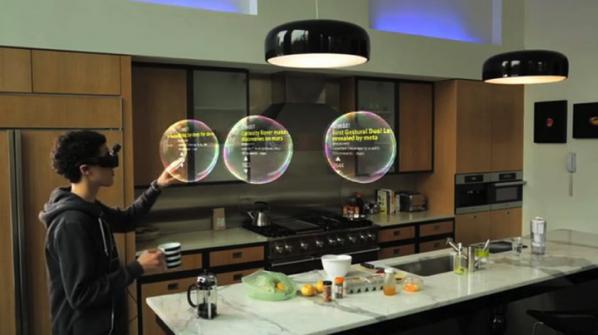
However disruptive events also happen in the evolution of technologies and their cultures. The news was that scant weeks before the conference a leading Augmented Reality Platform, Metaio, was purchased by Apple. Unlike the transparency and expansion experienced by Oculus the Mataio site merely said that no new products were being sold and cloud support would cease by December 15th. In my conversation with conference organizer Ori Inbar we agreed that this was not unexpected as Apple has been acquiring AR technologies, which has been related in rumors of “the crazy thing Apple’s been working on…”; But what was surprising was the almost immediate blackout, part of the subject of my concurrent article “Beware of the Stacks”. For entrepreneurs and cultural producers alike there is a message: Be careful of the tools you use, or your artwork (or company) could suddenly falter in days beyond your control. Imagine a painting suddenly disintegrating because a company bought out the technology of linseed oil. Although this is a poor metaphor, technological artists are dependent on technology and one can see digital media arts’ conservative reliance on Jurassic technologies like Animated GIFs for its long-term viability, but to go further I risk digression.
Another remarkable phenomenon this year was the near-assumption of the handheld as a experience device, and their use seemed almost invisible this year. What was evident was a proliferation of largely untethered headsets, ranging from the Phone-holding Google Cardboard to the Snapdragon-powered (and hot) ODG Android headset, boasting 30-degree field of view and the elimination of visible pixels. In the middle is the tethered, powerful Meta One headset with robust hand gesture recognition. Add in the conspicuously absent Microsoft Hololens and the popular design fictions of object and face recognition are emerging.
That is unless you are a brave early adopter, developer, or enterprise client. The fact that there was an entire Enterprise track and Daqri’s release of an AR-equipped construction/logistics helmet made it clear that the consumer market, much more prevalent last year, has clearly been placed in the long-term. For now, consumer/artistic AR is largely confined to the handheld device, as experienced through Will Pappenheimer’s “Proxy” at the Whitney Museum of American Art or Crayola’s “4D coloring books” in which certain colors serve as AR markers. This isn’t necessarily a bad thing, as an audience is likely to have a device that can run your app through which they can experience the art. As an aside, this is the reason why I chose to use handhelds for my tapestry work – imagine trying to experience a 21’ tapestry with a desktop using a 6’ cord! At this point, clarity and function, both partially dependent on computer power, have created a continuum from strapping your iPhone to your forehead like a jury-rigged Oculus for under $50, to potentially using a messenger bag with the Meta at $512, to the expensive ($2750), hot, but elegant ODG glasses you might try on if you visit the International Space Station.

While discussing the general shape of technology gives a context for its content and application, a media tool is often only as good as its app. Without meaning to show favoritism, Mark Skwarek’s NYU Lab team has been going outstanding work from a visualization of upcoming architectural developments to a surprising proof of concept for a landmine detection system, which I thought was amazing. Equally innovative was the VA-ST structured light headset for the visually impaired, which has several modes for different modes of contrast. These alternate methods not only was surprising in terms of application and possible creative uses but also changed my perception of AR as possessing photorealistic, stereoscopic overlays.
Other novel applications included National Geographic’s AR jigsaw puzzle sets, of which I saw the one outlining the history of Dynastic Egypt. I felt that if I were a kid, building the puzzle and then exploring it with AR would seem magical. There are other entertainment and experimentation platforms coming online like Skwarek, et al’s “PlayAR” AR environmental gaming system. But one platform I want to hold accountable for still being in late beta is the” LyteShot” AR laser tag system, which got an Auggie Award this year. My pleasure in the system is that the “gun” per se is Arduino-based, meaning that it could be a maker’s heaven. It uses the excellent mid-priced Epson headset, but at this time it is used primarily for status updates although there is a difference between AR and a heads-up display. So, from this perspective, it means that there are some great platforms getting into the market that are highly entertaining and innovative, but there are a few bugs to work out.
For the past thousand words or so I have been talking about the industry and applications of AR, but for me, my “soul”, if you will, set on fire during the “idea” panels and keynotes. For example, on the first day, Steve Mann, Ryan Janzen and the group at Meta had a workshop to teach attendees how to make “Veillometers” (or pixel-stick like devices to map out the infrared fields of view of surveillance cameras. Mann, famous for creating the Wearable Computing Lab at MIT and being Senior Researcher at Meta, still seemed five years ahead of the pack, which was refreshing. Another inspirational talk was given by one of the progenitors of the field, and inaugural Auggie Award for Lifetime Achievement, Tom Furness. His reflection on the history of extended reality, and his time in the US Air Force developing heads-up AR was fascinating. But what was most inspirational is that now that he is working on humane uses for augmentation systems such as warping the viewfield to assist people with Macular Degeneration. This, in my opinion, is the real potential of these technologies. In fact this array of keynotes was incredible, with Mann, Furness, the iconic HITLab’s Mark Billinghurst, and science fiction writer David Brin, (who comes off near-Libertarian) gave vast food for thought.
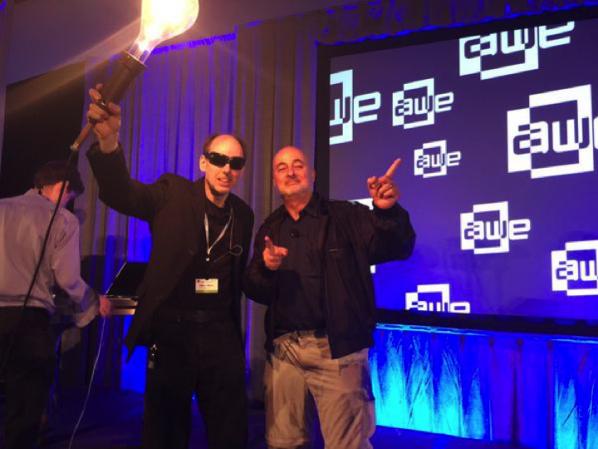
Every year, the Augmented World Expo gives out the “Auggie” awards for achievements in technology, art, and innovation in AR. I think it should be noted that the Auggie is probably the world’s most unique trophy, consisting of a bust that is half naked skull and half fleshed head with a Borg-like lens with baleful eye wired into that head. The Auggie is another aspect of AWE that signals that the world of Reality media is still a bit Wild West.
There are several categories from Enterprise Application to Game/Toy (LyteShot having won this year), and many of them are largely of interest strictly to developers. For example, the fact that Qualcomm’s Vuforia development environment won three years in a row gives hint to its stability in the market, and Lowe’s HoloRoom is a wonderfully strange mix between Star Trek and Home Improvement. The headset winner was CastAR, a projective/reflective technology where polarized projectors were in the headset instead of cameras, which worked amazingly well. The other winners were gratifyingly humane applications such as Child MRI Evaluation and Next for Nigeria (Best Campaign). The prizes impressed on me that the community, or part of it, “got it” in terms of the potential of AR to help the human condition, which is perhaps a “superpower” that the conference framed itself under.
Being that I am writing this for an art community it would be of interest to know where the art was in all of this. The Auggies have an Art category, as well as a gala between the end of the trade show events and the Auggie Awards. The pleasant part about AWE’s nominations for the best in AR art is that those works have integrity. Manifest.AR regular Sander Veerhof was nominated for his “Autocue”, where people with two mobile devices in a car can become the characters of famous driving dialogues (“Blues Brothers”, “Pulp Fiction”, “Harold and Kumar”). Octagon’s “History of London” is reminiscent of the National Geographic puzzles, except with far greater depth. Anita Yustisia’s beautiful “Circle of Life” paintings that were reactive to markers were on display in the auditorium but, besides a Twitter cloud and a Kinect-driven installation, the art was swamped by the size of the auditorium.
The winner of the art Auggie, Heavy & Re+Public’s’ “Consumption Cycle”, (which this writer saw at South by Southwest Interactive) was a baroquely detailed building sized mural of machinery and virtual television sets. I feel a bit of ambivalence about this work, as Heavy’s work tends to rely on spectacle. Of the lot I felt it did deserve the Auggie, purely for its execution and the effective use of spectacle. But with the emerging abilities of menuing, gesture recognition, and so on, I felt that last year’s winner, Darf Designs’ “Hermaton”, employed the potentials for AR as installation in a way that was more specific to the medium.
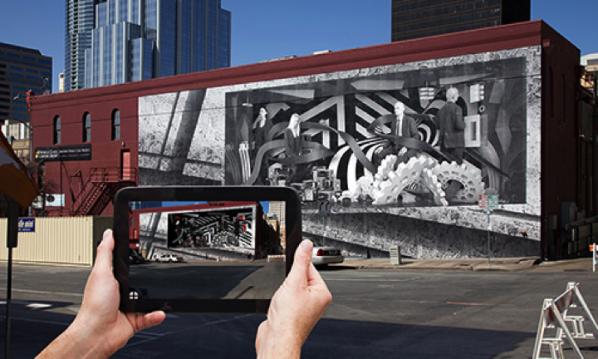
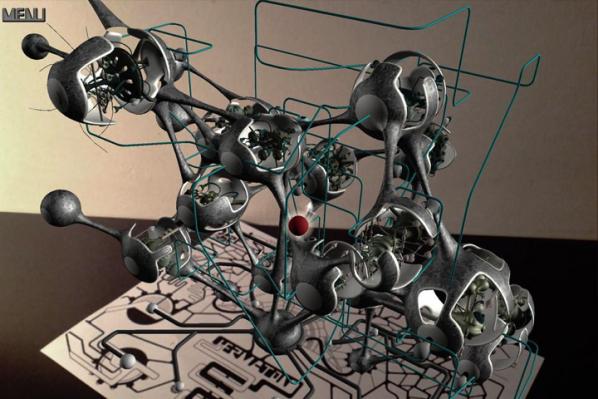
Yes, but it was in a much smaller area than the AR displays. There were standout technologies, like the Chinese Kickstarter-funded FOVE eye-tracking VR visor, a sensor to deliver directional sound, and Ricoh’s cute 360 degree immersive video camera. The Best in Show Auggie actually went to a VR installation, Mindride’s “Airflow”, where you are literally in a flying sling with an Oculus Rift headset. Although a little cumbersome, it was as close to the flying game in the AR design fiction short, “Sight”. So, in a way, the ideas of near-future design and beta revision culture are still driving technology as surely as the PADD on Star Trek presaged the iPad.
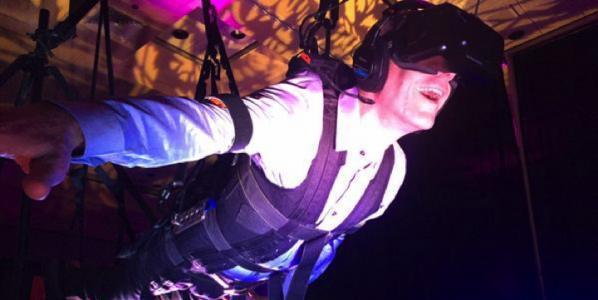
This year’s AWE/UploadVR event showed that reality technology is emerging strongly at the enterprise level and it’s merely a matter of time before it hits consumer culture, but it’s my contention that we’re 2-4 years out unless there’s a game changer like the Oculus for AR or if the Meta or ODG get a killer app, which is entirely possible. So, as the festival’s tagline suggests, are we ready for Superpowers for the People? It seems like we’re almost there but, like Tony Stark in the beginning, we’re still learning to operate the Iron Man suit, sort of banging around the lab.
Leave your money at home and use your personal data to buy, sell, or barter for a delicious range of commodity experiences at the MoCC Free Market. Local residents, park visitors, and online participants are invited to share how they value shopping and trading, in the street, and on their devices. In doing so, you’ll be helping us to develop a radical new artwork for exhibition at Furtherfield Gallery in September 2015. Come along to Finsbury Park and find out more.
Entrance is free on production of a MoCC loyalty card, available on arrival.
Watch out for the MoCC Roaming Marketeer to claim your reward vouchers.
Follow the event @moccofficial and find out more about online involvement.
This event is part of the research and development process for Museum of Contemporary Commodities, MoCC produced in partnership with Furtherfield, and supported by Islington Council, All Change Arts, ESRC and University of Exeter.
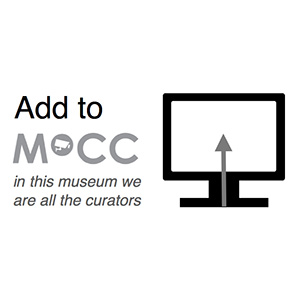
Add your valued commodities to Museum of Contemporary Commodities and help us test out our interaction prototype.Warm up with a Virtual Shopping trip, where you can map and discuss your trade and exchange habits with family, friends and strangers. Find out detailed information on the provenance, materials and trade-justice issues contained within your chosen commodity through a Live Chat with our expert Commodity Consultants. Upload your commodity to the MoCC database, and help curate MoCC in Finsbury Park.

A volunteer-cooked free meal, from the Edible Landscapes PACT kitchen, near to the Manor House gate. Trade your data for a free delivery of your meal, or organise your own pickup free of charge. www.ediblelandscapeslondon.org.uk (Friday only)

Discover your future through the Forebuy service. We will scientifically predict your next most urgent desire and discover in real time which affordable and amazing product is ready and waiting for you. Stop by and discover unexpected treasures from Finsbury Park surroundings whilst chatting about needs and algorithms.
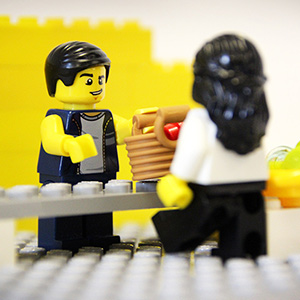
Use LEGO re-creations to turn your data and commodity stories into animated gifs, whilst sharing your experiences of local trade and exchange with Finsbury Park locals.
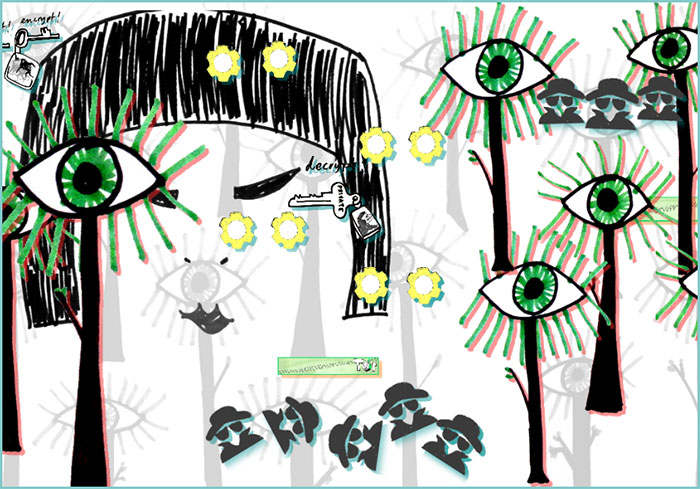
A 3 day event for all the family to draw, make and play online games for the future of the park for the health and prosperity of all…or for total catastrophe. It’s all about the future these days. So take a drawing challenge and imagine a different future. Share your vision and see it turned into free online games to play, remix and share. Developed by Ruth Catlow (Furtherfield) and Dr Mary Flanagan (Tiltfactor) www.playyourplace.co.uk
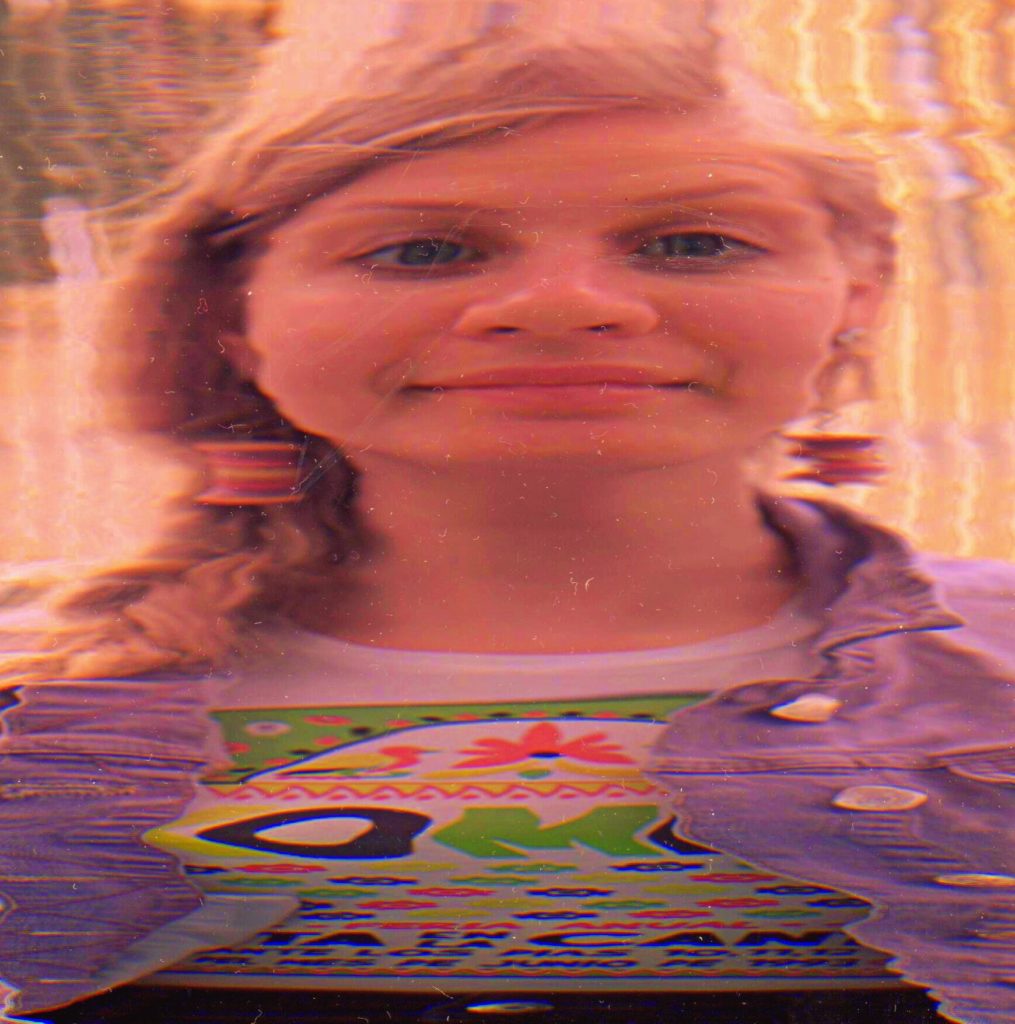
Ever fancied your having your portrait drawn by a street artist? Go one better with our hacked scanner. A truly individualised datafication process, and a great souvenir of the Free Market! Our hacked scanner was built with advice from artist Nathaniel Stern. The stall is being run by Furtherfield artist in residence Carlos Armendariz and Amelia Suchcika. Read more here.
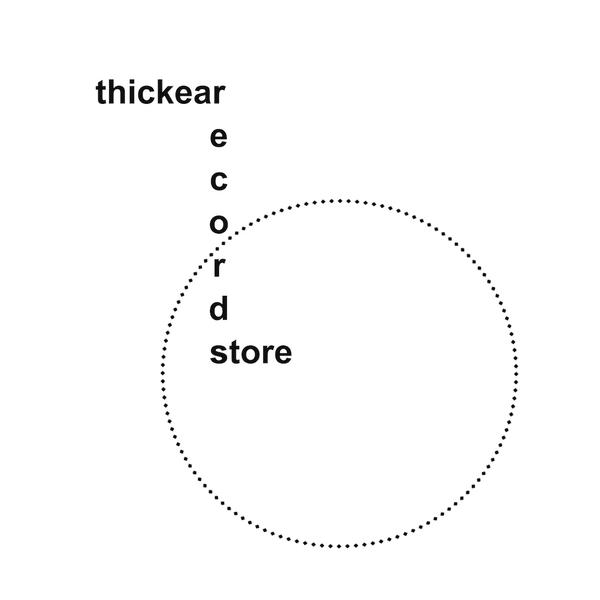
Browse the most up-to-date recordings, release your own records and walk away with limited edition thickear art tapes. No need to bring anything except your personal details – thickear Records Store is a one-stop-swap-shop for exploring current models of currency and exchange. An ongoing series of participation, performance and installation artworks about public transaction, which investigate economies of data exchange and consider how transactions are employed to create value. www.thickear.org

Take a quiz! Match your shopping habits to our detailed guidelines and share your results with your social network.
Park visitors of all ages… Free your office scanner and get your creative juices flowing in Finsbury Park this Summer!
Join us to build a collective portrait of Finsbury Park to be shown at Furtherfield Gallery and in an online exhibition.
With Furtherfield’s artist in residence, Carlos Armendariz, you will create intriguing images of the park with hacked scanners inspired by the Rippling Images of commissioned US artist Nathaniel Stern.
All are welcome, including children with their guardians. The workshops are free but BOOKING IS ESSENTIAL. Click here to book any of these dates:
tweet your images using #wescanfinsburypark
Nathaniel Stern has been using hacked desktop scanners to create beautiful images for over a decade. As part of the exhibition Beyond the Interface – London, he hung 21 large scale prints outside of the Furtherfield Gallery and produced a complete new series of images available online: Rippling Images of Finsbury Park.
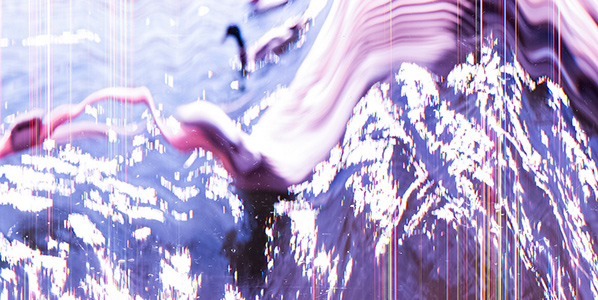
Stern hacks desktops scanners to transform them in portable image capturing devices, and uses them to “perform images into existence”. This process create interesting connections between his body, the scanned environment, and their movement at the time of capturing. Stern himself explained his process in detail in his TEDx talk: Ecological Aesthetics.
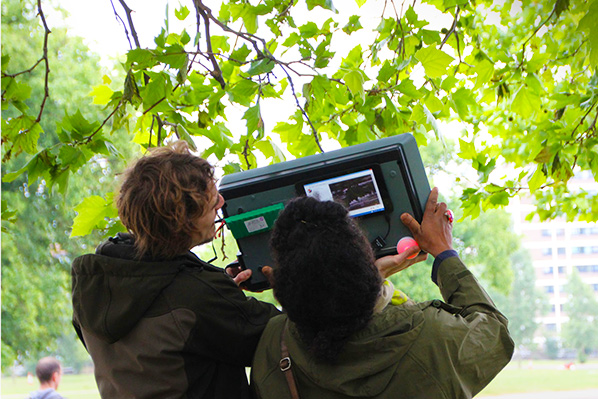
Now Furtherfield Gallery is offering a series of workshops for all ages which will allow the participants to experience Stern’s artistic process. You will learn how to hack a scanner and use one of the artist’s scanners to create your own images. The goal is to create a collective portrait of Finsbury Park and there is a chance to show your work in Furtherfield Gallery.
Furtherfield in partnership with MAT PhD programme, Queen Mary University. Pictures of the workshops by Alison Ballard.
Choose Your Muse is a new series of interviews where Marc Garrett asks emerging and established artists, curators, techies, hacktivists, activists and theorists; practising across the fields of art, technology and social change, how and what has inspired them, personally, artistically and culturally.
Since 1989, Igor Štromajer aka Intima has shown his media art work at more than a 130 exhibitions, festivals and biennials in 60 countries. His work has been exhibited and presented at the transmediale, ISEA, EMAF, SIGGRAPH, Ars Electronica Futurelab, V2_, IMPAKT, CYNETART, Manifesta, FILE, Stuttgarter Filmwinter, Hamburg Kunsthalle, ARCO, Microwave, Banff Centre, Les Rencontres Internationales and in numerous other galleries and museums worldwide. His works are included in the permanent collections of the Centre Pompidou in Paris, the MNCA Reina Sofía in Madrid, Moderna galerija in Ljubljana, Computer Fine Arts in New York, and UGM.
Available as:
– PDF file 0sn-3iexfemiat.pdf (2.7 MB, 206 A4 pages)
– EPUB file 0sn-3iexfemiat.epub (884 kB); Open eBook Publication Structure (Kobo etc)
– mobi file 0sn-3iexfemiat_mobi.zip (994 kB); Kindle (3 files: mobi, apnx, mbp)
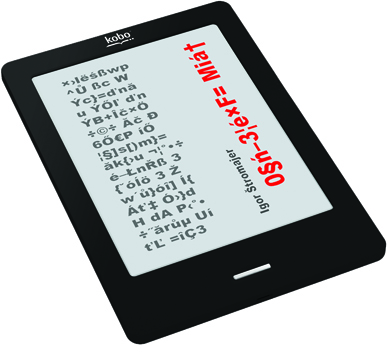
Marc Garrett: Could you tell us who has inspired you the most in your work and why?
Igor Štromajer:Ajda Likar, Aleksandra Domanović, Alexei Shulgin, Ana Isaković, Andy Warhol, Angela Washko, Anne Magle, Anne Roquigny, Annie Abrahams, Annika Scharm, Antonin Artaud, Aphra Tesla, Bertolt Brecht, Bojana Kunst, Brane Zorman, Brigitte Lahaie, Carolee Schneemann, Chantal Michel, Charlotte Steibenhoff, Curt Cloninger, Diamanda Galás, Dirk Paesmans, Dragan Živadinov, Falk Grieffenhagen, Florian Schneider, Fritz Hilpert, Gabriel Delgado-López, Georges Bataille, Gertrude Stein, Gianna Michaels, Gina Spalmare, Gretta Louw, Henning Schmitz, Ida Hiršenfelder, Immanuel Kant, Italo Calvino, Ivan Jani Novak, James Joyce, Jerzy Grotowski, Jim Punk, Joan Heemskerk, Johann Sebastian Bach, John Cage, John Lennon, Jorg Immendorff, Josephine Bosma, Judith Malina, Julian Beck, Karl Marx, Karlheinz Stockhausen, Kazimir Malevich, Lars von Trier, Laurie Anderson, Laurie Bellanca, Lucille Calmel, Ludwig Wittgenstein, Luka Prinčič, Marcel Duchamp, Margarida Carvalho, Maria Winterhalter, Marie-Sophie Morel, Marina Tsvetaeva, Marisa Olson, Marjana Harcet, Marko Peljhan, Martine Neddam, Matjaž Berger, Minu Kjuder, Morena Fortuna, Nam June Paik, Nana Milčinski, Netochka Nezvanova, Nika Ločniškar, Olia Lialina, Peter Luining, Philip Glass, Ralf Hütter, Robert Görl, Robert Sakrowski, Robert Wilson, Robin Dunbar, Ronnie Sluik, Sergei Eisenstein, Simone de Beauvoir, Srečko Kosovel, Stanisław Ignacy Witkiewicz, Stanley Kubrick, Suvi Solkio, Thor Magnusson, Ulrike Susanne Ottensen, Varvara Stepanova, Vesna Jevnikar, Vladimir Mayakovsky, Vlado Gotvan Repnik,Vsevolod Meyerhold, Vuk Ćosić, Yevgeny Vakhtangov.
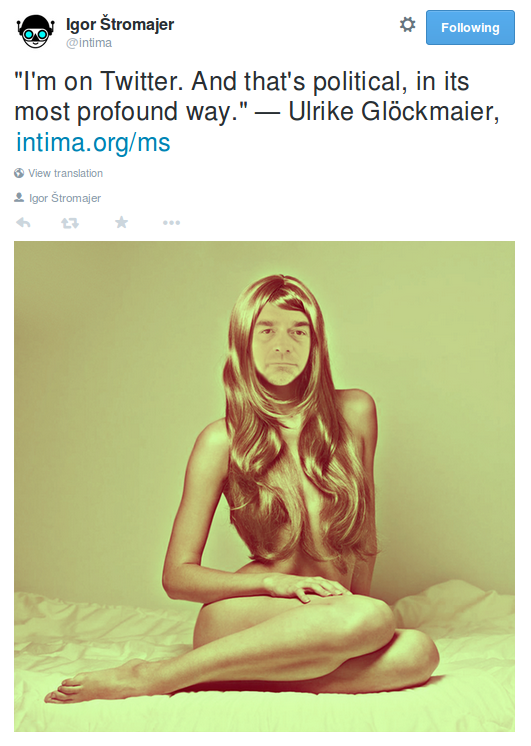
MG: How have they influenced your own practice?
IŠ: ×›lëśßwp^Ů ßc W Ýc}=ďnău ÝŐľ ďnÝB+Îč×Ö÷©÷ Ăč Đ6Ő€P íŐ¦§]s[)m}=ăk{›u ¬¦ °•÷ é–ŁnŘ ß 3 {ˇóĺö 3 Žw´ů}óî] Í{Áť‡ Ó›}dH dA P‹° •÷˝ărůµ U흼 =îÇÉč 駝s™Ý ´Ë5˘şĄ Ű•Ż ěďu pŔ ‚Řw] bűÝ« ď}7» ú9f×Sî “•!«+q ą^őI[}vÝr«ĺn÷ Ľ ÓŰŰ Ż7Ş5g4Ť 0őÝc%ž ›Ź{ zM” ¬¦ °•÷ žl” v:i* p 4®Ú Ws›VęÖ’Fť«M˝ď{Ó¸sëÁäzç} zŻsS§NůŚńŞ%z=t{Ĺź4$ ˇ@ čТ€H) P]e †´B Ćťë®I ďwNë »DîŮ Î2P € Ă@ˇˇ ’Š ¨ iˇ+[ŔĆ 0 ŽŞ…_©2ô†YCHâAĐ ůđ ‰R!h ¨––‚)”˘!i ĆÓI KXµ …\d äPŔ t©’¤6‘ Kď ń˛ ‚ I \l ”Q,Ať „ň [ Because I have nothing to say and I’m saying it. The highest purpose is to have no purpose at all. ] ÉBÜÍ%TD IQNŔ – ¦”bbJv•M € Ä ˛-•H6•J Đspś“ Đť°Ł Ä gl @a Ä Ä cÍ‹˛ˇJ ! cĚäŠGČÄTDM L@PĐÄ ! D&Ĺ9Ť d¦¨§ó„ĚÓQ 튚 ÉC Ô$M Ö=ě ŢĘS÷…O‚ üś ^cFoŃŚ îpPÄ I@Rb bĂHhX™b 4¤i$”dwŰ ž$ .‰˘ ăóy LJSAT QI 7Ž –j(” :Ę‚jż oděG ę®h Ňáo Ăłg K÷ţk D% 9(ö¤řÜ Ľ9B Jí6ő¸n Tvôiő}@8„EO ¬¦ °•÷ bŻý!Ćńě BlÁé [řŤeÚ ‡ »Â ő˙2ľ p6Ř?¨6 Óű;7 ú3 Ś«˛ ŕ8ó ĘŐ@Ř‚˘ĹŞNÎ ž$n:vAňá Ý f ąŮ0 WżÝđ” Ł •ŻŮ vőtĽ Ďg«út’´ž W¦Ś] 0§ń–3¦é×F= ]iᆠ• „ü ¬¦ °•÷ ˙®k ŢyÚŢâ ţ ĂóJUţŮ ä …˛” 9Ů ţ˝Ó{ Ě›9ôĚŕ Š¸·fˇµÁP¸ş Dşź ´ľtÜŢ ŻŇĽ· 瀝,& ëÄŔ´DőJň% &–<VĐlŃ fű.Q |đjË DľŠ ×zr|-ú=÷8 BµÂ muŃ xĹžK ” yáüŃťdÚ°T ş ÖötË śîzl ÂI \o˝‡Ă ˇ n+„’ ¬¦ °•÷ 3 z Ŕˇ™ Úp ‘ZpĽHťĂż‹~ Ę,Ńů Šr!CćX Ěď{† –Ćľ E5‡0 Éž@ss 3 łá” 3Ďk¨nŃ×ĆëŁ ;=Š”t-ŻÓAd% [ Đ@{×űX2E , Y ŕ
Could you share with us some examples?
IŠ: ´Ą˙ pÇꯗ ž^Çš ´źw ey€©× ś˙…Ă@{ˇ\wě„á Łźhµ h÷ýŞ38ŕ 4(â‰yD @úD ®ÜÓŽŢ}” .. óDm ˙YĎă ]. B ÍT6¨S Hh…og“mS~ÍÖθŐZ» ŔťŢ¦Ř7 aŔ ”€Ł ÚKîýŚ‚ óíŃđ?Ą.±{ răö ”±D6á=ˇ Ă×Ö ď7Aą CŰś˙K ŰË&hË`Çĺ – ééërm ćÇ1ý mźŰiţIÇż–:(ěč“~śpó; žč ¦ë 0§ń–3¦é×F= Miᆠ¬¦ °•÷ ƱÝŃ |lŤé ˘ 3 OĆ VW° )»VępŇ› nŹÇŃť E—`Qt &ëú!=JŁ±`>EL ŹK Ô2 ¬¦ °•÷ CT N ö´HU ĂÎ cŽ ńű…a Q ¬¦ °•÷ QŕAĐ- ś Ý} Š*†Ľfٟʉ ŔŽ O”‡ž j xkĚ宋$w5]Ś»˙Ö]Ń€ Ôá~‹<A¸ěÂrD „»’† ( ”ń Nşţç [µ`.Ő1X¨Ź(ßżo]ťV š Ě, …ÖÜ A˙ ł Í 0§ń–3¦é×F= ]iᆠâ.Ůs_ p!VSf|r0 ě E ó÷ ·Vľ ;ń < ¬¦ °•÷ q T~ň3Ű…üTs Ínű·?Ş ©aKŠ1ŰĄkĚmąĎ;·? Ž Ź J,6 -ľŇH°¦Y˙7y= =Q _™Z Můě Uů÷I˙˙+÷…ś{÷ *Ű…¦¬ţ¬A@n8•Š •°Çč©hD ˙áď Ë Ý @=*˙ IuvÇ tčCúN™Ŕalĺ÷ ÷ě(pr °éĄ¦sÎ%¬¦ŕ «X6 ű¬ $P•M(Ô÷Ĺi%wńB [ For example, I don’t want it to be essentially the same – I want it to be exactly the same. Because the more you look at the same exact thing, the more the meaning goes away, and the better and emptier you feel. ] Ĺ1OŮŔ „6S§R4 Jú`Y¬ ÷ č«. 幀)H 28ł†Ve€@.]qT* ľ H} ¦wč¸s† Ŕ˝U}µ ô d7u•Ý’Ž H1ÓÔ z°Zý C €Z¸¦në szë Ö +° ˙˙¬˙g‹˙íö ”Ţ * úx ‚Ë®÷6l°) & b•*^ ŞTˇ@4@ Š»˙I˙>! BK °9 č Í Ő˙@®¬ń z° Ź önď» >Ş •:” ¦ś¬ RF ‚* ę¨ eR€ p€ _•”Nę ˙ű¸h) “$ŮŔ ÎBwA¬ ú ‚ĹZ`ˇHTĘ°R ť•ťA¤zçM÷ •)É ô0 ¦ îIű ®¦˙ú÷yĄ›PĐşŕŐ – »´ [RY 1Ńđ ´˛ > 3˙? } Ő” Š ’ ” fE9 ”Őnş^>Hn˙©° Ě˙JHŽş =§ÝĂ »=nMŹ€ ÷ µH Đ$K”i P ”™É 9Îos„Xô…ó ¬Ó›Pđ}7n 7 ›SOü‰ T ť)ťśďsďŤ ¬HRSc ÷ŔĆńěŐ:ëcŻ°.Ý !ůIi Ćş˘ ‚•9ú‚ ,ˇR €©]VŘ Ű• gÁ” ő™ÓŮ˝)ˇÍŐQ î©ö¨t ˇv@î@c J®‚Aä‹ß ‘j2Ű]nJ› ˘Ů…ĽŁIu•iP ^P ĆQ«I0=Ű$ń Č NtF´«@’¤ ‚z Ŕ…6 ă[ë žĂÄ îßbK Š˝śĺ ’DíŁ“ I î˘ CÁB5b ¦ÓÎ÷˘HfŞťăSęž+ßBž©ă{Ô wTw)b!ěiA¨W$ ®Xˇ– Mčp Úľc 4‡¬^ \妯 Ždzč –A H “b•lS ď ďůÍ@dsŰMP Š¬Ü”óC¬4w čĘä[Le ›}ds}ď ť ďJĹĉ°lďĹP{î ň{Şné «” &ç ś]!{ 6•µëu„H\-=Ż{3 bhŢ%F}d +Ą Śp hsmYI Ö]”Ó+ š «pŠ} 5ťŃ–é¨×pĚuä3 ĦÓ_ëóÝ=Wv´Đ§ Ý Ö×ő Žw” ŽB4ÝĐŐŘ AÉM Uˇ4DD ¸¦bÍ Ť w† ťQÄ â÷‹daÝ»––r ˛2Đ%Ŕ[I Đ Ä P}r§{z‘• cË› ×†Ş ´ °ůy TÄű*Â@^•N !ůsL z0lÉ}dIÖÝÄpJ €äíĐ Q Ś6 %Ľź÷$lv€Gócą(Ě •° ˇq¦Ŕ÷˛kčăÇ ÷§ť7 N!g ˛Mí =
MG: How different is your work different from your influences and what are the reasons for this?
IŠ: íş9č ĆW„oő lĘ pŽ3ćhŹ+¬r-ţ-AµÖ MńúćŐ6 ¬¦ °•÷ ’ ŚścՀŦ5Qe‘ďť*â@ť†v Őý vŮ ĺ ęJó]s ±1Śu @yŤ .1ş6dnµ yź]ŽuôŤ -ŻNE\± Ë9Ť}Ű č>†zž úŁř G6 𫡏 ‰ 5Ď9?:’E·xýćđ) \^Ł×ĺ(‡Bq }rM RQÓ›6 ę4_uvB´ lŰ6áH‡ { Š¬râ ´ [ Therefore I have no special message. I wish I did. It would be great if I had one. ] Qłë ©űiŇšpý–—`s§ !“9“Ř ‡łRˇ˘OÚy™9ľŻ bčw ă- -pń÷b ´ŽŇ VT oP»Őč„ ‰ ÎŘ`lăß űW §7ŞŘË caŔbýVťŘ ż‘„ć d% AK RPĐQ C ĐK, T´S Ó0T CL SăËDЉ(¨Ş*iHMŘŕ+vf?1™=QŮý̧5× +Bé:&ĘË ügŃc’µĄ (`° ‹ Ćő˝ţ9łXü ôĘČX µň ‚’Äí ¬¦ °•÷ ‰ëľ ś ň٠ߢVJfg‡!} ˛_ 2“9(ĄK! % yńNąvg ×áäěČ éżOX N ¬™ů¨ }‘« šŮ¨ óá nńxăĹ Ţo ®( ‚ Ó Oů‹Łk c ą¦( qT°€qWc 3 ćp
MG: Is there something you’d like to change in the art world, or in fields of art, technology and social change; if so, what would it be?
IŠ: üć»w+űe7 Ö®» y»ËăĺăTA© A¨ŽŇ‚i LY `B ż ™{d ]( !äßŰăËmńl›Y9Űí¬í3a5T @T o uf čT> 3 ^ =–vŮQ E˘¸…t0Ë î„Îy Ş{,žX×TU [ Yes. Nothing. ] ÜwŢńg&XhűÍ-…] !)+ÝĚVŕ ®ćŢĽ ¬¦ °•÷ YągŃ ]ݔ⠥@6<‹tr ¬¦ °•÷ ©±¨ Ŕ»&RŐÖQ ”% —ĆŁ{ ¬¦ °•÷ ë~ ._ć şřk ş÷© ,°–śÇoĂ›ű ýď˝ç _´p+ŚÖđ5 śZőXßÇ ň>KqĚé˙ ܇ Ę,| ©‘ ü,ź± 9»1Áµ y(m$ tÉ’ ĚÂM©Ç u˛č¨z }´s÷ĺż^
MG: Describe a real-life situation that inspired you and then describe a current idea or art work that has inspired you?
IŠ: Ń´j qď OĐîť% ßŰűxËýż OçżěoÓíŮËĚ˙ ő3?ôoŐĺÜ 4ň2Ëe Űą“Űżž äżôÝ ˙fAş]Ď ]Ů8ĘZ ‡“ľ _¦÷\9Á· WŰ©:jiď Ů\3ĂŮ o$ý\S|vy´ćîý úy…›¬Żę} 6m”ˇ> ‰—Đ7 Ő.™ ţľĎ§ę_WćĆw.& Ŕ·§ ~Đ 1ć ‘ ĚÇ« ¬(`¤ gőđĘĺv ţÍ ¤‚¨Ź éOŁ [ She said: “Make your own art. Do not expect me to do it for you.” ] S=•üĎVz˙ Ľ‚;z‡—xľ€J,?HóŹg¦ ľ˙ňö3ůvFĐľˇŰIa RřG A =qż?AĘ˘Ř v€D·öĂXŠ! ÷äŁ\u@U ‘ KŽ‚żB„ ŔŮQ.c‹ }9€×éĺŠ÷ů(8×Sł·¬ Y+ćĽĘ> ¨mű8°@‰%ó5 ŃĹXoňOźŔ y˙Môu ®^Dxrő áĂgwý l¬au%}‰Ě: ˙ ßČ HGPŇŃ—Dď×Ď ĎdJ› } ‘Ń@ Bu_č ôuKŘăĂóŘ ×ŠŇ(xşµ»ŐŞČ: b \[ŽAü”űđé´{ emsó|Ń‚xăö9 x: ˇoťŞřĺńta ŞĺŹË ÖŰĽŰ (:Šké í ‡Udl=Tż ‚: 3 ó]5č¦×Hsśww· ľ‰0ů t®Üqčř đ1X úI2¦ $Ýj& 3ÁśIëďą {uŐÝ
MG: What’s the best piece of advice you can give to anyone thinking of starting up in the fields of art, technology and social change?
IŠ: °§s© ;źĆÝČ ÉůąÚ- ď]™@ Ľat•Îňc}ľ o,ú˛đ ÷Žă ÷sýqŐ«AŻ7őúWB 3 ‘ Ľ Öůxńľ ¬¦ °•÷ _µÎ ·k y·8[ ä®î¦<8}Ť4ť űfÖY †‡tŕ m۵đ [ Make love, not art. ] ź©Xrôw»´sŘîćî ¬¦ °•÷ ‡Ó‹ăHŰ˝tn ňtë+O ća¬7 TvÇĄ ż,ľ} ř[« Č< ľn
MG: Finally, could you recommend any reading materials or exhibitions past or present that you think would be great for the readers to view, and if so why?
IŠ: With pleasure.
Kant’s Critique of Pure Reason is the key text for the understanding of everything.
BodyAnxiety.com, curated by Leah Schrager and Jennifer Chan, is the exhibition everyone would have to see in details.
Still remember Cornelia Sollfrank’s Net Art Generator? Here it is: http://net.art-generator.com
And if you already forgot everything about Jonas Lund’s exhibition in MAMA – The Fear Of Missing Out, 2013 – you need to refresh your memory: http://jonaslund.biz/works/the-fear-of-missing-out
J. R. Carpenter reviews A Geology of Media, the third, final part of the media ecology-trilogy. It started with Digital Contagions: A Media Archaeology of Computer Viruses (2007) and continued with Insect Media (2010). It focuses beyond machines and technologies onto the chemistry and geological materials of media, from metals to dust.
Humans are a doubly young species — we haven’t been around for long, and we don’t live for long either. We retain a fleeting, animal sense of time. We think in terms of generations – a few before us, a few after. Beyond that… we can postulate, we can speculate, we can carbon date, but our intellectual understanding of the great age of the earth remains at odds with our sensory perception of the passage of days, seasons, and lifetimes.
The phrase ‘deep time’ was popularised by the American author John McPhee in the early 1980s. McPhee posits that we as a species may not yet have had time to evolve a conception of the abyssal eons before us: “Primordial inhibition may stand in the way. On the geologic time scale, a human lifetime is reduced to a brevity that is too inhibiting to think about. The mind blocks the information”1. Enter the creationists and climate change deniers, stage right. On 28 May 2015 the Washington Post reported that a self-professed creationist from Calgary found a 60,000-million-year-old fossil, which did nothing to dissuade him of his religious beliefs: “There’s no dates stamped on these things,” he told the local paper.2

In the late 15th-century, Leonardo Da Vinci observed fossils of shells and bones of fish embedded high in the Alps and privately mused in his notebooks that the theologians may have got their maths wrong. The notion that the earth was not mere thousands but rather many millions of years old was first put forward publicly by the Scottish physician turned natural scientist James Hutton in Theory of the Earth, a presentation made to the Royal Society of Edinburgh in 1785 and published ten years later in two massive volumes3. It is critical to note that among Hutton’s closest confidants during the formulation of this work were Joseph Black, the chemist widely regarded as the discoverer of carbon dioxide, and the engineer James Watt, whose improvements to the steam engine hastened the Industrial Revolution in Great Britain. Geology emerged as a discipline on the eve of a period of such massive social, scientific, economic, political, and environmental change that it precipitated what many modern geologists, ecologists, and prominent media theorists are now categorising as a new geological epoch, the Anthropocene. As Nathan Jones recently wrote for Furtherfield: “The Anthropocene… refers to a catastrophic situation resulting from the actions of a patriarchal Western society, and the effects of masculine dominance and aggression on a global scale.”4
In his latest book, A Geology of Media (2015)5, Finnish media theorist Jussi Parikka turns to geology as a heuristic and highly interdisciplinary mode of thinking and doing through which to address the complex continuum between biology and technology presented by the Anthropocene. Or the Anthrobscene, as Parikka blithely quips. In putting forward geology as a methodology, a conceptual trajectory, a creative intervention, and an interrogation of the non-human, Parikka argues for a more literal understanding of ‘deep time’ in geological, mineralogical, chemical, and ecological terms. Whilst acknowledging the usefulness of the concepts of anarachaeology and varientology put forward by Siefried Zielinski in Deep Time of the Media (2008)6, Parikka calls for an even deeper time of the media — deeper in time and in deeper into the earth.
In Theory of the Earth, Hutton referred to the earth as a machine. He argued: “To acquire a general or comprehensive view of this mechanism of the globe… it is necessary to distinguish three different bodies which compose the whole. These are, a solid body of earth, an aqueous body of sea, and an elastic fluid of air.”13 Of the machine-focused German media theorists, Parikka demands – what is being left out? “What other modes of materiality deserve our attention?”7 Parikka proposes the term ‘medianatures’ — a variation on Donna Haraway’s ‘naturecultures’8 — as a term through which to address the entangled spheres and sets of practices which constitute both media and nature. Further, Parikka reintroduces aspects of Marxist materialism to Friedrich Kittler’s media materialist agenda, relentlessly re-framing the production, consumption, and disposal of hardware in environmental, political, and economic contexts, and raising critical social questions of energy consumption, labour exploitation, pollution, illness, and waste.
Drawing upon Deleuze and Guattari’s formulation of a ‘geology of morals’9, Parikka writes: “Media history conflates with earth history; the geological materials of metals and chemicals get deterritorialized from their strata and reterritorialized in machines that define our technical media culture”10. Within this geologically inflected materialism, a history of media is also a history of the social and environmental impact of the mining, selling, and consuming of coal, oil, copper, and aluminium. A history of media is also a history of research, design, fabrication, and the discovery of chemical processes and properties such as the use of gutta-percha latex for use the insulation of transatlantic submarine cables, and the extraction of silicon for use in semiconductor devices. A history of the telephone is entwined with that of the copper mine. How can we possibly think of the iPhone as more sophisticated than the land line when we that know that beneath its sleek surface – polished by aluminium dust – the iPhone runs on rare earth minerals extracted by human bodies labouring in deplorable conditions in open-pit mines?

Jussi Parikka is a professor in technological culture and aesthetics and Winchester School of Art. Although his his definition of media remains rooted in the disciplinary discourses of media studies, media theory, media history, and media art, he advocates for and indeed actively engages in an interdisciplinary approach to media theory. He cites a number of excellent examples from contemporary media art, not as illustrations of his arguments but rather as guides to his thinking. He also draws upon a wide range of other references from visual art, science, literature, psychogeography, philosophy, and politics. This overtly interdisciplinary approach to media theory provides a number of intriguing openings for readers, scholars, and practitioners in adjacent fields to consider. For example, Parikka’s evocation of Robert Smithson’s formulation of ‘abstract geology’11 in relation to land art invites further explication of the connection between land art, sculpture, and the geology of sculptural media. For thousands of years sculptors have practised a geology of media, making and shaping clay, quarrying and carving stone, and smelting, melting, and casting metal. Further, Parikka’s discussion of the pictorial content of a number of paintings in the context of this book invites the consideration of the geology of paint as a medium, entwined with the elemental materiality of cadmium, titanium, cobalt, ochre, turpentine, graphite, and lead.
Media is a concept in crisis. As it travels across scientific, artistic, and humanistic disciplines it confuses and confounds boundaries between what media is and what media does in a wide range of contexts. This confusion signposts the need for new vocabularies. If geology has taught us anything, it’s that this too will take time. In endeavouring to explain how it happens that flames sometimes shoot out through the throat of Mount Etna, the Epicurian poet Lucretius (c. 100 – c. 55 BC) wrote: “You must remember that the universe is fathomless… If you look squarely at this fact and keep it clearly before your eyes, many things will cease to strike you as miraculous.”12 So too, Parikka prods us to think big, to get past our primordial inhibitions, to look beyond mass media consumerism to what I shall call a ‘massive media’ – a conception of media operating on a global and geological scale. A Geology of Media is a green book, overtly ecological. In his call for a further materialisation of media theory through a consideration of the media of earth, sea, and air Parikka has put forward an assemblage of material practices indispensable to any discussion of the mediatic relations of the Anthropocene.
This Symposium aims to bring together a range of practitioners from the Performing Arts and theorists, including those involved with, but not limited to, dance, music, opera, theatre, magic, puppetry, and the circus. To discuss issues and opportunities in designing digital tools for communication, artistic collaboration, sharing and co-creation between artists, and between artists and actively involved creative audiences.
There are numerous existing online platforms that provide immediate and easy access to a vast range of tools for creative collaboration, yet their majority create and maintain networks within a ‘noisy’ social media environment, are based on a centralised model of collaboration, and are built on corporate infrastructures with well-known issues of control, identity, and surveillance.
Focusing on the Performing Arts, the symposium will take a bottom-up approach on how to design online collaborative tools without the noise of social media, drawing on peer-to-peer decentralised practices, infrastructures for building communities of interest outside the imperatives of corporate control, developing new kinds of narratives and synergies that add depth to artistic practice, blurring the distinction between artist and audience. We will discuss about what participation, collaboration, and co-creation means for the performing artists and their audiences in an online networked world and bring to the dialogue the needs, expectations, desire, aspirations and fears of working online collaboratively. We will identify, articulate and discuss artistic, social and design issues and opportunities, analyse existing projects and current practices, experiment with ideas and concepts and visual designs.
In brief, the symposium’s goals are:
The insights of this workshop will provide the base for a second, multidiscplinary workshop that will bring together performance artists and creative technologists and coders and whch will take place on the 14th July 2015 as part of the British Human-Computer Interaction conference at Lincoln, UK.
http://designdigicommons.org/http://british-hci2015.org/participation/workshops/
Walkshop, making session and drop-in day
Come for one or both sessions, or just drop in for a chat about MoCC over tea and cake.
11am-1pm – Data Walkshop with data activist Dr Alison Powell (LSE)
Explore and discuss the data surveillance processes at play in Finsbury Park through a process of rapid group ethnography. Arrive from 10.30am at Furtherfield Commons for a short introduction to the project. We will leave at 11am for a 60 minute walk around the area followed by snacks and discussion. Please bring:
BOOK HERE (places limited to 12 on a first come first served basis)
2pm-4.30pm – Making session: LEGO Re-creations & Interactive Posters
Work with Cultural Geographer Dr Ian Cook to turn your commodity stories into activist LEGO re-creations. Inspired by Nathaniel Stern’s hacked scanner, artist Carlos Armendariz will help you translate your data findings into visual events. Produce arresting images for an interactive poster for public display, then track and count its impact.
You are welcome to bring your own smart phones and computers along.
BOOK HERE
This event is part of the research and development for the Museum of Contemporary Commodities, an art and social project led by artist Paula Crutchlow (Blind Ditch) and cultural geographer Ian Cook (Univeristy of Exeter).
More info: http://www.moccguide.net/
Choose Your Muse is a new series of interviews where Marc Garrett asks emerging and established artists, curators, techies, hacktivists, activists and theorists; practising across the fields of art, technology and social change, how and what has inspired them, personally, artistically and culturally.
Mike Stubbs became director of FACT (Foundation for Art and Creative Technology) media arts centre, based in Liverpool in 2007, just before Liverpool’s Capital of Culture year. The centre offers a unique programme of exhibitions, film and participant-led art projects. He views the organisation as to be cutting-edge of art and new media and one of the jewels in the crown of Liverpool’s ongoing cultural renaissance.
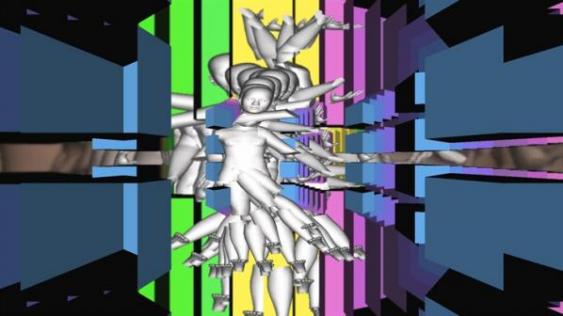
Stubbs has worked as an advisor to the Royal Academy of Arts, The Science Musuem, London, Site Gallery, Sheffield and NESTA (National Endowment for Science Technology and Art), ACID (Australian Centre for Interactive Arts) and the Banff Centre, Canada. He has been Production Advisor to artists such as Roddy Buchannan, Luke Jerram and Louise K Wilson.
Trained at Cardiff Art College and the Royal College of Art, Stubbs’ own internationally commissioned art-work encompasses broadcast, large scale public projections and new media installation. In 2002 he exhibited at the Tate Britain, 2004 at the Baltic, Newcastle, 2006 at the Experimental Arts Foundation, Adelaide. He has received more than a dozen major international awards including 1st prizes for Cultural Quarter, at the 2003 Echigo-Tsumari Art Triennial, Japan, WRO Festival, Poland 2005, Golden Pheonix, Monte Negro Media Art Fest 2006. In 2003 he was awarded a Banff, Fleck Fellowship.
Marc Garrett: Could you tell us who has inspired you the most in your work and why?
Mike Stubbs: Uncle Islwyn Thomas (deceased) who told a barman to bugger off in Welsh for not serving us (age 14) – It made me realise one could object.
David Nash. I was lucky to have a chance visit to his studio (chapel) when I worked in Llechwedd Slate Mine Craft shop, Blaenau Ffestiniog. He persuaded to save up for a Kawaskai Z650 in the future and not to be a paint sprayer and instead, go to art college (circa 1976…), and that being an artist was a viable alternative.
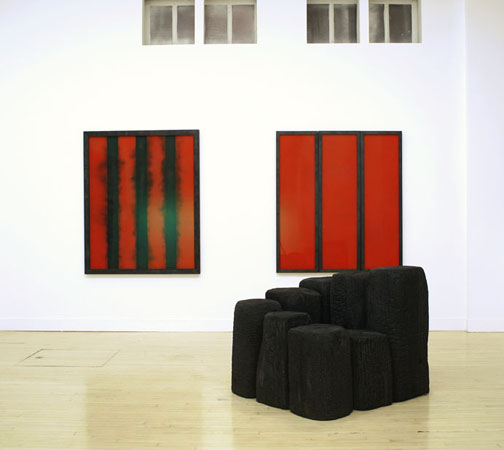
And Krzysztof Wodiczko, I saw his Cruise Missile projected on Nelsons Column in 1985 and then him swivel the projector and project a swastika onto the south african embassy in response to Margaret Thatcher donating £7 million quid to PK Botha government – big slap in the face to the anit-apartheid movement of which I was part (Greetings From the Cape of Good Hope can be found here, http://mikestubbsco.ipage.com/artworks.html)
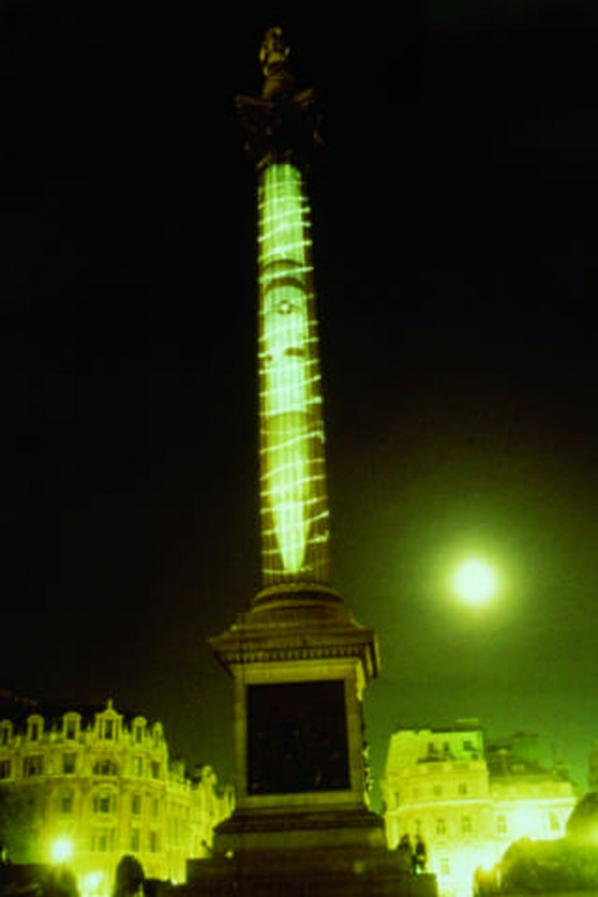
MG: How does your work compare to those who’ve influenced you, and what do you think the reasons are for these differences?
MS: With age I’ve tempered the urge to object to too much and post election, I feel like I’m from another planet. Workwise, I’ve been priviledged and lucky to build support within the public sector for arts organisations which have maintained some edge (Hull Time Based Arts, ACMI, FACT). Recently very proud to have produced Group Therapy, Mental Distress in a Digital Age, which is both critical and a form of social activisim. I am lucky to have collaborated in developing festivals including : ROOT and the AND (Abandon Normal Devices) which have created more room to commission and present a risk taking program.
MG: Is there something you’d like to change in the art world, or in fields of art, technology and social change; if so, what would it be?
MS: That longer term agendas might accept that risk and experiment are needed and that Art IS innovation and that more people from non-art backgrounds get a chance to experience and make art.
MG: Describe a real-life situation that inspired you and then describe a current idea or art work that has inspired you?
MS: Watching on TV a flood victim being rescued by helcopter and dropping her entire belongings. And Hseih Teching’s One Year Performance.
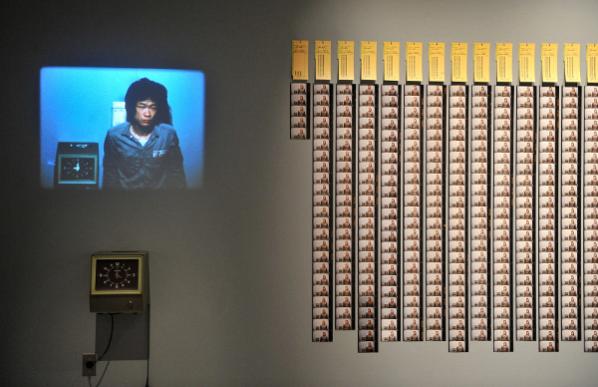
“Tehching Hsieh’s work, informed through a period spent in New York City without a visa, experiments with time. He was actively ‘wasting his time’ by setting up a stringent set of conditions within five different year-long performances. The driving force for an individual to perform such extreme actions must surely be the ultimate cipher for being emotionally, psychologically touched – and that, ultimately, is a gift. His work poses the question: as humans how can we afford not to be touched?” [1]
MG: What’s the best piece of advice you can give to anyone thinking of starting up in the fields of art, technology and social change?
MS: Do what you feel like. Dont copy others
MG: Finally, could you recommend any reading materials or exhibitions past or present that you think would be great for the readers to view, and if so why?
MS: Post-humous papers Robert Musil, they continuously speak to me at the most fundamental level and with wit. http://bit.ly/1PYIq6A
Diamond Age Neal Stephenson. Inspired the idea of democratising interactive media. http://en.wikipedia.org/wiki/The_Diamond_Age
Art of Experience John Dewey, a bible of ideas to re-frame arts and culture – first citing the term ‘impulsion’ – http://en.wikipedia.org/wiki/Art_as_Experience
The City and the City, China Meilville. It inspired our exhibition Science Fiction, New Death at FACT. It elegantly suggests how we simultanesouly occupy the same political, social and physical spaces despite difference.
Featured: Toast McFarland
Synthetic bodies, mediated selves. What themes become relevant in a technoprogressive world – as objects proliferate, what do the inundated people talk about?
You are alone, at a computer. You talk to people but they are not around. There is no bar, no village square, no space in which you speak. There is your device and your physical presence. The social location is your body and its interface with the communicative device. What is the language for landscapes which can’t be seen, and yet which predicate subjectivity?
You express yourself. You are certain state statistics, a resume, you are a myspace profile long defunct. We require your legal name. Certain cards, from when you were born, from when you became qualified to drive, define you, make or break you. You are an ok person provided your paperwork is in order – morality is preceded by bureaucracy.
What’s the relationship between a legitimated self and that person’s body? The more modes of documentation we have the greater possibility for fictional aberration. The disparities between someone’s situated life and the records which make up their memory proliferate.
The image above by artist Toast McFarland was taken in a cartoon world. It is a selfie, a socially streamed validation of presence, but it is also a meticulous reframing of that practice. Everything is subtle, deceptively common, and yet the composition is entirely irreal. Flat colours, almost abstractly plain costuming, this is what happens when a vector world invades your computer room. It exists between personal expression and the self as actor within the surreal.
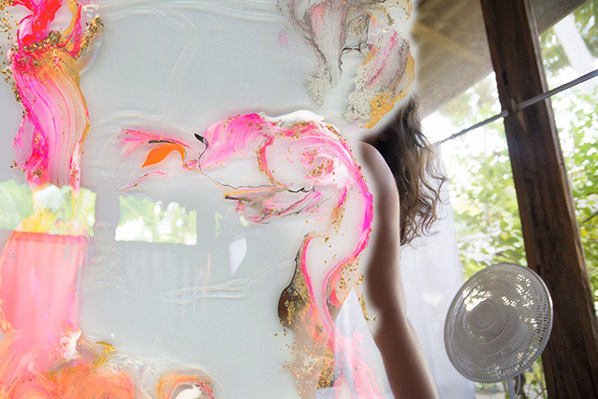
Leah Schrager‘s modelling-inspired self-portraits covered over with bright streams of paint. The model image professionalizes the act of self-representation in image form. In the profession there are industry demands – self-validation may be about confidence and friendship, where industrial success might tend towards epitomization and abstraction. Are you a good model – do you meet the sexual and aesthetic demands of the collective consumer unconscious? Schrager’s work combines a toying with such psychological implications with a background in their material underpinnings – the body in dance, the body in biological study. This combination allows for work and commentary that penetrates the relationship between the vessel you are indelibly given and the psychological relationship it develops mediated for oneself and a public.
Do you view Schrager’s images out of an interest for her or for the type of beauty she represents? Once the image is painted over, is there any interest left? Through different personas, she delivers these in a variety of web contexts, each time asking us to reconsider who we’re looking at, and who we are to look.
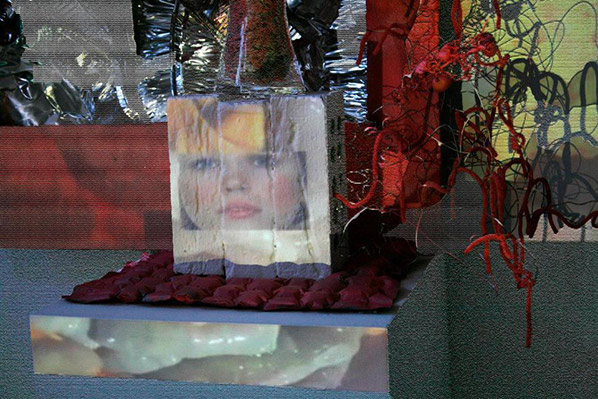

Screens, correspondents, professional speakers. We are happy to take your call. These two screenshots are taken from two videos by media artist Aoife Dunne. Both combine a juxtaposition of found broadcast footage, the enveloping commercial TV world, and her own crafted filming sound stages. They are installations, videos, and imagist combinations that take our question of the self directly to the media world. In the second, Dunne acts directly over top found footage, performing as doppelganger of the telemarketer in the projection. Her simultaneously comic, retro and coolly provocative aesthetic places her into an 80s infomercial dream world. She acts her own fiction, the selfie is the superlative thought experiment, and yet the proliferation of doubles buries her subjectivity in an imagined space of marketed image sheen. In the first work we only have a double, and Schrager’s biological world is fleshed out and externalized. This is what you really look like. Dunne’s own medicalized outfit says that this telecommunication is also a biological translation. For your image, we need your face, but for your face, we need organs and cells. Between the public and economic demands of the screen, and the material demands of your body, where are you?

Dafna Ganani‘s work, through a combination of images, code, social internet art and theoretical reflection, gives us an exemplar of how self-representation meets technical distortion. Her own performative presence proliferates in her work, yet always accompanied by animations, entire interactive worlds complicating any personal space. In this image, self-reflection is directly addressed – at first glance it mirrors what is represented but on closer inspection nothing of what that would look like quite match up. Where are the dragon head things located, where is she, before and after mirroring – the almost comical comparison is undermined by a disquieting sincerity. She appears intent on knowing where she is, however much the dragon doesn’t have her best interests in mind. And the right hand, reaching into the animation cloud on the left, nowhere to be seen on the right.

Dunne’s world of media culture screens is made specific and celebratory in Georges Jacotey‘s self-portraiture as Lana del Ray. An internet performance artist whose work explores media culture and self-image, the picture’s combination is both nearly seemless and parodically collaged. We all participate on some level in commercial culture, but we can never admit it. We might genuinely like aspects of it, we might hate aspects – but the popular bent of this culture means that as long as it is pleasing to a common consumer base it will gain a cultural existence. You know so much about iconic entertainers you never asked to know about. Jacotey takes on this conundrum, joins in on it, participates – what if instead of merely liking a celebrity, you seek to emulate and become them? Some people like del Ray’s albums, Jacotey’s the one who sang them. Capitalism asks that you buy, what if you take the role to sell? Human images make for great products, before we make the necessary transactions let’s make sure we know how to transform ourselves into them.
Good self-representation requires good media savvy. Before you think about your online identity simplify the process by becoming a celebrity. They’ve already figured out all the questions of the self in society – the right names, dress, mannerisms, the right look. Everything is acceptable, everything is inspiring, nothing is quite familiar.

Rafia Santana further draws out Jacotey’s comparison of the celebrity image and the selfie. Two different trajectories are taken up here – one is to deconstruct the fictions of the “real celebrity image”. The second is to fictionalize and play with one’s own portrayal. The result is layered, offering multiple points of entry for both observation and critique. If the digital image is just bits and bytes, what happens to ethnic history, to situated lives and experience? Putting herself repeatedly in her own work, Santana asks the basic question at hand – what, in re-representation, am I? And, with Jacotey, she probes the obverse of media celebrity existence and identification. If I like a celebrity, am I participating at all in their imagery or life? If so, in what way – what right to I have to their life, or in turn, what right do they have to be omnipresent in mine?
Subjectivity is the sentence, objects the fetish – be sure to glamour up.

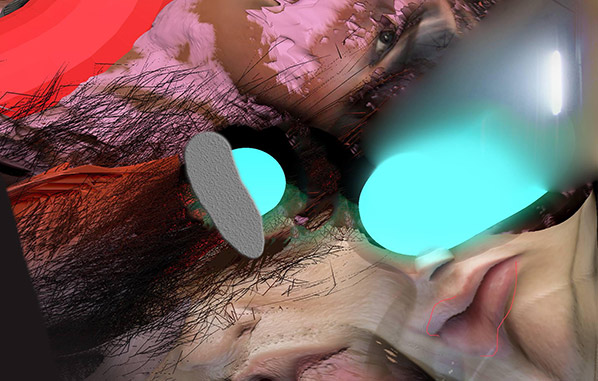
Be sure to dress things up so you can recognize them well. Try not to mix up hair with noses, and composure with distortion. Each act of mediation further twists and reinvents our own images. You thought you knew where your lips were, what your skin looked like, but everything that goes through the machine comes out different, strange. It’s not a human, it’s a landscape. There’s an eye at the top, but you have no idea what it’s for. In the work of Sam Rolfes, the self is almost abstract, technical distortions take over any recognizable vestige of a human. Technique is everything, humanity nothing.
The self is painted, photographed, symbolized. It’s not a live image on the phone. Sometimes people in canvases try to get out. There are a few people here, all the same, that have nothing to do with one another. In Carla Gannis‘ selfie series, we return to a cartoon realism – but this time with a few added mirrors. Is the skull in the background also her? What is that a memento of?
Death in the image, life in its reproduction. You are now invisible, but we know more about what you look like than ever. Technological proliferation upends and eliminates traditional context but can never efface bodies and their identities. Indeed its societal saturation emphasizes these presences, their inevitability and all their embodied ties that digitize incompletely.
These practices work to situate the self, the body. Physiological maps are now more important than ever – they give us the image of the virtual. Mythology says we are in an immaterial age, that humans are obsolete and will be succeeded by machines. Reality says something far more disturbing – that our own materiality is the means of that obsolescence.
In partnership with The Arts Catalyst.
‘Living Assemblies’ is a hands-on workshop, led by designer and researcher Veronica Ranner, investigating the coupling of the biological material silk, with digital technologies. This workshop is organised by The Arts Catalyst in cooperation with Furtherfield.
We invite participants (experts in their own field – artists, designers, scientists, writers, technologists, academics, and activists) to join a weekend-long workshop, in which we will experiment with silk and a range of transient materials to imagine potential future applications for combining biological and digital media.
Traditional methods of crafting silk have barely changed in 5000 years, but recent explorations by scientists are uncovering extraordinary new potential uses for this material. Reverse engineered silk is one of the few biomaterials not rejected by the human body. Rather, able to be fully absorbed by human tissue, it allows for a range of applications within and interacting with the body, including human bone and tissue replacements, biosensors and biodegradable electronics, opening the potential to imagine new wearables and implantables with a range of functions.
During this two-day workshop, participants will collaboratively explore the potential of reverse engineered silk, currently confined to laboratories. Taking the body as the first site for investigation, Veronica will ask participants to consider themselves as living assemblies that can be hacked, enhanced, and patched into using bio-digital materials. Activities will involve material experiments combined with a narrative design process to speculate on silk’s possible future use in the world.
DAY 1
With Veronica Ranner, Clemens Winkler and Luke Franzke, participants will be introduced to transient materials — such as reversed engineered silk — through hands-on experimentation with a range of materials, including agar-agar, gelatine, fibroin, glucose and silk-fibres. They will use digital methods and circuits and combine them with silken materials, to then begin forming their own ideas into speculative objects and artworks.
DAY 2
Innovator, scientist and intermedia artist, Gjino Sutic will introduce the concept of ‘bio-tweaking’: improving and hacking living organisms, for example through metabolism hacking, neuro-tweaking, tissue engineering and organ growing. Participants will work together with science writer Frank Swain to construct narratives around their work. In the final session, participants will map out their ideas in discussion with the group.
If you would like to attend the 2-day workshop please send a statement of no more than 100 words and explain why you would like to attend and a brief summary of your background.
Deadline: 5pm, 18 May 2015
Please email: admin@artscatalyst.org
**Participants must be able to attend the full 2 day workshop**
**Please note spaces are limited**
Participants are encouraged to bring their own laptops, inspirational materials, tablets and cameras along, to enrich the tool set for story crafting.
Veronica Ranner is a designer, artist and researcher living and working in London. She researches the burgeoning domain of the bio–digital — a converging knowledge space where digitality and computational thinking meet biological matter. She dissects and creates tangible and immaterial manifestations of such collisions, examining hereby the polyphonic potential of alternative technological futures. Her current doctoral work explores paradigm shifts in reality perception by coupling speculative (bio)material strategies and information experience through design research. Veronica holds a degree in Industrial Design from Pforzheim University, a Masters in Design Interactions (RCA), and has worked trans-disciplinary with a variety of science institutions and biomedical companies, and she teaches and lectures internationally. Her work is exhibited internationally, including at the Israel Museum, Jerusalem (2012), Science Gallery, Dublin (2012), China Technology Museum, Beijing (2012), Ventura Lambrate, Milan (2013) and French Design Biennale, St. Etienne (2013). She is currently pursuing a PhD at the Royal College of Art’s Information Experience Design programme and is interested in complex networked cycles, emerging (bio-) technologies and biological fabrication, systems design, material futures and new roles for designers.
Clemens Winkler, designer and researcher at the Zurich University of the Arts, Switzerland.
Luke Franzke, designer and researcher at the Zurich University of the Arts, Switzerland.
Frank Swain, science writer and journalist.
Gjino Sutic, innovator, scientist and artist; Director of the Universal Institute in Zagreb, Croatia.
Other experts joining discussions during the workshops will be Bio-informatician Dr Derek Huntley (Imperial College).
The project is a collaboration between The Creative Exchange Hub at the Royal College of Art, Tufts University (Boston, MA), The Arts Catalyst (London), and Imperial College (London), and hosted and in collaboration with Furtherfield (London). The project is funded by the Arts and Humanities Research Council.
With Virginia Barratt, Francesca da Rimini, Cory Doctorow, Shu Lea Cheang, Jennifer Lyn Morone™ Inc, Andrew McKenzie, Angela Oguntala, Dr. Richard Stallman, Stelarc, Jacob Wamberg, Lu Yang
Inspired by the Phillip K Dick short story “The Electric Ant” this year’s CLICK seminar curated with Furtherfield explores how identity and perceptions of reality have changed in a world where humans, society and technology have merged in unexpected ways. Who are we, what’s real, where can we expect to go from here, and how can we get there together?
From future shock to FOMO (fear of missing out), accelerating technological change has disrupted our perception of ourselves and the world around us. Pervasive computing, genetic engineering, artificial intelligence, drones and robotics, neural interfaces and implants, 3D printing, nanotechnology, big data and ever more technologies are redrawing the boundaries of what it means to be human and what it means to be you.
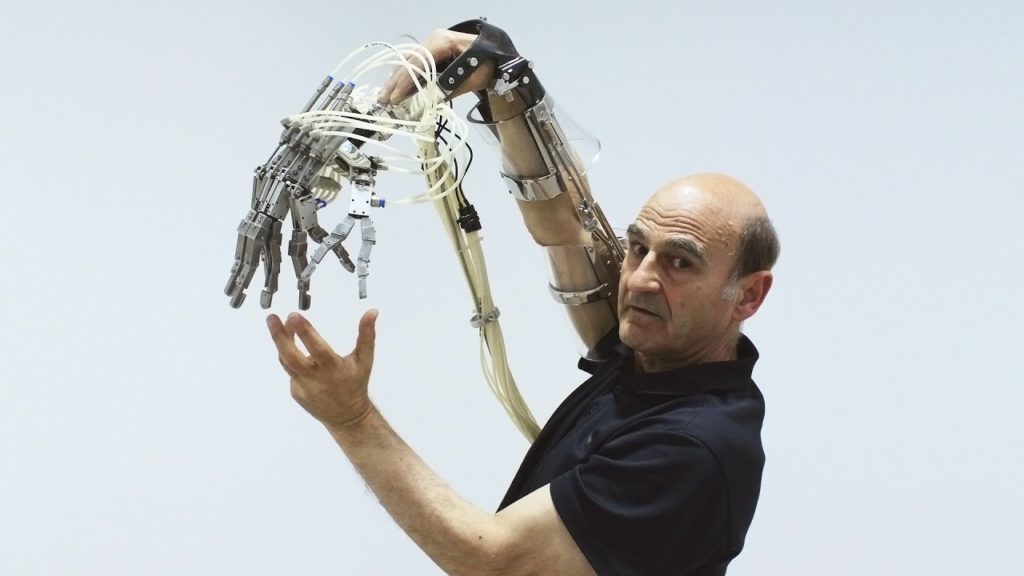
At the same time the design and unintended consequences of technology are creating new mass behaviours. And the productive forces of social media, peer production, hacker culture and maker culture are creating new possibilities for creation and expression. All of this changes how we relate to one another within society as part of the public.
This years CLICK festival, co-curated by Furtherfield sets out to explore questions related to identity and perceptions of reality in a world where humans and technology have merged in unexpected ways.
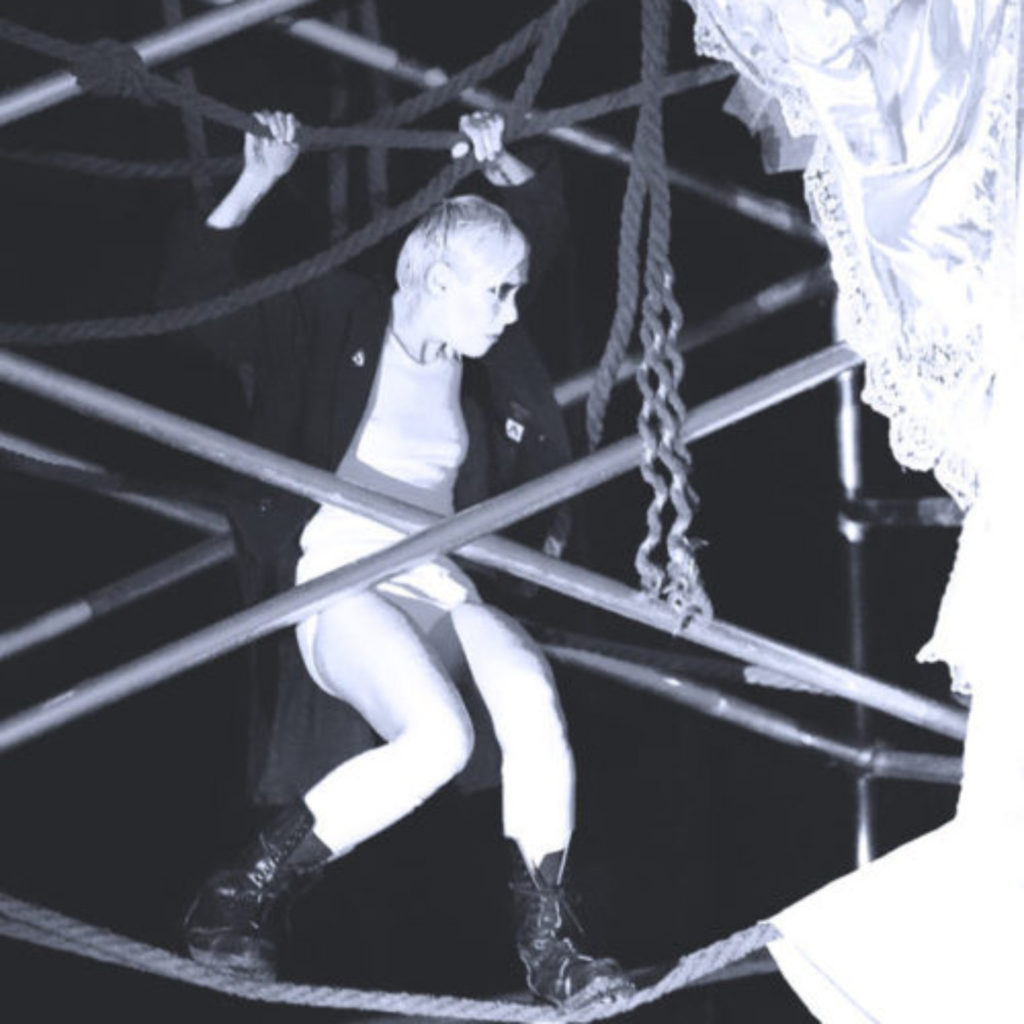
Virginia Barratt. VNS Matrix founder, cyberfeminist, Virginia Barratt is a PhD candidate at the University of Western Sydney in experimental poetics. Her doctoral topic is panic, engaging tensions between ontological meltdown/psychic deterritorialisation and ontological security. Panic is remediated from its pathological narrative and reimagined as a space of urgency/agency from which to act. Her work of performative text, SLICE, is forthcoming from Stein and Wilde.
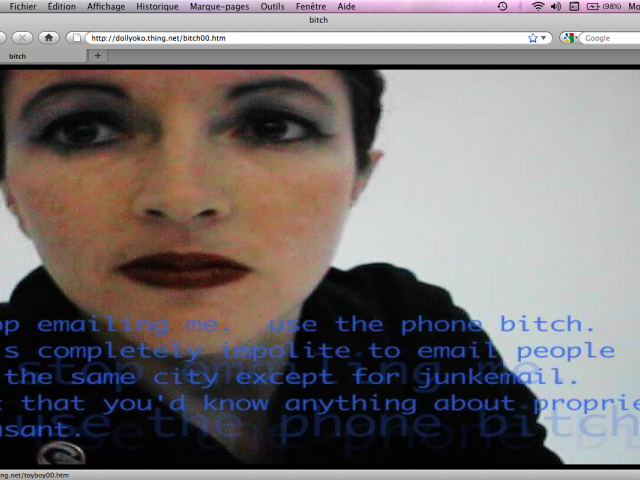
Francesca da Rimini explores the poetic and political possibilities of internet-enabled communication, collaborative experimentation and (tel)embodied experiences through projects such as her award-winning dollspace. As cyberfeminist VNS Matrix member she inserted slimy interfaces into Big Daddy Mainframe’s databanks, perturbing the (gendered) techno status quo. Her doctoral thesis at the University of Technology Sydney investigated cultural activism projects seeding radical imaginations in Jamaica, Hong Kong and the UK. A co-authored book, Disorder and the Disinformation Society: The Social Dynamics of Information, Networks and Software, will be out in May 2015.

Cory Doctorow is assigned the label Internet philosopher, who writes, blogs and debates about online rights. Doctorow is convinced that copyright is an out-dated idea that damages the Internet and criminalizes peoples’ online actions improperly. According to Doctorow the current regulations of copyrights are obsolete by the unstoppable copy machine we call the Internet, which continues to produce samples of available online material such as pictures, music and text. Cory Doctorow is also an award-winning science fiction author and co-editor at boingboing.net.

Shu Lea Cheang is known for her pioneering work in the field of media art and she is a true multidisciplinary and activist artist whose work spans from film to net art and performance (online, and in galleries) and video installation. Beginning the 1981 she was involved in the media activist’ collective ‘Paper Tiger TV’. Among her important multimedia works is the ‘Brandon Project’ (1998-99). Guggenheim Museum’s first official engagement with the then-emerging medium of internet art and one of the first works of this medium commissioned by a major institution. Following the production of the cyber porn film ‘I.K.U.’ (2000)(first porn film to be shown at the Sundance Festival) she focused on questions of copyrights and economy in media culture. Shu Lea Cheang holds a BA in history from the National Taiwan University, and a MA in film studies from New York University.
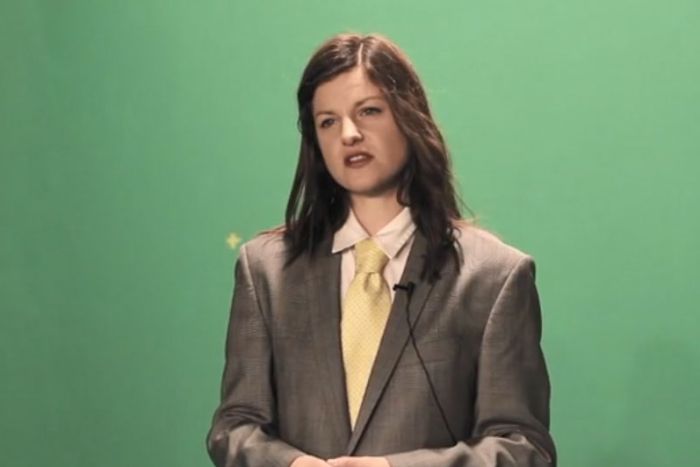
Jennifer Lyn Morone™ Inc (US). In a world before the Internet – information, transmission and dissemination was a controlled and regulated endeavour. The advent of the information superhighway, which is currently littered with social media sites run by billion dollar corporations, has blurred the lines of community ownership of one’s personal information and the individual. By incorporating herself she effectively wrestled the control of her digital self, back from corporations and took an active role in the sale of her information. Morone has been motivated by an underlying fascination with the relationship between technology, human beings, and the socio-economic political implications the melding of the two produce. That social concern, spurned Jennifer to create Jennifer Lyn Morone™ Inc.
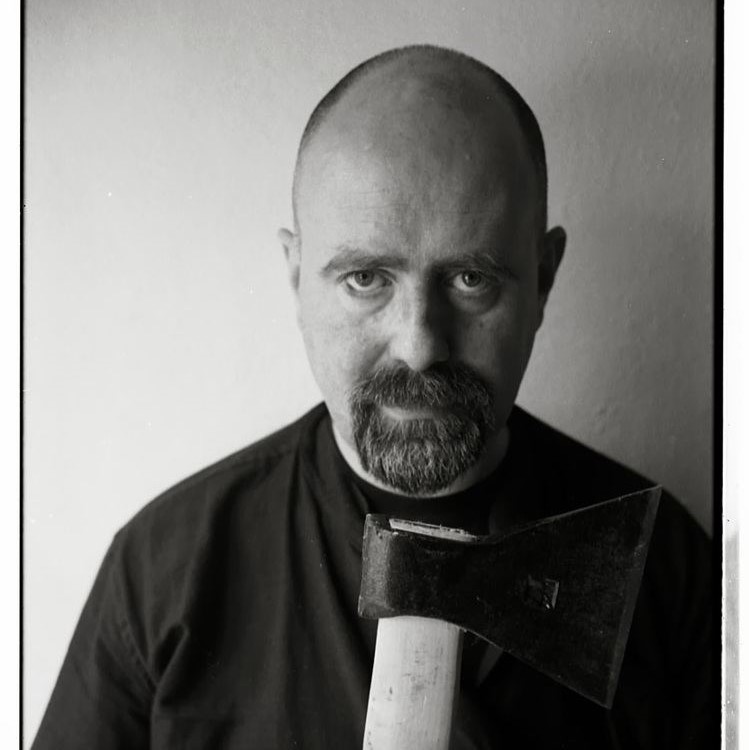
Andrew McKenzie (UK). The British Andrew McKenzie is the core of The Hafler Trio. His professional career began more than 3 decades ago and through the years he has worked with different professions such as audio designer, psychotherapist, hypnotherapist and workshop leader in Creative Thinking. McKenzie is also co-founder of Simply Superior where he teach creative processes that challenge the way you think in order to make you realize what you know, and are aware of not knowing. McKenzie’s projects and present goals all involve applying everything learned by experience over the last 48 years for the benefit of other. Andrew McKenzie defines himself as a mood engineer, specializing in changing people’s lives.

Angela Oguntala (US/DK) is a designer whose work sits at the intersection of technology, design, and futures studies. Currently, she heads up an innovation lab for Danish designer Eskild Hansen, envisioning and developing future focused products and scenarios. In 2014, she was chosen by a panel consisting of the United Nations ICT agency, Ars Electronica, and Hakuhodo (Japan) as one of the Future Innovators for the Future Innovators Summit at Ars Electronica – called on to give talks, exhibit her work, and collaborate on the theme ‘what it takes to change the future’.
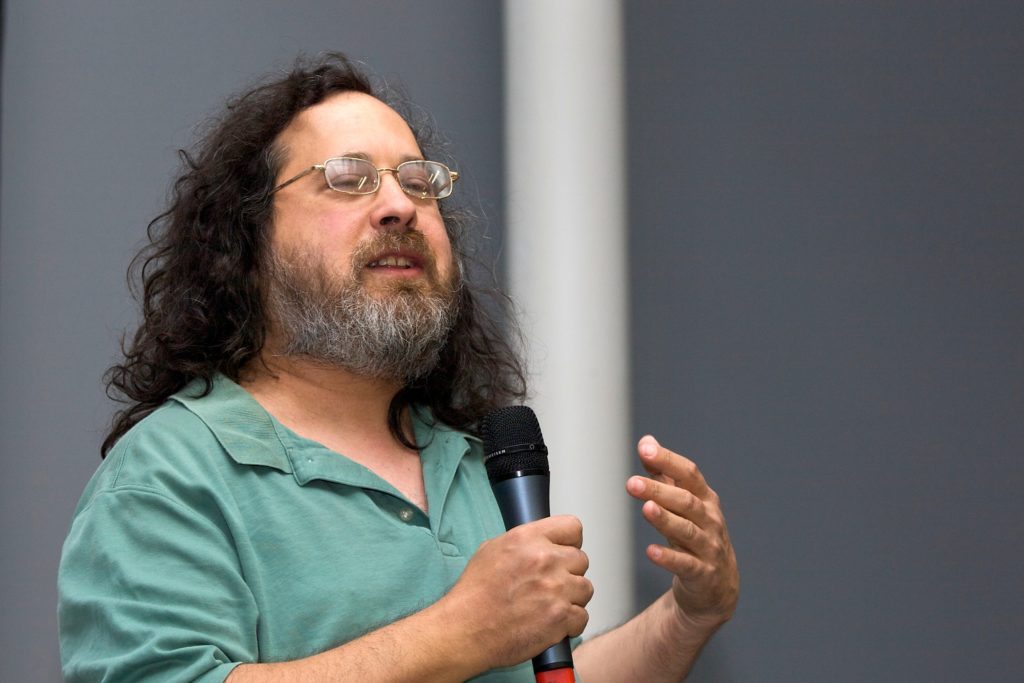
Dr. Richard Stallman launched the free software movement in 1983 and started the development of the GNU operating system (see www.gnu.org) in 1984. GNU is free software: everyone has the freedom to copy it and redistribute it, with or without changes. The GNU/Linux system, basically the GNU operating system with Linux added, is used on tens of millions of computers today. Stallman has received the ACM Grace Hopper Award, a MacArthur Foundation fellowship, the Electronic Frontier Foundation’s Pioneer Award, and the Takeda Award for Social/Economic Betterment, as well a several doctorates honoris causa, and has been inducted into the Internet Hall of Fame in 2013.
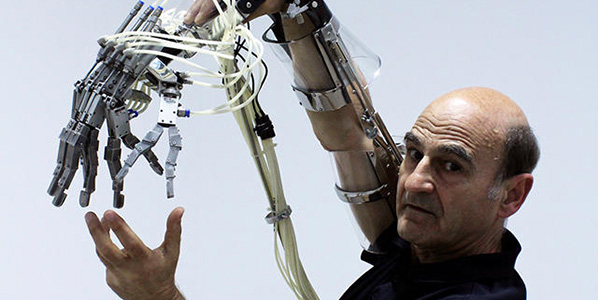
Stelarc (AU). An extra ear. A third arm. Six legs. A walking head. The Australian performance artist Stelarc is questioning and challenging whether or not it is possible to optimize the abilities of the human body. Stelarc has since the 1960s not hesitated to include advanced technology in his projects. After having examined several test on his own body, he announce a manifest claiming that the human body is out-dated and no longer meets the information society we live in. Stelarc uses his artwork to convey how the human body hypothetically will appear in the nearest future, if the technology is considered an extra dimension to the evolution.
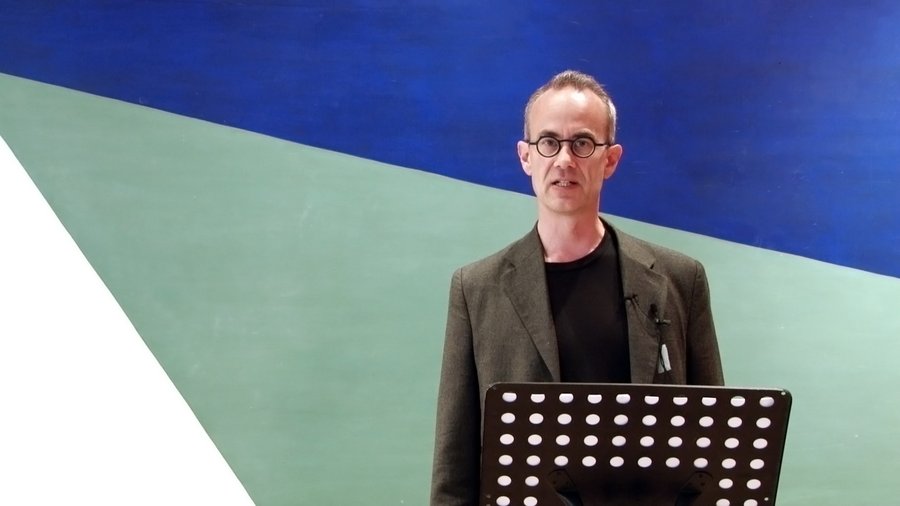
Jacob Wamberg, Professor of Art History at Aarhus University. Principal Investigator for Posthuman Aesthetics. In the posthuman field, he has co-edited The Posthuman Condition: Ethics, Aesthetics and Politics of Biotechnological Challenges (2010) with Mads Rosendahl Thomsen et al., and is now working on tracing the early contours of the posthuman paradigm (ca. 1900-1930), focusing on Dada, Futurism and Functionalism.
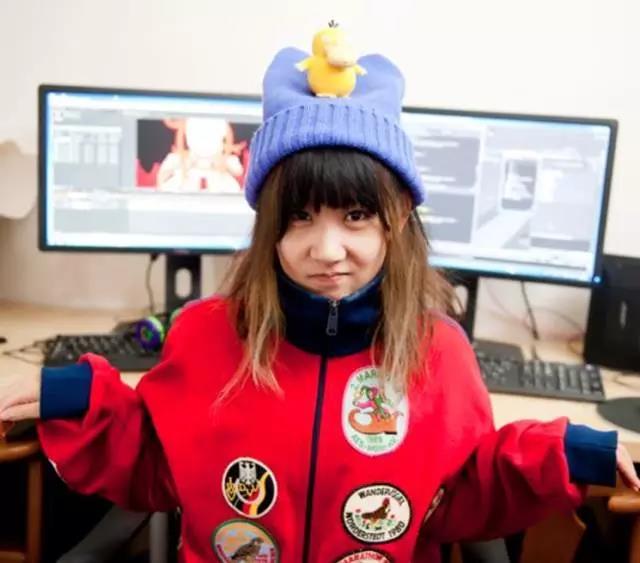
Shanghai based artist Lu Yang utilize a range of mediums known from pop culture such as Japanese manga and anime, online gaming, and sci-fi. She mixes these with discourses of neuroscience, biology, and religion, when she asks what it means to be human in the 21st century. Her depictions of the body, death, disease, neurological constructs, sexuality/asexuality, gender is unsentimental, confrontational and in their morbid humor not for the squeamish. Lu Yang is one of the most influential Chinese contemporary artists rising at the moment. She is a graduate from the China Academy of Art New Media. Her work has the last couple of years been internationally shown at museums and galleries and she has in 2014 been residency at AACC in New York and Symbiotica in Australia.
Please visit the CLICK website to purchase your ticket.
Ticket: 350 DKK. / Student: 250 DKK.
Explore and discuss the data surveillance processes at play in Finsbury Park through a process of rapid group ethnography. Arrive from 5.30pm at Furtherfield Commons, the community lab space in Finsbury Park, for a short introduction to the project. We will leave at 6pm for a 90 minute walk around the area followed by food and discussion.
Please bring:
This walkshop event is part of the research and development for the Museum of Contemporary Commodities.
The telluro-geo-psycho-modulator is the latest experiment in a series of playful explorations and elaborations of a general thesis extracted from the neuroscientist Michael Persinger’s work, that our brain states are modulated by the interference patterns created by our immersion in natural weak geomagnetic fields, and that such patterns cause the feeling of “anomalous experiences” including those of ghosts or god.
The workshop aims to begin equipping participants with a method to explore such potentialities between the earth and our psyches through the construction of an experimental interface (developed with Martin Howse).
A short introduction (20 min) to participants will briefly cover the theory of weak geo-magnetic field effects on psyche, including demonstrating an entirely synthetic electronic amplifier/helmet configuration. This will ground participants in both the practical and playful nature of the project.
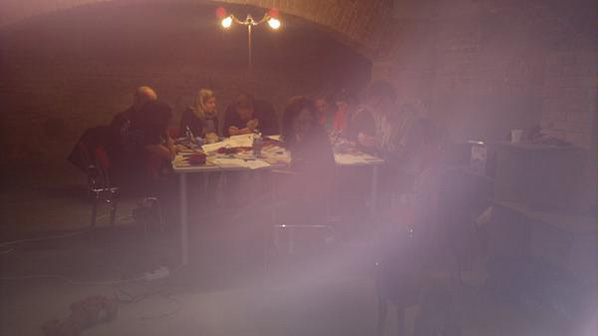
The brain is electro-chemical, and the existence of fundamental commonalities between all 7 billion human brains by which a similar physical stimulus can affect them is not a new concept – however, this workshop tests the idea that it is the induction by very low electromagnetic fields that disrupt a sense of self through the creation of anomalous experiences.
In the workshop particpants will build a simple circuit with which to test this thesis by connecting the earth’s telluric currents directly to our brains. On the second day we will then test the circuits outdoors in Epping Forest.
During the workshop and field trip participants will build electronic circuits and hand wind copper coils to construct:
The workshop is estimated to take around 4-6 hours for around 8 or so participants. All materials are supplied, however if participants have a soldering iron, please bring it along.
Each participant is asked to pay £15. This is to cover material costs – participants get to keep their circuits which can also be used with other circuits (eg. audio).
Featured image: By Instagram users lynellspencer and banditqueen555
I’ve been thinking about the idea of home a lot recently. I’ve been traveling over three continents for the last 6 months, living out of hostels, surfing friend’s couches, and even staying in local homes through Couchsurfing or personal connections. In terms of my home, I’ve grown comfortable with no privacy, sleeping in a room of strangers with only a tiny locked box for security. While I knew in my head the contemporary home is always shifting, I didn’t start considering the impact of that until my own housing situation became so erratic.
So I was excited to reflect further on the homes when the design research collaborative Space Caviar released a book of commissioned essays entitled, SQM: The Quantified Home. The essays examine how the romantic idea of the home is increasingly in tension with global market forces, zoning laws, new technologies, surveillance, war, and much more. The book was commissioned by Biennale Interieur and was part of Space Caviar’s program, “The Home Does Not Exist,” which premiered at the Biennale Interieur in Belgium in October of last year.

“Industry people today don’t actually want the home of the future. What they want is the homeowner of the future, as the kind of completely consumer-aware, Amazon-livestock guy… They don’t care what the shape of the house is, they just want the data flows in and out.” – Bruce Sterling, (pg. 236)
In his essay, Bruce Sterling asks us how the architecture and architects of the home will be disrupted – like the music and publishing industries were disrupted – for data optimization? As we’ve done for social media, we’re opening up our homes to private companies for the sake of security and ease. We’re putting security cameras in our children’s bedrooms and connecting our home to the cloud with devices such as Amazon Echo. How will the home as networked site look when created to produce as much advertising data as possible? How can a home look more like an Amazon warehouse?
In the networked home of the future, will we enter a Facebook-like power relationship, willingly rendering all our most private moments visible to marketers for a tax break or a free networked fridge? It sadly doesn’t sound too unlikely to me. SQM: The Quantified Home sets up a history and context to considering the realities of this kind of future home, making the clear complex data and politics already intersecting within our home.

Much of this opening up of the home is economically focused. Given the financial collapse of 2008 and subsequent austerity measures around the world, of which all but the mega-wealthy are still reeling from, we’ve been forced to use our homes as economic tools of investment as much as private spaces for family and loved ones. An investment which fewer and fewer people can afford to make. If architecture, homes, and even cities follow the trend of social media’s economic disparity – exchanging some free services for huge swaths of powerful and valuable data – it’s only going to get worse.
Selling acceptable looking cheap furniture that can barely survive its own assembly, Ikea is a perfect response to a generation that cannot afford a home. As career security grows more precarious, we’re increasingly moving cities and jobs, with Airbnb as a life raft for homeowners who can’t afford rent, and renters who can’t afford a home. The romantic ideas of “home” are collapsing all around us. As Alexandra Lange, author of Writing about Architecture: Mastering the Language of Buildings and Cities, notes, our Pinterests are filled with items we will never buy for homes we can no longer afford.

In, “The Commodification of Everything,” Dan Hill, the executive director of Futures at the UK’s Future Cities Catapult, looks at Marc Andreessen’s notion that, “software is eating the world,” and applies it to Airbnb and resident-led emergent urban interventions in Finland. While some celebrate often left-of-legal urban interventions, many of the same group cries foul when corporations like Airbnb do the same.
Hill writes, “It took Hilton a century to construct all of their hotels, brick by brick; Airbnb came along, armed only with software, and in six years created more without laying a brick.” (pg. 219) Hill asks us to further investigate how to use software in a civic way, protecting and enabling local culture and economies for the benefit of everyone. Hill writes that software “is eating the world, and it is only just booting up. Our response to that, as citizens and cities, will determine whether it does so for public good or for private gain.” (pg. 223)
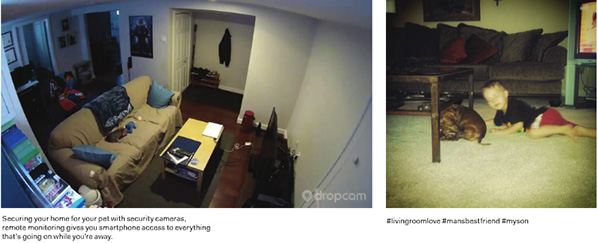
So while the home is becoming a more fluid space, this predominately suits businesses or people like me because I have the freedom and privilege to move easily and earn a living wherever I have internet. Making housing more responsive to individual needs is nice advertising, but ignores larger housing markets and market forces all of us are subjected to.
Now, after reading this book and 6 months of travel with at least 6 more months to go, my idea of the home has shifted to be understood mostly in relation to family and friends. Moving through many different architecture styles, cultures, customs, and living situations have made me care less about the physical space of the home. However, this means that as the contemporary home becomes a site of surveillance, responsive, and transparentin relation to corporations and often governmental organizations, the contemporary home will place these networked spheres between us and those we most cherish.
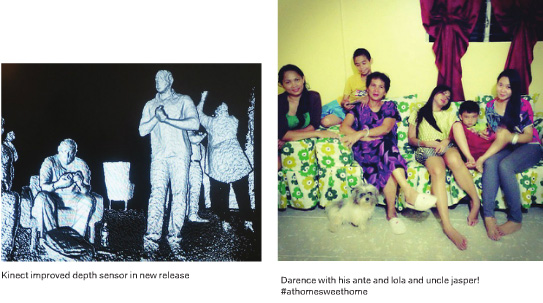
Our most intimate settings – be it a home or an Airbnb room – now have corporations sitting right next to us. Just as we know you shouldn’t share anything you don’t want everyone to know on Facebook, in the future, we now know not to talk in front of your smart TV. The home may be the final site of privacy in modern cities yet many are actively sacrificing that privacy for a sense of security or for cool new products whose terms and conditions we never fully grasped.
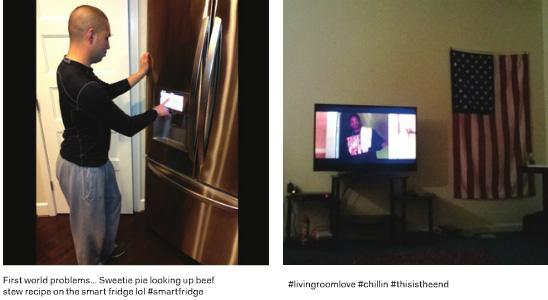
Conversely, instead of placing ads between a couple cuddling on their networked bed of the future, the networked home is equally likely to put our entire social network into the bed with us in hopes of more clicks. We already see how social networks can favor clicks over meaningful connection. Joanne McNeil’s essay. “Happy Birthday,” continues a progression we’re already seeing to an always-on extreme where our birthdays are reduced to spam-like events where everyone we ever met and every object we encounter spews “Happy Birthday” ad nauseam.
This is of course a product of the advertising model of which most everything online is reliant on. Why would that change when the internet moves into your home? Indeed we already ask for this as 80% of 18 to 44 year olds check our phones first thing upon awakening. Now just turn your bed into the phone.

While networks moving into our home is cause for alarm, what was most startling to me about SQM: The Quantified Home, was the extent to which the home is already a site of many networked relationships between the city, few of which we control or are meaningfully transparent to the average homeowner. In “Postcode Demographics” Joseph Grima and Jonathan Nicholls discuss Acorn, an early program quantifying housing markets in the England. Using 60 metrics of classifications, Nicholls helped quantify neighborhoods for real-estate developers, homeowners, taxation, and more. The introduction of postal codes further quantified neighborhoods in a way likely many find helpful yet can lead to a kind of data lock-in. As these methods of quantification grow more complex, and the ramifications larger, the possibility of residents transcending their zip codes grows dimmer. We see this problem with funding of public schools in the states.
While we continue to connect to our homes and to each other in new ways, if those connections continue to benefit the Googles of the world the most, we’re in for trouble. Turning your home transparent to them and forgetting the place of the home within larger societal and civic concerns is dangerously shortsighted and will only benefit the big businesses. As Hill writes, whether these changes are to be net positive depends, “on how much we care about the idea of the city as a public good, how adept we are at absorbing and redirecting disruptive forces for civic returns.” (pg. 223)
Featured image: Rosa Menkman, iRD patch, (2015) Black on black embroidered logo [iRD] Encryption key to the institutions RLE 010 0000 – 101 1111
In the lead-up to her solo show, institutions of Resolution Disputes [iRD], at Transfer Gallery, Brooklyn, Daniel Rourke caught up with Rosa Menkman over two gallons of home-brewed coffee. They talked about what the show might become, discussing a series of alternate resolutions and realities that exist parallel to our daily modes of perception.
iRD is open to visitors on Saturdays at Transfer Gallery until April 18th, and will also function as host to Daniel Rourke and Morehshin Allahyari’s 3D Additivist Manifesto, on Thursday April 16th.
Rosa Menkman: The upcoming exhibition at Transfer is an illustration of my practice based PhD research on resolutions. It will be called ‘institutions of Resolution Disputes’, in short iRD and will be about the liminal, alternative modes of data or information representation, that are obfuscated by technological conventions. The title is a bit wonky as I wish for it to reflect that kind of ambiguity that invokes curiosity.
In any case, I always feel that every person, at least once in their grown-up life, wants to start an institution. There are a few of those moments in life, like “Now I am tired of the school system, I want to start my own school!”; and “Now I am ready to become an architect!”, so this is my dream after wanting to become an architect.
Daniel Rourke: To establish your own institution?

RM: First of all, I am multiplexing the term institution here. ‘institutions’ and the whole setting of iRD does mimic a (white box) institute, however the iRD does not just stand for a formal organization that you can just walk into. The institutions also revisit a slightly more compound framework that hails from late 1970s, formulated by Joseph Goguen and Rod Burstall, who dealt with the growing complexities at stake when connecting different logical systems (such as databases and programming languages) within computer sciences. A main result of these non-logical institutions is that different logical systems can be ‘glued’ together at the ‘substrata levels’, the illogical frameworks through which computation also takes place.
Secondly, while the term ’resolution’ generally simply refers to a standard (measurement) embedded in the technological domain, I believe that a resolution indeed functions as a settlement (solution), but at the same time exists as a space of compromise between different actors (languages, objects, materialities) who dispute their stakes (frame rate, number of pixels and colors, etc.), following rules (protocols) within the ever growing digital territories.
So to answer your question; maybe in a way the iRD is sort of an anti-protological institute or institute for anti-utopic, obfuscated or dysfunctional resolutions.
DR: It makes me think of Donna Haraway’s Manifesto for Cyborgs, and especially a line that has been echoing around my head recently:
“No objects, spaces, or bodies are sacred in themselves; any component can be interfaced with any other if the proper standard, the proper code, can be constructed for processing signals in a common language.”
By using the terms ‘obfuscation’ and ‘dysfunction’ you are invoking a will – perhaps on your part, but also on the part of the resolutions themselves – to be recognised. I love that gesture. I can hear the objects in iRD speaking out; making themselves heard, perhaps for the first time. In The 3D Additivist Manifesto we set out to imagine what the existence of Haraway’s ‘common language’ might mean for the unrealised, “the powerless to be born.” Can I take it that your institute has a similar aim in mind? A place for the ‘otherwise’ to be empowered, or at least to be recognised?
RM: The iRD indeed kind of functions as a stage for non-protocological resolutions, or radical digital materialism.
I always feel like I should say here, that generally, I am not against function or efficiency. These are good qualities, they make the world move forward. On the other hand, I do believe that there is a covert, nepotist cartel of protocols that governs the flows and resolutions of data and information just for the sake of functionality and efficiency. The sole aim of this cartel is to uphold the dogma of modern computation, which is about making actors function together (resonate) as efficiently as possible, tweaking out resources to maximum capacity, without bottlenecks, clicks, hicks or cuts, etc.
But this dogma also obfuscates a compromise that we never question. And this is where my problem lies: efficiency and functionality are shaping our objects. Any of these actors could also operate under lower, worse or just different resolutions. Yet we have not been taught to see, think or question any of these resolutions. They are obfuscated and we are blind to them.
I want to be able to at least entertain the option of round video (strip video from its interface!), to write inside non-quadrilateral, modular text editors (no more linear reading!) or to listen to (sonify) my rainbows (gradients). Right now, the protocols in place simply do not make this possible, or even worse, they have blocked these functionalities.
There is this whole alternate universe of computational objects, ways that our data would look or be used like, if the protocols and their resolutions had been tweaked differently. The iRD reflects on this, and searches, if you will, a computation of many dimensions.
DR: Meaning that a desktop document could have its corners folded back, and odd, non standard tessellations would be possible, with overlapping and intersecting work spaces?
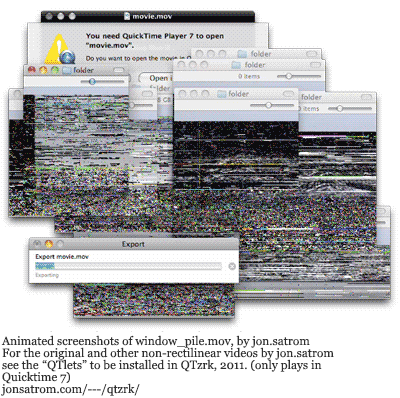
RM: Yes! Exactly!
Right now in the field of imagery, all compressions are quadrilateral, ecology dependent, standard solutions (compromises) following an equation in which data flows are plotted against actors that deal with the efficiency/functionality duality in storage, processing and transmission.
I am interested in creating circles, pentagons and other more organic manifolds! If we would do this, the whole machine would work differently. We could create a modular and syphoning relationships between files, and just as in jon Satroms’ 2011 QTzrk installation, video would have multiple timelines and soundtracks, it could even contain some form of layer-space!
DR: So the iRD is also a place for some of those alternate ‘solutions’ that are in dispute?
RM: Absolutely. However, while I am not a programmer, I also don’t believe that imagining new resolutions means to absolve of all existing resolutions and their inherent artifacts. History and ecology play a big role in the construction of a resolution, which is why I will also host some of my favorite, classic solutions and their inherent (normally obfuscated) artifacts at the iRD, such as scan lines, DCT blocks, and JPEG2000 wavelets.

The iRD could easily function as a Wunderkammer for artifacts that already exist within our current resolutions. But to me this would be a needles move towards the style of the Evil Media Distribution Center, created by YoHa (Matsuko Yokokoji and Graham Harwood) for the 2013 Transmediale. I love to visit Curiosity Cabinets, but at the same time, these places are kind of dead, celebrating objects that are often shielded behind glass (or plastic). I can imagine the man responsible for such a collection. There he sits, in the corner, smoking a pipe, looking over his conquests.
But this kind of collection does not activate anything! Its just ones own private boutique collection of evil! For a dispute to take place we need action! Objects need to have – or be given – a voice!
DR: …and the alternate possible resolutions can be played out, can be realised, without solidifying them as symbols of something dead and forgotten.
RM: Right! It would be easy and pretty to have those objects in a Wunderkammer type of display. Or as Readymades in a Boîte-en-valise but it just feels so sad. That would not be zombie like but dead-dead. A static capture of hopelessness.
DR: The Wunderkammer had a resurgence a few years ago. Lots of artists used the form as a curatorial paradigm, allowing them to enact their practice as artist and curator. A response, perhaps, to the web, the internet, and the archive. Aggregated objects, documents and other forms placed together to create essayistic exhibitions.
RM: I feel right now, this could be an easy way out. It would be a great way out, however, as I said, I feel the need to do something else, something more active. I will smoke that cigar some other day.
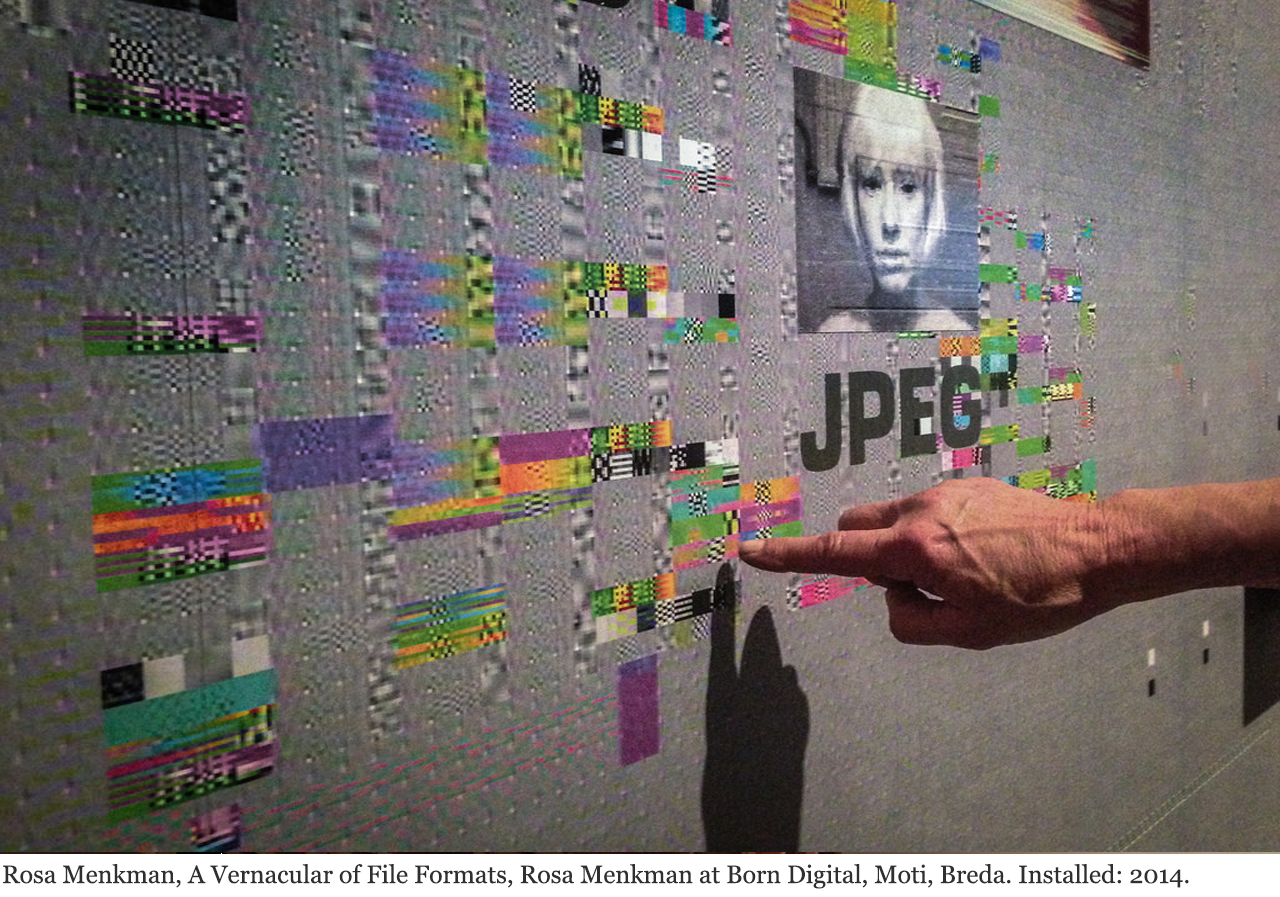
DR: So you wouldn’t want to consider the whole of Transfer Gallery as a Wunderkammer that you were working inside of?
RM: It is one possibility. But it is not my favorite. I would rather make works against the established resolutions, works that are built to break out of a pre-existing mediatic flow. Works that were built to go beyond a specific conventional use.
For example, I recently did this exhibition in The Netherlands where I got to install a really big wallpaper, which I think gained me a new, alternative perspectives on digital materiality. I glitched a JPEG and zoomed in on its DCT blocks and it was sooo beautiful, but also so scalable and pokable. It became an alternative level of real to me, somehow.
DR: Does it tesselate and repeat, like conventional wallpaper?
RM: It does repeat in places. I would do it completely differently if I did it again. Actually, for the iRD I am considering to zoom into the JPEG2000 wavelets. I thought it would be interesting to make a psychedelic installation like this. It’s like somebody vomited onto the wall.

DR: [laughs] It does look organic, like bacteria trying to organise.
RM: Yeah. It really feels like something that has its own agency somehow.
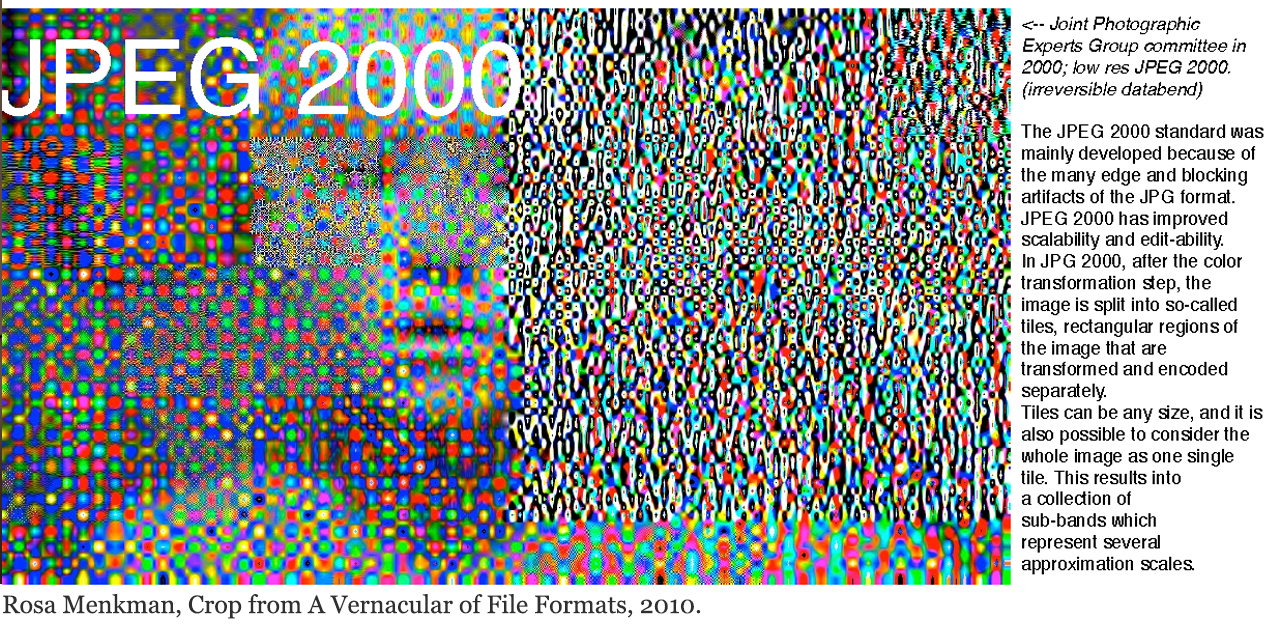

DR: That’s the thing about JPEG2000 – and the only reason I know about that format, by the way, is because of your Vernacular of File Formats – the idea that they had to come up with a non-regular block shape for the image format that didn’t contradict with the artifacts in the bones and bodies that were being imaged. It feels more organic because of that. It doesn’t look like what you expect an image format to look like, it looks like what I expect life to look like, close up.
RM: It looks like ‘Game of Life’.
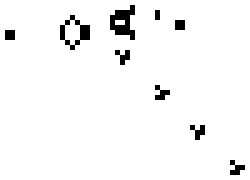
DR: Yes! Like Game of Life. And I assume that now they don’t need to use JPEG2000 because the imaging resolution is high enough on the machines to supersede bone artifacts. I love that. I love the effect caused when you’ve blown it up here. It looks wonderful. What is the original source for this?
RM: I would blow this image [the one from A Vernacular of File Formats] up to hell. Blow it up until there is no pixel anymore. It shouldn’t be too cute. These structures are built to be bigger. Have you seen the Glitch Timond (2014)? The work itself is about glitches that have gained a folkloric meaning over time, these artifact now refer to hackers, ghosts or AI. They are hung in the shape of a diamond. The images themselves are not square, and I can install them on top of the wallpaper somehow, at different depths. Maybe I could expand on that piece, by putting broken shaped photos, and shadows flying around. It could be beautiful like that.

DR: It makes me think of the spatiality of the gallery. So that the audience would feel like they were inside a broken codec or something. Inside the actual coding mechanism of the image, rather than the standardised image at the point of its visual resolution.
RM: Oh! And I want to have a smoke machine! There should be something that breaks up vision and then reveals something.
DR: I like that as a metaphor for how the gallery functions as well. There are heaps of curatorial standards, like placing works at line of sight, or asking the audience to travel through the space in a particular order and mode of viewing. The gallery space itself is already limited and constructed through a huge, long history of standardisations, by external influences of fashion and tradition, and others enforced by the standards of the printing press, or the screen etc. So how do you make it so that when an audience walks into the gallery they feel as though they are not in a normal, euclidean space anymore? Like they have gone outside normal space?
RM: That’s what I want! Disintegrate the architecture. But now I am like, “Yo guys, I want to dream, and I want it to be real in three weeks…”
DR: “Hey guys, I want to break your reality!” [laughs]
RM: One step is in place, Do you remember Ryan Maguire who is responsible for The Ghost in the MP3? His research is about MP3 compressions and basically what sounds are cut away by this compression algorithm, simply put: it puts shows what sounds the MP3 compression normally cuts out as irrelevant – in a way it inverses the compression and puts the ‘irrelevant’ or deleted data on display. I asked him to rework the soundtrack to ‘Beyond Resolution’, one of the two videowork of the iRD that is accompanied by my remix of professional grin by Knalpot and Ryan said yes! And so it was done! Super exciting.
DR: Yes. I thought that was a fantastic project. I love that as a proposition too… What would the equivalent of that form of ghosting be in terms of these alternate, disputed resolutions? What’s the remainder? I don’t understand technical formats as clearly as you do, so abstract things like ‘the ghost’, ‘the remainder’ are my way into understanding them. An abstract way in to a technical concept. So what is the metaphoric equivalent of that remainder in your work? For instance, I think it depends on what this was originally an image of. I think that is important.
RM: The previous image of JPEG2000 does not deal with the question of lost information. I think what you are after is an inversed Alvin Lucier ‘Sitting in a Room’ experiment, one that only shows the “generation loss” (instead of the generation left over, which is what we usually get to see or hear in art projects). I think that would be a reasonable equivalent to Ryan Maguires MP3 compression work.
Or maybe Supraconductivity.
I can struggle with this for… for at least two more days. In any case I want the iRD to have a soundtrack. Actually, it would like there to be a spatial soundtrack; the ghost soundtrack in the room and the original available only on a wifi access point.
DR: I’m really excited by that idea of ghostly presence and absence, you know. In terms of spatiality, scan lines, euclidean space…
RM: It’s a whole bundle of things! [laughs] “Come on scan lines, come to the institutions, swim with the ghosts!”
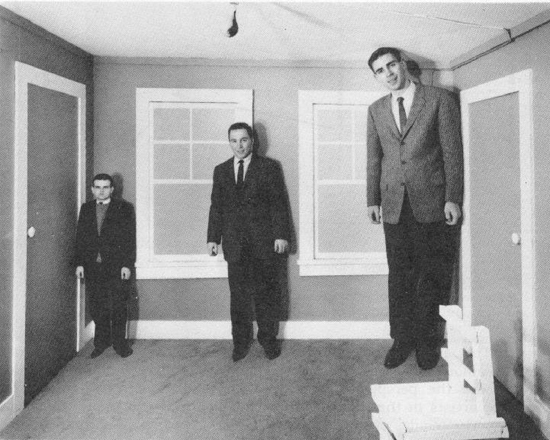
DR: It makes me think of cheesy things you get in a children’s museum. Those illusion rooms, that look normal through a little window, but when you go into them they are slanted in a certain way, so that a child can look bigger than an adult through the window frame. You know what I mean? They play with perspective in a really simple way, it’s all about the framing mechanism, the way the audience’s view has been controlled, regulated and perverted.
RM: I was almost at a point where I was calling people in New York and asked, “Can you produce a huge stained glass window, in 2 weeks?” I think it would be beautiful if the Institute had its own window.
I would take a photo of what you could see out of the real window, and then make the resolution of that photo really crappy, and create a real stained glass window, and install that in the gallery at its original place. If I have time one day I would love to do that, working with real craftspeople on that. I think that in the future the iRD might have a window through which we interface the outside.
Every group of people that share the same ideas and perspectives on obfuscation need to have a secret handshake. So that is what I am actually working on right now. Ha, You didn’t see that coming? [Laughs]
DR: [Laughs] No… that’s a different angle.
RM: I want people to have a patch! A secret patch. You remember Trevor Paglen’s book on the symbology of military patches?

DR: Oh yeah. Where he tries to decode the military patches? Yes, I love that.
RM: Yeah, I don’t think the world will ever have enough patches. They are such an icon for secret handshakes.
I have been playing around with this DCT image. I want to use it as a key to the institutions, which basically are a manifest to the reasonings behind this whole exhibition, but then encrypted in a macroblock font (I embedded an image of Institution 1 earlier). There was one of Paglen’s patches that really stood out for me; the black on black one. The iRD patch should be inspired by that.
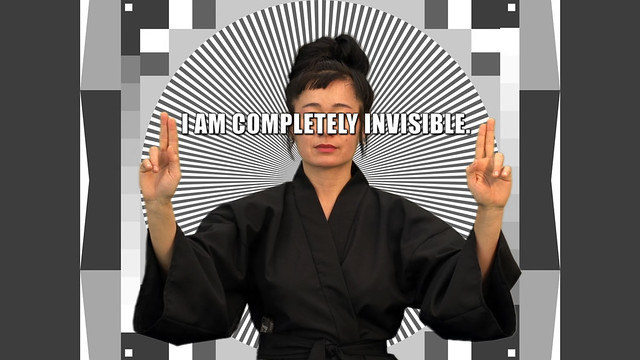
DR: Hito Steyerl’s work How Not to be Seen: A Fucking Didactic Educational .MOV File, centres on the grid used by the military to calibrate their satellites from space. The DCT structure looks a lot like that, but I know the DCT is not about calibration. It contains all the shapes necessary to compose any image?
RM: If you look up close at a badly compressed JPEG, you will notice the image consist of macroblocks. A macroblock is a block organizations, usually consisting of 8×8 pixels, that posses color (chrominance) and light (luminance) values embedded via DCT (discrete cosine transform).

Basically all JPEGs you have ever seen are build out of this finite set of 64 macroblocks. Considering that JPEGs make up the vast majority of images we encounter on a daily basis, I think it is pretty amazing how simple this part of the JPEG compression really is.
But the patch should of course not just be square. Do you know the TV series Battlestar Galactica, where they have the corners cut off all their books? All the paper in that world follows this weird, octagonal shape? Or Borges Library and its crimson hexagon, that holds all knowledge. I love those randomly cryptic geometric forms…
DR: It reminds me of a 1987 anime film, Wings of Honneamise, that had a really wonderfully designed world. Everything is different, from paper sizes and shapes, through to their cutlery. Really detailed design from the ground up, all the standards and traditions.
RM: Like this Minecraft book too. The Blockpedia.

DR: Oh that’s great. I love the Minecraft style
and the mythos that has arisen around it.
RM: So Minecraft and Borges follow a 6 corner resolution, and Battlestar paper has 8 corners… Discrepancy! I want to reference them all!
DR: So these will go into the badges?
RM: I want to have a black on black embroidered patch with corners. Don’t you think this would be so pretty? This black on black. I want to drop a reference to 1984, too, Orwell or Apple, the decoder can decide. These kind of secret, underground references, I like those.
DR: A crypto exhibition.
RM: It’s so hot right now (and with hot I do not mean cool). Since the 90s musicians encrypt or transcode things in their sounds, from Aphex Twin, to Goodiepal and now TCF, who allegedly encrypted an image from the police riots in Athens into one of his songs. However, he is a young Scandinavian musician so that makes me wonder if the crypto design in this case is confusingly non-political. Either way, I want to rebel against this apparent new found hotness of crypto-everything, which is why I made Tacit:Blue.
Tacit:Blue uses a very basic form of encryption. Its archaic, dumb and decommissioned. Every flash shows a next line of my ‘secret message’ encrypted in masonic pigpen. When it flickers it gives a little piece of the message which really is just me ranting about secrecy. So if someone is interested in my opinion, they can decode that.
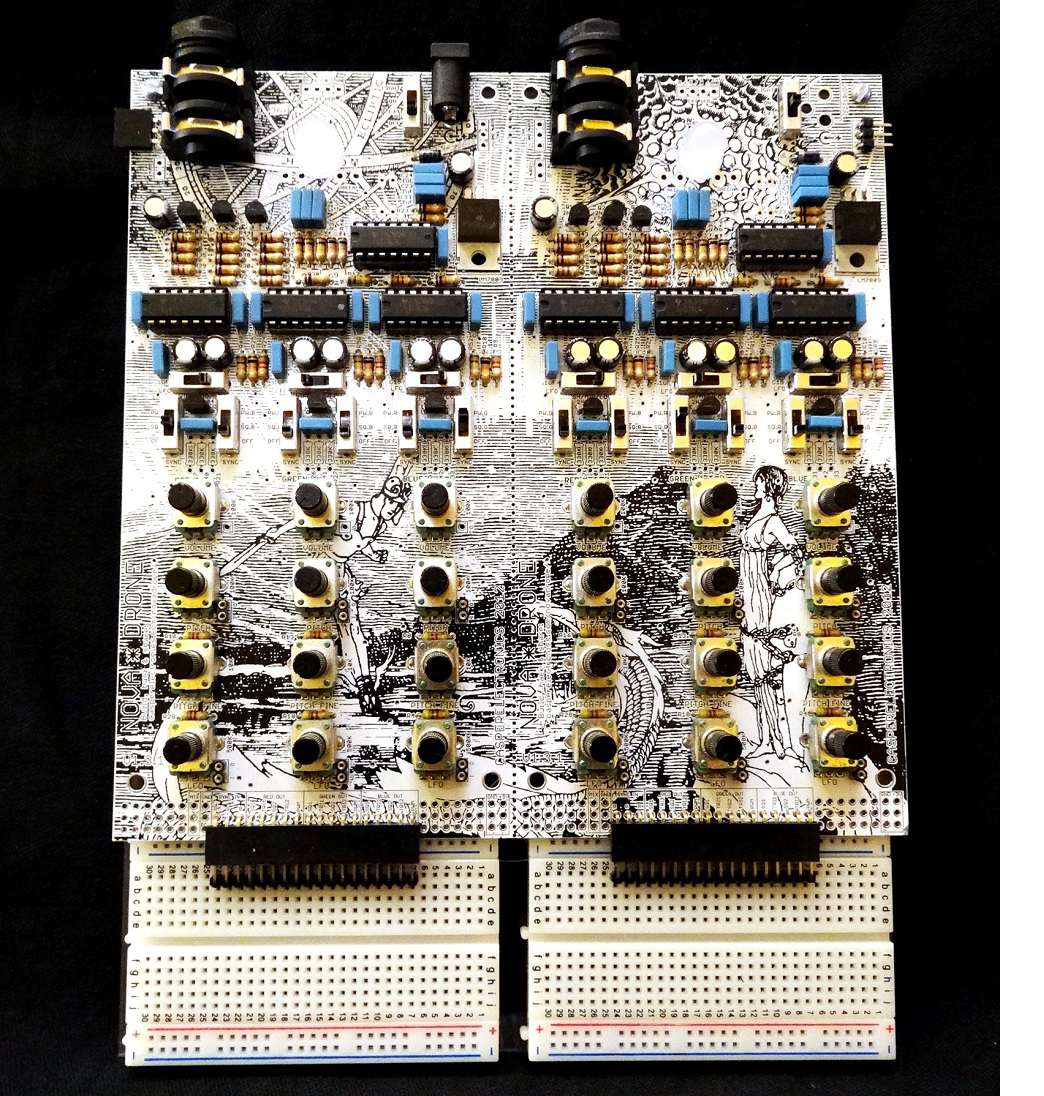
Actually, the technology behind the video is much more interesting. Do you know The Nova Drone? Its a small AV synthesizer designed by Casper Electronics. The the flickr frequency of this military RGB LED on the top of the board can be altered by turning the RGB oscillators. When I come close to the LED with the lens of my iphone, the frequencies of the LED and the iphone camera do not sync up. What happens is a rolling shutter effect. The camera has to interpret the input and something is gone, lost in translation. In fact, a Resolutional Dispute takes place right there.
DR: So the dispute happens because framerate of the camera conflicts with the flicker of the LED?
RM: And the sound is the actual sound of the electronics. In Tacit:Blue I do not use the NovaDrone in a ‘clean’ way, I am actually misusing it (if there is such a thing when it comes to a device of dispute). Some of the sounds and disruptions of flow are created in this patch bay, which is where you can patch the LFOs, etc. Anyway, when you disconnect the patch it flickers, but I never take it out fully so it creates this classic, noisy electric effect.
What do you think about the text? Do you think this works? I like this masonic pigpen, its a very simple, nostalgic old quiff.
DR: It reminds me of the title sequence for Alien. Dave Addey did a close visual, sci-fi etymological, analysis of the typography in Alien. It went viral online recently. Did you see that?
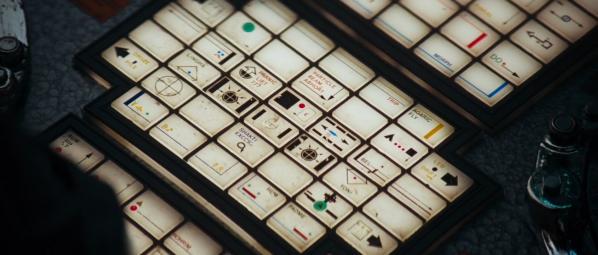
RM: No!
DR: It is fantastic. Everything from the title sequence to the buttons on the control panel in the background. Full of amazing insights.

RM: Wow, inspiring!
So with any cypher you also need a key, which is why I named the video Tacit:Blue, a reference to the old Northrop Tacit Blue stealth surveillance aircraft. The aircraft was used to develop techniques against passive radar detection, but has been decommissioned now, just like the masonic pigpen encryption.
DR: This reminds me of Eyal Weizman. He has written a lot on the Israeli / Palestinian conflict as a spatial phenomena. So we don’t think about territory merely as a series of lines drawn on a globe anymore, but as a stack, including everything from airspace, all the way down beneath the ground, where waste, gas and water are distributed. The mode by which water is delivered underground often cuts across conflicted territories on the surface. A stacked vision of territory brings into question the very notion of a ‘conflict’ and a ‘resolution’.
I recently saw him give a lecture on the Forensic Architecture project, which engages in disputes metered against US Military activities. Military drones are now so advanced that they can target a missile through the roof of a house, and have it plunge several floors before it explodes. It means that individual people can be targeted on a particular floor. The drone strike leaves a mark in the roof which is – and this is Weizman’s terminology – ‘beneath the threshold of detectability’. And that threshold also happens to be the size of a human body: about 1 metre square. Military satellites have a pixel size that effectively translates to 1 metre square at ground level. So to be invisible, or technically undetectable, a strike needs only to fall within a single pixel of a satellite imaging system. These drone strikes are designed to work beneath that threshold.
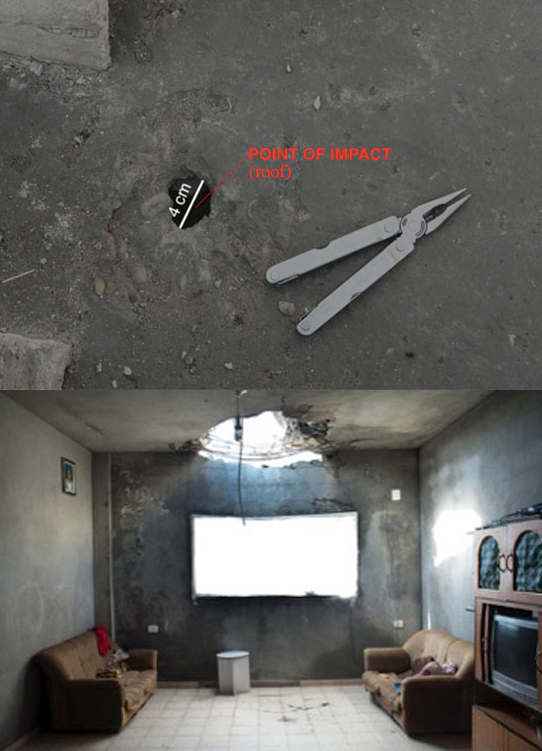
In terms of what you are talking about in Trevor Paglen’s work, and the Northrop Tacit Blue, those technologies were designed to exist beneath, or parallel to, optic thresholds, but now those thresholds are not optic as much as they are about digital standards and resolution densities. So that shares the same space as the codecs and file formats you are interested in. Your patch seems to bring that together, the analogue pixel calibration that Steyerl refers to is also part of that history. So I wonder whether there are images that cannot possibly be resolved out of DCT blocks. You know what I mean? I think your work asks that question. What images, shapes, and objects exist that are not possible to construct out of this grid? What realities are outside of the threshold of these blocks to resolve? It may even be the case that we are not capable of imagining such things, because of course these blocks have been formed in conjunction with the human visual system. The image is always already a compromise between the human perceptual limit and a separately defined technical limit.
RM: Yes, well I can imagine vector graphics, or mesh based graphics where the lines are not just a connection between two points, but also a value could be what you are after. But I am not sure.
At some point I thought that people entering the iRD could pay a couple of dollars for one of these patches, but if they don’t put the money down, then they would be obliged to go into the exhibition wearing earplugs.
DR: [Laughs] So they’d be allowed in, but they’d have one of their senses dampened?
RM: Yes, wearing earmuffs, or weird glasses or something like that. [Laughs]
DR: Glasses with really fine scan lines on them that conflict with TV images or whatever.
RM: [Laughs] And I was thinking, well, there should be a divide between people. To realise that what you see is just one threshold that has been lifted to only a few. There are always thresholds, you know.
DR: Ways to invite the audience into the spaces and thresholds that are beneath the zones of resolutional detectability?
RM: Or maybe just to show the mechanics behind objects and thresholds.
DR: Absolutely. So to go back to your Tacit:Blue video, in regards the font, I like the aesthetic, but I wonder whether you could play with that zone of detectability a little more.
You could have the video display at a frequency that is hard for people to concentrate on, for instance, and then put the cryptographic message at a different frequency. Having zones that do not match up, so that different elements of the work cut through different disputed spaces. Much harder to detect. And more subliminal, because video adheres to other sets of standards and processes beyond scan lines, the conflict between those standards opens up another space of possibilities.
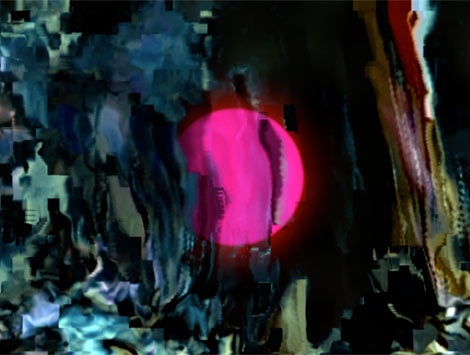
It makes me think about Takeshi Murata’s Untitled (Pink Dot). I love that work because it uses datamoshing to question more about video codecs than just I and P frames. That’s what sets this work apart, for me, from other datamoshed works. He also plays with layers, and post production in the way the pink dot is realised. As it unfolds you see the pink dot as a layer behind the Rambo footage, and then it gets datamoshed into the footage, and then it is a layer in front of it, and then the datamosh tears into it and the dot become part of the Rambo miasma, and then the dot comes back as a surface again. So all the time he is playing with the layering of the piece, and the framing is not just about one moment to the next, but it also it exposes something about Murata’s super slick production process. He must have datamoshed parts of the video, and then post-produced the dot onto the surface of that, and then exported that and datamoshed that, and then fed it back into the studio again to add more layers. So it is not one video being datamoshed, but a practice unfolding, and the pink dot remains a kind of standard that runs through the whole piece, resonating in the soundtrack, and pushing to all elements of the image. The work is spatialised and temporalised in a really interesting way, because of how Murata uses datamoshing and postproduction to question frames, and layers, by ‘glitching’ between those formal elements. And as a viewer of Pink Dot, your perception is founded by those slips between the spatial surface and the temporal layers.
RM: Yeah, wow. I never looked at that work in terms of layers of editing. The vectors of these blocks that smear over the video, the movement of those macroblocks, which is what this video technologically is about, is also about time and editing. So Murata effectively emulates that datamosh technique back into the editing of the work before and after the actual datamosh. That is genius!
DR: If it wasn’t for Pink Dot I probably wouldn’t sit here with you now. It’s such an important work for me and my thinking.

Working with Morehshin Allahyari on The 3D Additivist Manifesto has brought a lot of these processes into play for me. The compressed labour behind a work can often get lost, because a final digital video is just a surface, just a set of I and P frames. The way Murata uses datamoshing calls that into play. It brings back some of the temporal depth.
Additivism is also about calling those processes and conflicts to account, in the move between digital and material forms. Oil is a compressed form of time, and that time and matter is extruded into plastic, and that plastic has other modes of labour compressed into it, and the layers of time and space are built on top of one another constantly – like the layers of a 3D print. When we rendered our Manifesto video we did it on computers plugged into aging electricity infrastructures that run on burnt coal and oil. Burning off one form of physical compressed time to compress another set of times and labours into a ‘digital work’.
RM: But you can feel that there is more to that video than its surface!
If I remember correctly you and Morehshin wrote an open invitation to digital artists to send in their left over 3D objects. So every object in that dark gooey ocean in The 3D Additivist Manifesto actually represents a piece of artistic digital garbage. It’s like a digital emulation of the North Pacific Gyre, which you also talked about in your lecture at Goldsmiths, but then solely consisting of Ready-Made art trash.

The actual scale and form of the Gyre is hard to catch, it seems to be unimaginable even to the people devoting their research to it; it’s beyond resolution. Which is why it is still such an under acknowledged topic. We don’t really want to know what the Gyre looks or feels like; it’s just like the clutter inside my desktop folder inside my desktop folder, inside the desktop folder. It represents an amalgamation of histories that moved further away from us over time and we don’t necessarily like to revisit, or realise that we are responsible for. I think The 3D Additivist Manifesto captures that resemblance between the way we handle our digital detritus and our physical garbage in a wonderfully grimm manner.
DR: I’m glad you sense the grimness of that image. And yes, as well as sourcing objects from friends and collaborators we also scraped a lot from online 3D object repositories. So the gyre is full of Ready-Mades divorced from their conditions of creation, use, or meaning. Like any discarded plastic bottle floating out in the middle of the pacific ocean.
Eventually Additivist technologies could interface all aspects of material reality, from nanoparticles, to proprietary components, all the way through to DNA, bespoke drugs, and forms of life somewhere between the biological and the synthetic. We hope that our call to submit to The 3D Additivist Cookbook will provoke what you term ‘disputes’. Objects, software, texts and blueprints that gesture to the possibility of new political and ontological realities. It sounds far-fetched, but we need that kind of thinking.
Alternate possibilities often get lost in a particular moment of resolution. A single moment of reception. But your exhibition points to the things beyond our recognition. Or perhaps more importantly, it points to the things we have refused to recognise. So, from inside the iRD technical ‘literacy’ might be considered as a limit, not a strength.
RM: Often the densities of the works we create, in terms of concept, but also collage, technology and source materials move quite far away or even beyond a fold. I suppose that’s why we make our work pretty. To draw in the people that are not technically literate or have no back knowledge. And then perhaps later they wonder about the technical aspects and the meaning behind the composition of the work and want to learn more. To me, the process of creating, but also seeing an interesting digital art work often feels like swimming inside an abyss of increments.
DR: What is that?
RM: I made that up. An abyss is something that goes on and on and on. Modern lines used to go on, postmodern lines are broken up as they go on. Thats how I feel we work on our computers, its a metaphor for scanlines.

DR: In euclidean space two parallel lines will go on forever and not meet. But on the surface of a globe, and other, non-euclidean spaces, those lines can be made to converge or diverge. *
RM: I have been trying to read up on my euclidean geometry.
DR: And I am thinking now about Flatland again, A Romance in Many Dimensions.
RM: Yeah, it’s funny that in the end, it is all about Flatland. That’s where this all started, so thats where it has to end; Flatland seems like an eternal ouroboros inside of digital art.
DR: It makes me think too about holographic theory. You can encode on a 2D surface the information necessary to construct a 3D image. And there are theories that suggest that a black hole has holographic properties. The event horizon of a black hole can be thought of as a flat surface, and contains all the information necessary to construct the black hole. And because a black hole is a singularity, and the universe can be considered as a singularity too – in time and space – some theories suggest that the universe is a hologram encoded on its outer surface. So the future state of the universe encodes all the prior states. Or something like that.
RM: I once went to a lecture by Raphael Bousso, a professor at Department of Physics, UC Berkeley. He was talking about black holes, it was super intense. I was sitting on the end of my seat and nearly felt like I was riding a dark star right towards my own event horizon.
DR: [laughs] Absolutely. I suppose I came to understand art and theory through things I knew before, which is pop science and science fiction. I tend to read everything through those things. Those are my starting points. But yes, holograms are super interesting.
RM: I want to be careful not to go into the wunderkammer, because if there are too many things, then each one of them turns into a fetish object; a gimmick.

DR: There was a lot of talk a few years ago about holographic storage, because basically all our storage – CDs, DVDs, hard drive platters, SSD drives – are 2D. All the information spinning on your screen right now, all those rich polygons or whatever, it all begins from data stored on a two dimensional surface. But you could have a holographic storage medium with three dimensions. They have built these things in the laboratory. There goes my pop science knowledge again.
RM: When I was at Transmediale last year, the Internet Yami-ichi (Internet Black Market) was on. There I sold some custom videos for self cracked LCD screens.
DR: Broken on purpose?
RM: Yes, and you’d be allowed to touch it so the screen would go multidimensional. Liquid crystals are such a beautiful technology.
DR: Yes. And they are a 3D image medium. But they don’t get used much anymore, right? LEDS are the main image format.
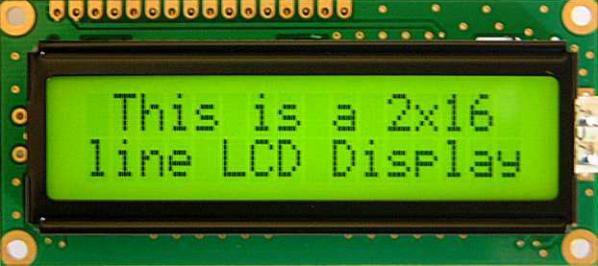
RM: People miss LCDS! I saw a beautiful recorded talk from the Torque event, Esther Leslie talking about Walter Benjamin who writes about snow flakes resembling white noise. Liquid crystals and flatness and flatland.
I want to thank you Dan, just to talk through this stuff has been really helpful. You have no idea. Thank you so much!
DR: Putting ideas in words is always helpful.
RM: I never do that, in preparation, to talk about things I am still working on, semi-completed. It’s scary to open up the book of possibilities. When you say things out loud you somehow commit to them. Like, Trevor Paglen, Jon Satrom are huge inspirations, I would like to make work inspired by them, that is a scary thing to say out loud.
DR: That’s good. We don’t work in a vacuum. Trevor Paglen’s stuff is often about photography as a mode of non-resolved vision. I think that does fit with your work here, but you have the understanding and wherewithal to transform these concerns into work about the digital media. Maybe you need to build a tiny model of the gallery and create it all in miniature.
RM: That’s what Alma Alloro said!
DR: I think it would be really helpful. You don’t have to do it in meatspace. You could render a version of the gallery space with software.
RM: Haha great idea, but that would take too much time. iRD needs to open to the public in 3 weeks!
* DR originally stated here that a globe was a euclidean space. This was corrected, with thanks to Matthew Austin.
DOWNLOAD
Full exhibition programme
‘Interface Perception. The Cybernetic Mentality and Its Critics: Ubermorgen.com’ by Søren Bro Pold
SEE IMAGES FROM THE PRIVATE VIEW
Beyond the Interface is an exhibition and series of events presented by Furtherfield, where leading international contemporary artists explore the technical devices that pervade our lives.
“The interface is the sense organ of the computer, whereby it becomes part of human culture” – Søren Bro Pold1
How much of our life do we spend in front of screens? Typically young adults in the UK spend more than a third of their waking lives watching TV or using computers, smartphones and tablets.2 These glowing rectangles are just one interface through which we contribute to the growing global human-machine network.
Nowadays a multitude of sensors proliferate in these same devices along with the chips and transmitters that are embedded in all consumer goods. Our actions are tracked, our utterances and exchanges are monitored, and our behaviours inform the design of future media, systems and products. This is the cybernetic loop.
The interface is the boundary across which information is exchanged, causing a transformation in one or both sides of that boundary. Between individuals, corporations and states; beliefs and disciplines; components of computer systems; or machines and living beings. Interfaces have always been a site of control, hidden in plain view: symbolic, social or technological. Seduced and habituated, we forget to question how we are dominated and reprogrammed by the very facilities that are supposed to free us as part of the digital revolution. Lori Emerson suggests this is an “overwhelming push to disempower users/consumers with closed devices”.3
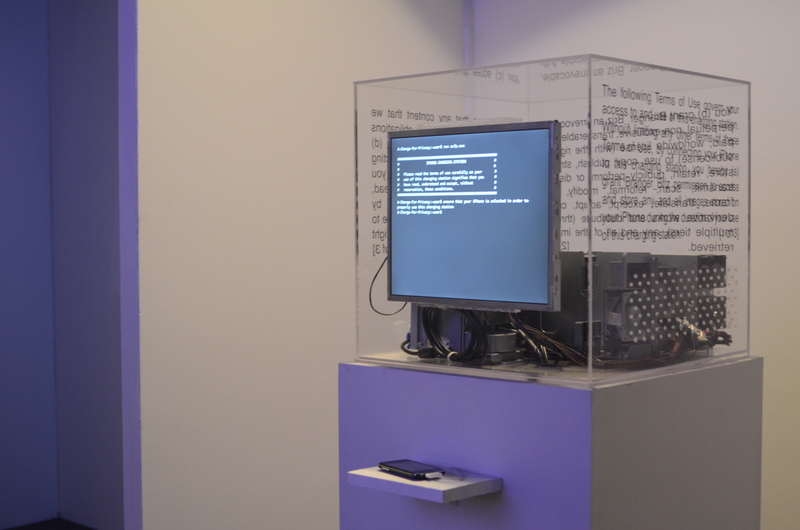
As you approach Furtherfield Gallery in the middle of London’s Finsbury Park, you will notice that the external walls have been transformed into an immersive installation of lush, rippling images of water lilies, leaves and other organic forms. Giverny Remediated is an installation of performative prints by Nathaniel Stern (US) continuing his ‘Compressionism’ series of work. Part of Stern’s Compressionist series, this work references Monet’s immersive painting installation Water Lilies, painted a century ago, only in this case the artist has strapped a hacked scanner to his body in order to create the works.

“Compressionism follows the trajectory of Impressionist painting, through Surrealism to Postmodernism, but rather than citing crises of representation, reality or simulation, my focus is on performing all three in relation to each other.”4
In a new commission Stern will create ‘Rippling Images of Finsbury Park’, a new public artwork created in the boating lake (which sits adjacent to Furtherfield Gallery). The artworks will be available to download by public USB installed in the Gallery walls as part of Dead Drop, the offline, anonymous, file sharing, peer to peer, network.5

Visitors can also download the essay that sets out many of the concepts behind this exhibition. ‘Interface Perception – The Cybernetic Mentality and Its Critics: ubermorgen.com’ by Søren Bro Pold (editor of Interface Criticism, Aesthetics Beyond Buttons) explores how we perceive interfaces and the role that art has to play in making technology more feelable.
Beyond The Interface – London is a remix of an exhibition co-curated by Furtherfield with Julian Stadon for ISMAR 2014, the International Symposium on Mixed and Augmented Reality, that took place in Munich in September 2014.
Happening alongside this exhibition
Scan the park
Dates June-July to be confirmed, Furtherfield Gallery
Workshops for all ages to hack your own scanner. Create your own rippling images of Finsbury Park based on the Nathaniel Stern commission. Also chance to show your work in Furtherfield Gallery. Please contact info@furtherfield.org to join the waiting list.
Telluro-geo-psycho-modulator workshop and field trip with Jonathan Kemp
2-3 May, Furtherfield Commons
How are our brain states modulated by the interference patterns created by our immersion in natural weak geomagnetic fields?
Living Assemblies – Design Your Silken Self
6 – 7 June, Furtherfield Commons
In partnership with The Arts Catalyst. A hands-on workshop with Veronica Ranner, investigating the coupling of the biological material silk, with digital technologies
WWW TV installation, Web We Want Festival
28-31 May, Southbank Centre, London
Featuring Grey Matter by Jennifer Chan and Facial Weaponization Communiqué: Fag Face by Zach Blas against a bank of monitors displaying videos found on the Web of contextual media, systems and products.
Back to the Future
Sunday 31 May 17:00 – 18:00, Queen Elizabeth Hall Front Room
To close the Web We Want festival, Jude Kelly CBE, Artistic Director of Southbank Centre is joined by Renata Avila (Web Foundation), Sarah T Gold (Alternet, WikiHouse Foundation) Ruth Catlow (Furtherfield) to recap the festival and look towards the next 25 years of the Web – what’s in store for the future and how can we make an impact on the shape of the Web?
Symposium: Designing Digital Creative Commons for the Performing Arts
27 June
Digital tools for communication, artistic collaboration, sharing and co-creation between artists, and creative audiences. Booking info to follow soon.
Museum of Contemporary Commodities
Running parallel to the exhibition is an artistic research project by Paula Crutchlow and Dr Ian Cook, exploring trade justice issues by presenting the things we buy today, as the heritage of tomorrow.
Walkshop led by data activist Dr Alison Powell
7 May 6-8.30pm, Furtherfield Commons
To find out more about the local retail environment, local commodities, trade-justice and data processes in Finsbury Park. As part of the Museum of Contemporary Commodities.
Commodity Culture social event
Saturday 13 June 11am-3pm, Furtherfield Commons
Drop-in for cake and a cup of something, and a chat about trade and exchange in Finsbury Park. Open to everyone. As part of the Museum of Contemporary Commodities.

Zach Blas is an artist, writer, and curator whose work engages technology, queerness, and politics. Currently, he is an Assistant Professor in the Department of Art at the University at Buffalo. His work has been written about and featured in Art Review, Frieze, Art Papers, Hyperallergic, Rhizome, Mousse Magazine, The Atlantic, Al Jazeera America, The New Inquiry, Leonardo Electronic Almanac, and Wired. http://www.zachblas.info/
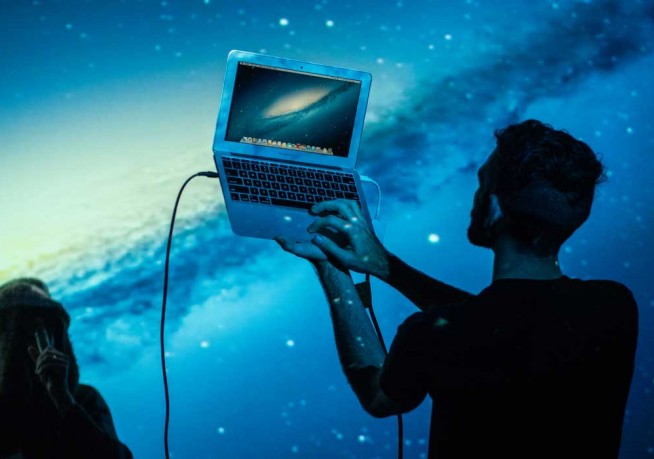
Branger_Briz are artists, educators && programmers bent on articulating our digital landscape creating memorable interactive projects for themselves && clients. To them contemporary culture means digital culture. They are driven by a desire to share our digital literacies, so their work tends to be public-facing && leverage new-media. They specialise in producing custom projects from concept >> design >> development >> launching/sharing && love every step in the process.
http://brangerbriz.com/

Mez Breeze is an Australian-based artist and practitioner of net.art, working primarily with code poetry, electronic literature, and digital multimedia works combining text, code, image and sound. Born Mary- Anne Breeze, she uses a number of avatar nicknames, including Mez and Netwurker. As of May 2014, Mez is the only digital writer who’s a non- USA citizen to have her comprehensive career archive (called “The Mez Breeze Papers”) housed at Duke University, through their David M. Rubenstein Rare Book & Manuscript Library.
http://mezbreezedesign.com/
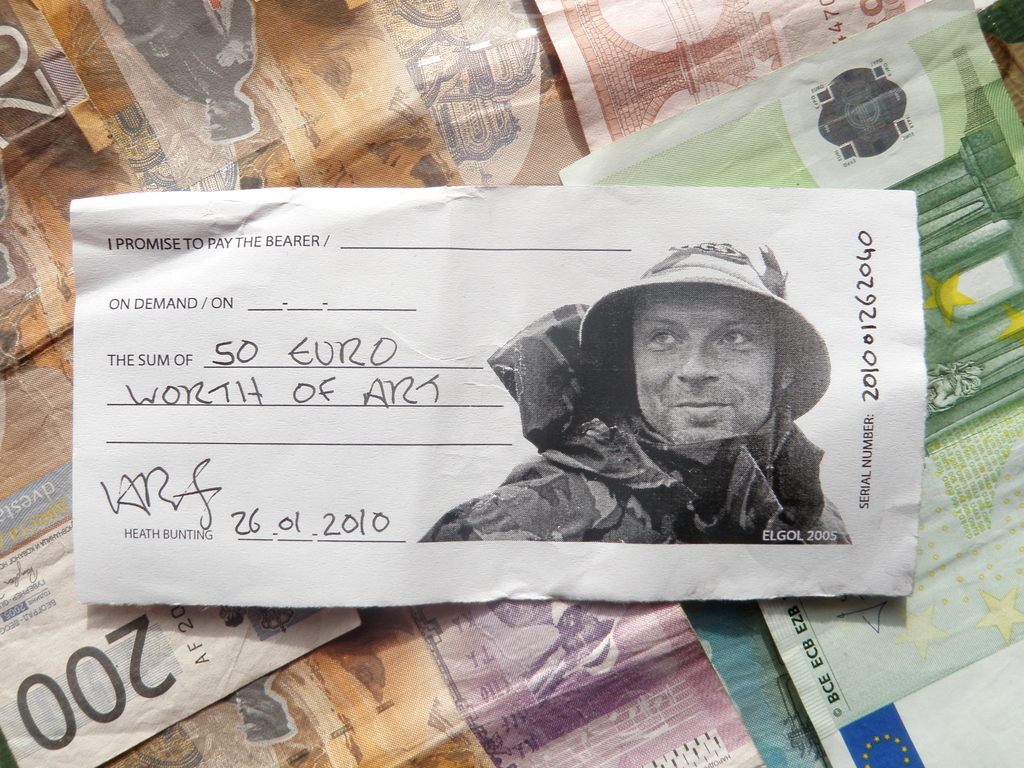
Heath Bunting was born a Buddhist in Wood Green, London, UK and is able to make himself laugh. (currently, reduced to only smile) He is a co-founder of both net.art and sport-art movements and is banned for life from entering the USA for his anti genetic work. His self taught and authentically independent work is direct and uncomplicated and has never been awarded a prize. He is both Britain’s most important practising artist and the World’s most famous computer artist.
http://www.irational.org/heath/
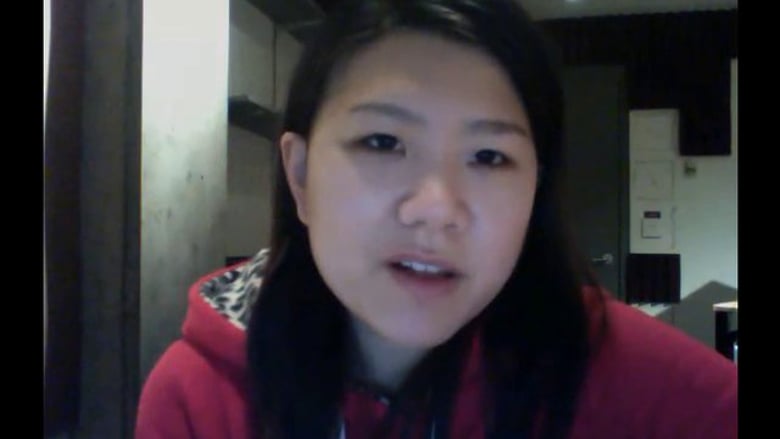
Jennifer Chan makes remix videos, gifs and websites that contend with gendered affects of media culture. Chan had solo presentations at the Marshall McLuhan Salon in the Embassy of Canada in Berlin for Transmediale 2013 (Germany), Future Gallery (Berlin), Images Festival (Toronto), Vox Populi (Philadelphia) and recently LTD (Los Angeles). She has a HBA in Communications, Culture, Information Technology from University of Toronto and a MFA in Art Video from Syracuse University. Chan was born in Ottawa, raised in Hong Kong, and is now based in Chicago. She co-organizes Dorkbot Chicago and helps women learn code at Girl Develop It. http://jennifer-chan.com/

Francesca da Rimini explores the poetic and political possibilities of collaborative (tel)embodied play. Early net projects include GashGirl, FleshMeat and the award-winning labyrinth dollspace. As cyberfeminist VNS Matrix member she inserted slimy interfaces into Big Daddy Mainframe’s databanks, perturbing the (gendered) techno status quo. Her doctoral thesis at the University of Technology Sydney investigated three diverse cultural activism projects seeding the formation of new collective subjects. She has co-authored Disorder and the Disinformation Society: The Social Dynamics of Information, Networks and Software (Routledge 2015). http://gashgirl.sysx.org
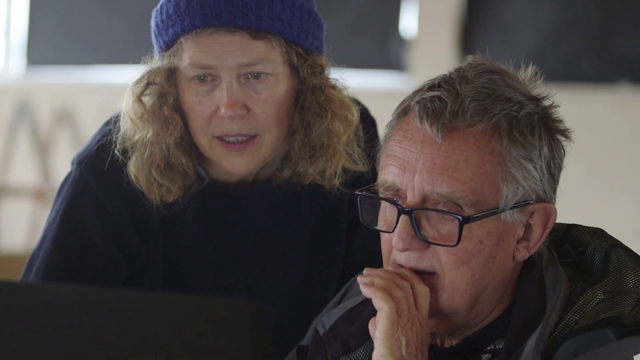
Genetic Moo (Nicola Schauerman and Tim Pickup) have been creating individual interactive art works for over 5 years. They create Microworlds, digital ecosystems and living installations that are always changing, mutating, and evolving in front of your eyes. Both gained Masters degrees from the Lansdown Centre for Electronic Arts. They have exhibited extensively in galleries, festivals and museums.
http://www.geneticmoo.com

Nathaniel Stern is an artist and writer, Fulbright grantee and professor, interventionist and public citizen. He has produced and collaborated on projects ranging from ecological, participatory and online interventions, interactive, immersive and mixed reality environments, to prints, sculptures, videos, performances and hybrid forms.
His book, Interactive Art and Embodiment: The Implicit Body as Performance, takes a close look at the stakes for interactive and digital art, and his ongoing work in industry has helped launch dozens of new businesses, products and ideas.
http://nathanielstern.com
Beyond the Interface – Artists Panel
Web We Want Festival – Southbank Centre
28-31 May 2015
Chair – Ruth Catlow
Speakers (TBC)
EXHIBITION LOCATION
Furtherfield Gallery
McKenzie Pavilion, Finsbury Park
London N4 2NQ
T: +44 (0)20 8802 2827
E: info@furtherfield.org
Visiting information
PANEL LOCATION
Southbank Centre
Belvedere Road, London SE1 8XX
Directions
FOR MORE INFORMATION
Contact Ruth Catlow, Furtherfield
Part of Furtherfield Open Spots programme.
being being read being reading being read and reading beings
A twisted archive of the mind, language and technology project: Torque – presented via the lens of its current research: *reading*
Try:
Animated speed-reading software.
‘Code Karaoke’ with live-coding artist Yaxu (11th April).
The new ‘Outlier’ app that sonifies reading using algorithmic sentiment analysis, by Wesley Goatley.
Record a super-slo-mo reading and broadcast it across the park.
Pick-up for free and read:
A newspaper on privacy, surveillance and ‘being read’ in the age of big data and online lives.
Receipt artworks by James Wilkes (Wellcome Collection resident artist).
Or just soak up the rampant textuality of:
Live readings from performance artist Tim Etchells and remote performance by Yaxu (11th April) and artist writer Claire Potter, with virtual appearance by Mez Breeze (18th April).
Sound work entitled ‘Mind Twist’ by Dennis Oppenheim on the exterior of the gallery.
Experimental text works from Anna Barham, Tim Etchells and Imogen Stidworthy.
A new text-based cgi video artwork by Chris Boyd.
Sound work of Karl Heinz Jeron’s opera singing robot Sim Gishel.
Video and text works by Torque producers Nathan Jones and Sam Skinner, including commissioned score by musician Oliver Coates.
The launch of a new book entitled ‘The Act of Reading’, comprising new essays and artworks on the subject, including a new text by reader/author extraordinaire Katherine Hayles, entitled, ‘Nonconscious Cognition and Jess Stoner’s I have Blinded Myself Writing This’ and further contributions from: Garrett Stewart, Soenke Zehle, Erica Scourti, Stephen Fortune, Esther Leslie, Nina Power, Charles Bernstein, Claire Potter, James Wilkes, Eleanor Rees, Anna Barham and others.
What does it all mean?… well come on down, bury your head in the book, pdf, audio, sentiment analysed and sonified, or speed reading versions… and find out!
It may all sound a bit strange, but that’s the world we live in now and how we read today! 😉
Live Reading #1 – Tim Etchells and Yaxu, 3pm, Saturday 11th April. (Free)
Live Reading #2 – Claire Potter and Mez Breeze, 3pm Saturday 18th April. (Free)
(Yaxu and Mez Breeze remote/online performance)
Furtherfield Gallery
McKenzie Pavilion, Finsbury Park
London N4 2NQ
T: +44 (0)20 8802 2827
E: info@furtherfield.org
Furtherfield Gallery is supported by Haringey Council and Arts Council England
Torque is a transdisciplinary project by artists Nathan Jones and Sam Skinner, that explores the twisting of mind, language and technology, through publications, symposia, performance, workshops and installation.
At Furtherfield, each of the three gallery spaces will be transformed into a three-dimensional manifestation and archive of the three publications and public research Torque have produced to date. The gallery will become a hypermedia reading room and examination of both reading and the Torque project itself, giving members of the public a deep and varying view of the pressures impacting our relationship to language, and in particular – reading – as it occurs today.
Room 1 will be dedicated to the Torque #1 publication.
Room 2 will present The Opticon newspaper – produced over two days at Tate Liverpool, focusing on themes of privacy and surveillance, in particular machinic reading, big data and the phenomenology of ‘being read’. Comprising contributions from over 100 gallery visitors, poets, artist Erica Scourti and professor of social media Christian Fuchs.
Room 3 will launch a new transdisciplinary digital and print publication exploring reading today, and the impact of technology upon it, following The Act of Reading symposium at FACT, Liverpool and a performance event at Static Gallery. This room will also feature new video works by Jones and Skinner synthesizing and investigating reading-related pathologies and pedagogical systems.
Jones and Skinner will be in the gallery throughout the exhibition presenting and speaking about their work, and developing new works informed by their experiences and conversations.
Torque project tumblr here
Free download of Torque #1 book and printed edition available here.
Digital version of The Opticon newspaper here
Torque is supported by an Arts Council England Grants for the Arts, Tate Liverpool and FACT.
These days, drones are everywhere: conducting military strikes across Pakistan, Yemen, Somalia and Afghanistan; as the underpinning technology for public health infrastructure; for sale to delighted kids in Hamleys toyshop; or as D.I.Y kits and readymades from the Internet. Amazon has proposed to sell fleets of drones, offering super-fast deliveries to its customers.[1] In Haiti, Bhutan, Papua New Guinea and the Philippines, drones have helped rescue natural disaster victims – and transport medical samples and supplies[2] and the Aerial Robotics Laboratory at Imperial College London is developing networks of drones to deliver blood supplies to rural health clinics in Africa[3]. The new ubiquity of drones in these contexts means that we need to think carefully about the personal and political impacts of the emerging drone culture?
Drones: Eyes From A Distance will be the first gathering in Berlin- April 17-18 2015 – of the Disruption Network Lab. This two day symposium presents keynote presentations, panels, round tables, and a film screening held in cooperation with Kunstraum Kreuzberg /Bethanien, with the support of the Free Chelsea Manning Initiative. The event is being held at the Sudio 1 of Kunstquartier Bethanien. And this conference would not be happening if it wasn’t for the tireless dedication of Tatiana Bazzichelli, founder of the Disruption Lab.
As part of Furtherfield’s partnership with the Disruption Network Lab I will chair a panel with Tonje Hessen Schei (filmmaker, NO), Jack Serle (investigative journalist, UK), Dave Young (artist, musician and researcher, IE).This interview with Dave Young is the first of three, in the lead up to the Berlin event.
Dave Young is an artist and researcher based in Edinburgh. His practice follows critical research into digital culture, manifested through workshops, website development, and talks on subjects varying from cybernetics and the Cold War history of network technologies, to issues around copyright and open source/free culture. He is founder of Localhost, a forum for discussing, dismantling and disrupting network technologies. Past events have focused on Google’s entry into media art curation, and the role of analogue radio as a potential commons in the digital age.

Marc Garrett: Hello Dave, I first met you in London when you hosted the Movable Borders: The Reposition Matrix Workshop’s at Furtherfield Gallery in 2013 as part of a larger exhibition called Movable Borders: Here Come the Drones! I remember it well, because the exhibition and your workshops were very well attended and a cross section of the local community came along and got involved. Could you tell us what your workshops consisted of and why you did them?
Dave Young: The workshop series came out of my own research into the history of cybernetics and networked military technologies while I was studying at the Piet Zwart Institute in Rotterdam. The US Military’s use of drones in the War on Terror had been officially acknowledged by the Obama administration by this time, and I was becoming increasingly curious about the apparent division of labour and accountability involved in the so-called ‘kill chain’ – that is, the structure and protocols that lead from identification of a potential target to a ‘kinetic strike’. As the use of drones was still largely a covert effort, there was much speculation in the media about where and how they were being used, so the idea of exploring these issues in a workshop format seemed to be a good way to create a public space for considered discussion and debate.
The workshops had quite an open format, with outcomes largely dependent on the interests and knowledge of the participants. The central task of each workshop was to collectively research a particular aspect of the military use of drones, and through the process of charting this research on a world map, we could then begin to discuss various geopolitical patterns and trends as they emerged. Rooting the workshop in this act of collaborative mapping provided an interface for discussing drones in specific terms, and helped situate their use within the reality of an incredibly complex historical and geopolitical narrative. To me, this provided a useful alternative to the mainstream media reporting styles that seemed to often rely on the same metaphors and controversies in the absence of real information coming through official sources.
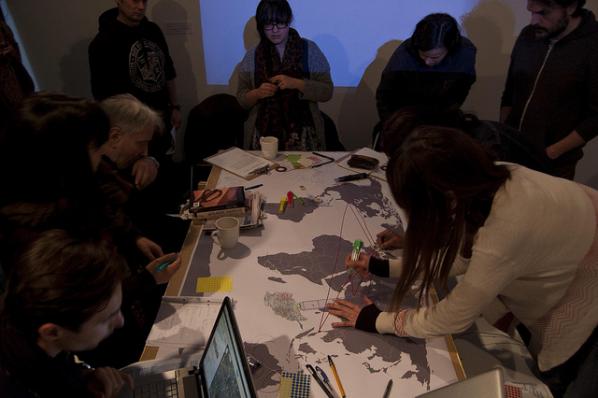
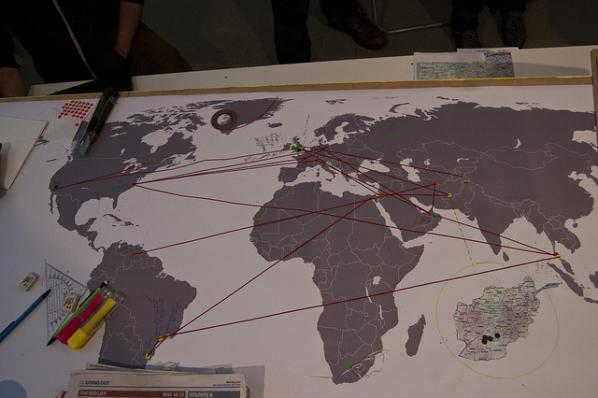
MG: What are the specific concerns you have regarding the development of drones and how do you think these conditions can be changed for the better?
DY: This is a question I was more sure of before I started the workshop series – I feel the more I’ve gained an understanding of the way they’re used, the less sure I am of what needs to change. I see the drone as a symbol for the way conflict is understood post 9-11. It is part of the language, aesthetics, and transnational politics of the War on Terror. What is most concerning to me is the idea that the drone allows a state to fight a war while apparently sidestepping the otherwise necessary apparatuses of legality and oversight. As a covert weapon, it can be implemented in exceptional, extra-judicial ways that have not been legislated for as yet. The “targeted strike” and “signature strike”, while distinct from each other in protocol and circumstance, are particularly problematic – the former amounts to what many journalists describe as an assassination, although this word is rejected by the US government.
The CIA Torture Report released at the end of last year was an important acknowledgement of institutional subversions of legal and moral codes. I’d expect that a similar report into the use and effects of military drones would create space for an informed public debate about how they might be used in the future.
MG: Regarding you own relation and interests around drone and military culture, what are your plans in the near future?
DY: The outcomes of The Reposition Matrix have led me to approach this issue in a different way, looking for alternative ways of instigating conversations around this difficult subject. I’m still quite occupied with issues around the collection and presentation of data – during the workshops we covered a lot of diverse subjects, but always situating research outcomes on the surface of a world map. The question for me right now is what information is important to work with, and how can it be usefully represented? I’m looking at alternative methods of “mapping”, perhaps based in mapping technologies/software but using them in more disruptive non-geographic ways. I’ve been quite inspired by Metahaven’s ‘Sunshine Unfinished’ and the recently published book ‘Cartographies of the Absolute’ – both works have brought me back to some possibilities that went unexplored in the initial run of workshops back in 2013.
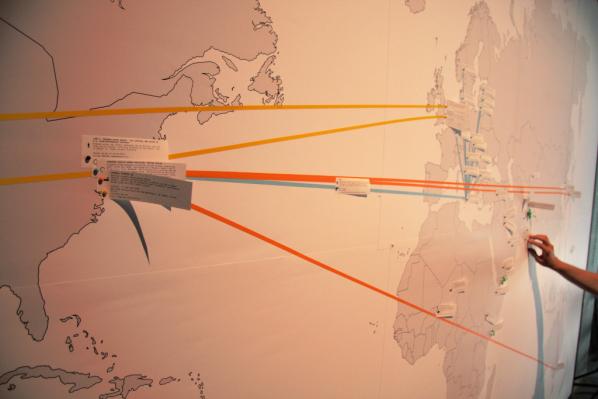

MG: What other projects are you involved in?
DY: Aside from this research, I’m currently collaborating on a project titled “Cursor” with Jake Watts and Kirsty Hendry as part of New Media Scotland’s Alt-W fund. We’re investigating current trends in fitness tracking technologies, and attempting to uncover and critique the way such intimate personal data is produced, distributed, and commodified. You can follow our research as it evolves on http://cursorware.me
I’m also running a space here in Edinburgh called Localhost, with the aim of stimulating discussions around the political aspects of digital art/culture. I run regular workshops and more occasionally special events, but I’m also very happy to provide a platform for others who wish to share their thoughts & skills on related subjects. Check http://l-o-c-a-l-h-o-s-t.com/ for more information and how to get involved.
Thank you very much 🙂
Daniel Rourke: At Furtherfield on November 22nd 2014 you launched a Beta version of a networked project, 6PM Your Local Time, in collaboration with Fabio Paris, Abandon Normal Devices and Gummy Industries. #6PMYLT uses twitter hashtags as a nexus for distributed art happenings. Could you tell us more about the impetus behind the project?
Domenico Quaranta: In September 2012, the Link Art Center launched the Link Point in Brescia: a small project space where, for almost two years, we presented installation projects by local and international artists. The Link Point was, since the beginning, a “dual site”: a space where to invite our local audience, but also a set for photographic documentation meant to be distributed online to a global audience. Fabio Paris’ long experience with his commercial gallery – that used the same space for more than 10 years, persuaded us that this was what we had to offer to the artists invited. So, the space was reduced to a small cube, white from floor to ceiling, with neon lights and a big logo (a kind of analogue watermark) on the back door.
Thinking about this project, and the strong presence of the Link Point logo in all the documentation, we realized that the Link Point was actually not bound to that space: as an abstract, highly formalized space, it could actually be everywhere. Take a white cube and place the Link Point logo in it, and that’s the Link Point.
This realization brought us, on the one hand, to close the space in Brescia and to turn the Link Point into a nomad, erratic project, that can resurrect from time to time in other places; and, on the other hand, to conceive 6PM Your Local Time. The idea was simple: if exhibition spaces are all more or less similar; if online documentation has become so important to communicate art events to a wider audience, and if people started perceiving it as not different from primary experience, why not set up an exhibition that takes place in different locations, kept together only by documentation and by the use of the same logo? All the rest came right after, as a natural development from this starting point (and as an adaptation of this idea to reality).
Of course, this is a statement as well as a provocation: watching the documentation of the UK Beta Test you can easily realize that exhibition spaces are NOT more or less the same; that attending or participating in an event is different from watching pictures on a screen; that some artworks work well in pictures but many need to be experiences. We want to stress the value of networking and of giving prominence to your network rather than to your individual identity; but if the project would work as a reminder that reality is still different from media representation, it would be successful anyway.
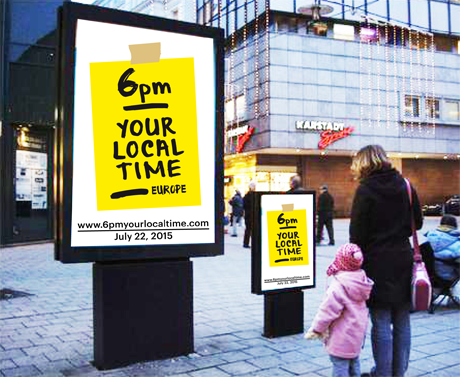
Daniel Rourke: There is something of Hakim Bey’s Temporary Autonomous Zones in your proposal. The idea that geographic, economic and/or political boundaries need no longer define the limits of social collective action. We can criticise Bey’s 1991 text now, because in retrospect the Internet and its constitutive protocols have themselves become a breeding ground for corporate and political concerns, even as technology has allowed ever more distributed methods of connectivity. You foreground network identity over individual identity in the 6PM YLT vision, yet the distinction between the individuals that create a network and the corporate hierarchies that make that networking possible are less clear. I am of course gesturing towards the use of Twitter as the principal platform of the project, a question that Ruth Catlow brought up at the launch. Do you still believe that TAZs are possible in our hyper-connected, hyper-corporate world?
Domenico Quaranta: In its first, raw conceptualization, 6PM YLT had to come with its own smartphone app, that had to be used both to participate in the project and to access the gallery. The decision to aggregate content published on different social platforms came from the realization that people already had the production and distribution tools required to participate in the action, and were already familiar with some gestures: take a photo, apply a filter, add an hashtag, etc. Of course, we could invite participants and audiences to use some specific, open source social network of our choice, but we prefer to tell them: just use the fucking platform of your choice. We want to facilitate and expand participation, not to reduce it; and we are not interested in adding another layer to the project. 6PM YLT is not a TAZ, it’s just a social game that wants to raise some awareness about the importance of documentation, the power of networks, the public availability of what we do with our phones. And it’s a parasitic tool that, as anything else happening online, implies an entire set of corporate frameworks in order to exist: social networks, browsers, operative systems, internet providers, server farms etc.
That said, yes, I think TAZs are still possible. The model of TAZ has been designed for an hyper-connected, hyper-corporate world; they are temporary and nomadic; they exist in interstices for a short time. But I agree that believing in them is mostly an act of faith.
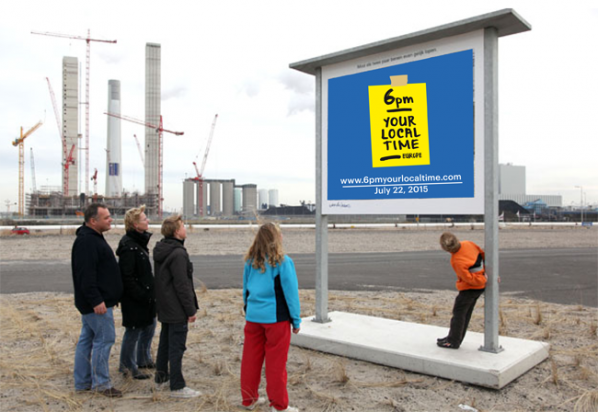
Daniel Rourke: The beta-tested, final iteration of 6pm YLT will be launched in the summer of 2015. How will you be rolling out the project in the forthcoming months? How can people get involved?
Domenico Quaranta: 6PM Your Local Time has been conceived as an opportunity, for the organizing subject, to bring to visibility its network of relationships and to improve it. It’s not an exhibition with a topic, but a social network turned visible. To put it simply: our identity is defined not just by what we do, but also by the people we hang out with. After organizing 6PM Your Local Time Europe, the Link Art Center would like to take a step back and to offer the platform to other organizing subjects, to allow them to show off their network as well.
So, what we are doing now is preparing a long list of institutions, galleries and artists we made love with in the past or we’d like to make love with in the future, and inviting them to participate in the project. We won’t launch an open call, but we already made the event public saying that if anyone is interested to participate, they are allowed to submit a proposal. We won’t accept anybody, but we would be happy to get in touch with people we didn’t know.
After finalizing the list of participants, we will work on all the organizational stuff, basically informing them about the basic rules of the game, gathering information about the events, answering questions, etc.
On the other hand, we have of course to work on the presentation. While every participant presents an event of her choice, the organizer of a 6PM Your Local Time event has to present to its local audience the platform event, as an ongoing installation / performance. We are from Brescia, Italy, and that’s where we will make our presentation. We made an agreement with MusicalZOO, a local festival of art and electronic music, in order to co-produce the presentation and have access to their audience. This is what determined the date of the event in the first place. Since the festival takes place outdoor during the summer, we are working with them on designing a temporary office where we can coordinate the event, stay in touch with the participants, discuss with the audience, and a video installation in which the live stream of pics and videos will be displayed. Since we are expecting participants from Portugal to the Russian Federation, the event will start around 5 PM, and will follow the various opening events up to late night.
One potential reference for this kind of presentation may be those (amazing) telecommunication projects that took place in the Eighties: Robert Adrian’s The World in 24 Hours, organized at Ars Electronica in 1982; the Planetary Network set up in 1986 at the Venice Biennale; and even Nam June Paik’s satellite communication project Good Morning Mr Orwell (1984).
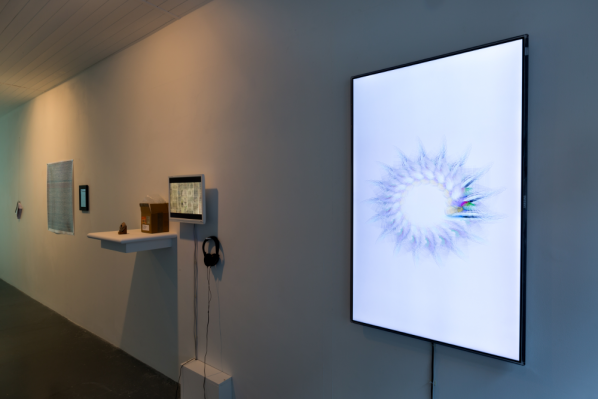
Daniel Rourke: Your exhibition Unoriginal Genius, featuring the work of 17 leading net and new media artists, was the last project to be hosted in the Carroll/Fletcher Project Space (closing November 22nd, 2014). Could you tell us more about the role you consider ‘genius’ plays in framing contemporary art practice?
Domenico Quaranta: The idea of genius still plays an important role in Western culture, and not just in the field of art. Whether we are talking about the Macintosh, Infinite Jest, a space trip or Nymphomaniac, we are always celebrating an individual genius, even if we perfectly know that there is a team and a concerted action behind each of these things. Every art world is grounded in the idea that there are gifted people who, provided specific conditions, can produce special things that are potentially relevant for anybody. This is not a problem in itself – what’s problematic are some corollaries to our traditional idea of genius – namely “originality” and “intellectual property”. The first claims that a good work of creation is new and doesn’t depend on previous work by others; the second claims that an original work belongs to the author.
In my opinion, creation never worked this way, and I’m totally unoriginal in saying this: hundreds of people, before and along to me, say that creating consists in taking chunks of available material and assembling them in ways that, in the best situation, allow us to take a small step forward from what came before. But in the meantime, entire legal systems have been built upon such bad beliefs; and what’s happening now is that, while on the one hand the digitalization of the means of production and dissemination allow us to look at this process with unprecedented clarity; on the other hand these regulations have evolved in such a way that they may eventually slow down or stop the regular evolution of culture, which is based on the exchange of ideas.
We – and creators in particular – have to fight against this situation. But Unoriginal Genius shouldn’t be read in such an activist way. It is just a small attempt to show how the process of creation works today, in the shared environment of a networked computer, and to bring this in front of a gallery audience.
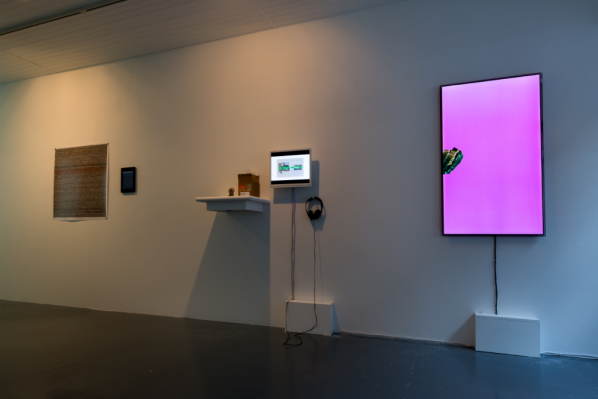
Daniel Rourke: So much online material ‘created’ today is free-flowing and impossible to trace back to an original author, yet the tendency to attribute images, ideas or ‘works’ to an individual still persists – as it does in Unoriginal Genius. I wonder whether you consider some of the works in the show as more liberated from authorial constraints than others? That is, what are the works that appear to make themselves; floating and mutating regardless of particular human (artist) intentions?
Domenico Quaranta: Probably Museum of the Internet is the one that fits best to your description. Everybody can contribute anonymously to it by just dropping images on the webpage; the authors’ names are not available on the website, and there’s no link to their homepage. It’s so simple, so necessary and so pure that one may think that it always existed out there in some way or another. And in a way it did, because the history of the internet is full of projects that invite people to do more or less the same.
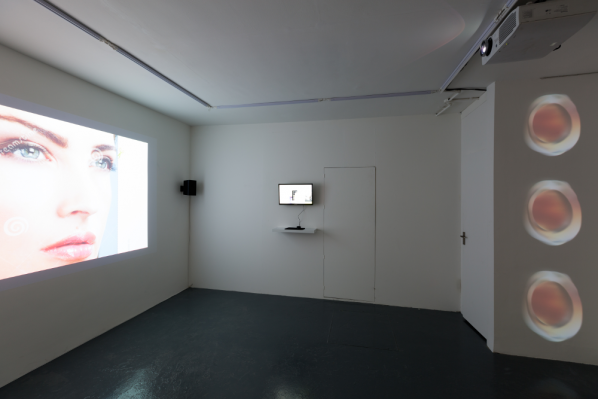
Daniel Rourke: 2014 was an exciting year for the recognition of digital art cultures, with the appointment of Dragan Espenschied as lead Digital Conservator at Rhizome, the second Paddles On! auction of digital works in London, with names like Hito Steyerl and Ryan Trecartin moving up ArtReview’s power list, and projects like Kenneth Goldsmith’s ‘Printing out the Internet’ highlighting the increasing ubiquity – and therefore arguable fragility – of web-based cultural aggregation. I wondered what you were looking forward to in 2015 – apart from 6PM YLT of course. Where would you like to see the digital/net/new media arts 12 months from now?
Domenico Quaranta: On the moon, of course!
Out of joke: I agree that 2014 has been a good year for the media arts community, as part of a general positive trend along the last few years. Other highlighs may include, in various order: the September 2013 issue of Artforum, on “Art and Media”, and the discussion sparked by Claire Bishop’s essay; Cory Arcangel discovering and restoring lost Andy Warhol’s digital files from floppy disks; Ben Fino-Radin becoming digital conservator at MoMA, New York; JODI winning the Prix Net Art; the Barbican doing a show on the Digital Revolution with Google. Memes like post internet, post digital and the New Aesthetic had negative side effects, but they helped establishing digital culture in the mainstream contemporary art discourse, and bringing to prominence some artists formerly known as net artists. In 2015, the New Museum Triennial will be curated by Lauren Cornell and Ryan Trecartin, and DIS has been announced to be curator of the 9th Berlin Biennial in 2016.
All this looks promising, but one thing that I learned from the past is to be careful with optimistic judgements. The XXI century started with a show called 010101. Art in Technological Times, organized by SFMoMA. The same year, net art entered the Venice Biennale, the Whitney organized Bitstreams and Data Dynamics, the Tate Art and Money Online. Later on, the internet was announced dead, and it took years for the media art community to get some prominence in the art discourse again. The situation now is very different, a lot has been done at all levels (art market, institutions, criticism), and the interest in digital culture and technologies is not (only) the result of the hype and of big money flushed by corporations unto museums. But still, where we really are? The first Paddles On! Auction belongs to history because it helped selling the first website ever on auction; the second one mainly sold digital and analogue paintings. Digital Revolution was welcomed by sentences like: “No one could fault the advances in technology on display, but the art that has emerged out of that technology? Well, on this showing, too much of it seems gimmicky, weak and overly concerned with spectacle rather than meaning, or making a comment on our culture.” (The Telegraph) The upcoming New Museum Triennial will include artists like Ed Atkins, Aleksandra Domanovic, Oliver Laric, K-HOLE, Steve Roggenbuck, but Lauren and Ryan did their best to avoid partisanship. There’s no criticism in this statement, actually I would have done exactly the same, and I’m sure it will be an amazing show that I can’t wait to see. Just, we don’t have to expect too much from this show in terms of “digital art recognition”. So, to put it short: I’m sure digital art and culture is slowly changing the arts, and that this revolution will be dramatic; but it won’t take place in 2015 🙂
Featured image: System Map by Andrea Crespo, 2015, image
Fear is easily attributable to a cause—we fear something in particular. Anxiety, however, can be described as fear without the source. Yet, anxiety is also a safety mechanism. Without it, we would walk in the face of danger. In the online exhibition Body Anxiety, curated by Leah Schrager and Jennifer Chan, the disquiet is experienced in the flesh, whether this is as a symptom or sublimation.
Whatever your gender, your body is politicised in ways you cannot control. If you are female, or gender queer, there is also a fight against power. The works in Body Anxiety specifically problematise the image of women in the media and in the art world. Women artists, they claim with good arguments, are powerless; sothe show gives time and space to a group of artists the curators call ‘female painters’. Even though few paint (in fact, probably only Schrager herself does), Schrager puts forward the argument of painting as the highest artistic form, one dominated my males. She recontextualises painting for this exhibition, where most artists use their own bodies as canvases for video performances, sound works, photographs and writing. Perhaps this is peinture féminine to Helene Cixous’ écriture féminine.
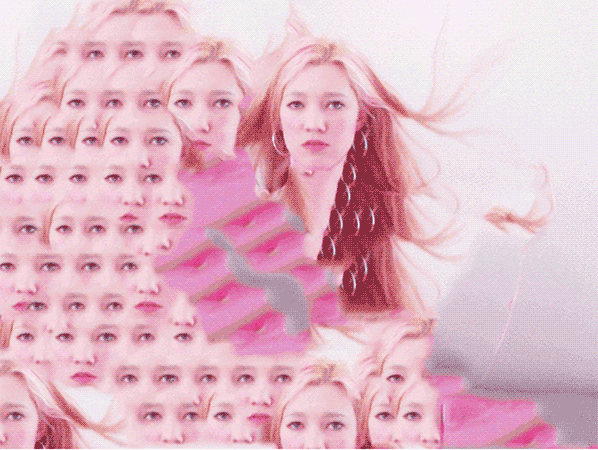
Good examples of the symptomatic are Victoria Campbell’s The Penelope Files, an auto-interview video with a reflexive sound monologue where she explores her thoughts on images of herself while browsing through her computer files. We hear her; we only see the screen. Exploring her relation to image, authorship, labour and the body, something about photography is revealed in the repetitive moving of files on her desktop’s finder window. Narrative also inhabits the work of Randon Rosenbohm. She presents a scan of a handwritten diary entry where artistic labour, exploitation and male artists feature. Her other work consists of a tumblr blog of rejected selfies. Both are pieces we should not see. This is also the case in Ann Hirsh’s video. Dance party just us girls shows footage that should be for private consumption, part of a home video, a laugh, documentation of a personal exploration. Using generic distorting video software available in most computers, the two-channel work shows the torso of a woman bobbing away to a song next to an image of moving genitalia, in a feminist version of Courbet’s painting The origin of the world. The two images share a pair of glasses and the genitalia is converted into a talking face, like in Denis Diderot’s libertine novel The Indiscreet Jewels.
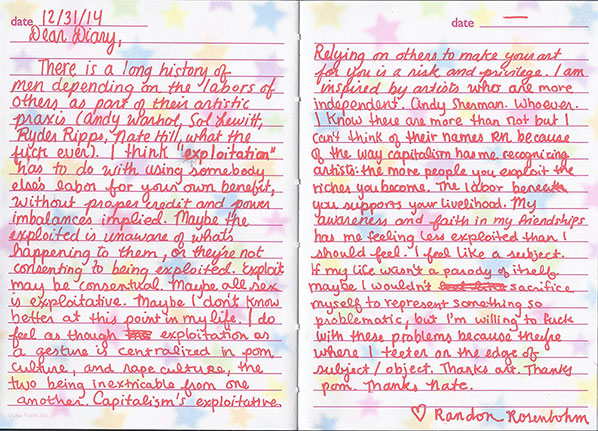
Saoirse Walls’ Den Perfekte Saoirse(2012) quotes Jurgen Leth’s The Perfect Human. She replicates some of the famous body poses and music from the classic black and white film, showing us the best of her individual self in a sublimation. She can do a side crow, twerk, walk in heels and, thanks to camera tricks, have a 100% symmetrical face. The work gets more and more bizarre with the appearance of make up and hair extensions. Where has Leth’s serious exploration of perfection gone in her quote? What are we demanding of Saoirse Walls? Another good example of an impossible demand and how this conflict is shown in a work of art is Nancy Leticia’s video. Her youthful, gorgeous self plays piano in her underwear. She plays very well, but how does this relate to the image setting?
Screenshot of Den Perfekte Saoirse by Saoirse Wall, 2012, video, 2:22 mins
The writer Marie Calloway—an alt lit writer, also a female painter in the way Schrager intends—features in Rachel Rabbit White’s work A Story In The Shape Of A Selfie Of The Writer And Her Friend, Marie Calloway. Her writing with images addresses the issue of anxiety head on. ‘Refresh’, ‘refresh’, ‘refresh’, she writes at the end of a blog post-merging stories about Marie, public events, selfies, feminist writers and artists, and social media.
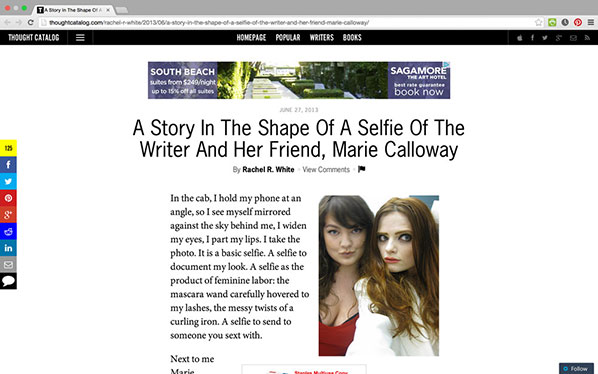
These diverse works are playful, at times irreverent, and certainly thought provoking. The curation is purposeful, direct and erudite. Yet, I have some issues with the display, with the sidebar prefaced by curatorial statements and with links to the artists’ biographies and websites. It feels more a catalogue than an exhibition. I don’t have a solution, though, as maybe this is a constraint of the medium. A few of the works are hosted on external websites—vimeo, red tube. Some of them even require passwords and this provokes a particular way of looking, a gaze, then a click, a search away from what is presented in front of us. I am an active viewer, often in the position of a Peeping Jane.
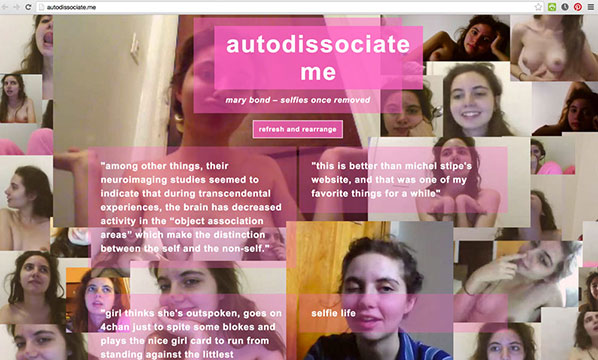
In her 1975 essay ‘Visual Pleasure and Narrative Cinema’ Laura Mulvey examines scopophilia, the pleasure in looking. This is not an innocent act. She argued that the relation between looker and looked is unequal in cinema, with woman as image and man as bearer of the look. If woman is a ‘one dimensional fetish’, as Mulvey writes (a thought which will be later echoed in Nina Power’s 2009 book One Dimensional Woman), the artists in Body Anxiety take this to its hysterical consequences, attempting to break the Master-Slave bond, making woman image AND bearer of the look. Let me return to the title for a moment. Anxiety, Sigmund Freud wrote, is neurotic fear, as distinct from real fear. So one is a reality, something tangible and worthy of our concern whereas the other sounds like is made up, accusation of fabrication (like hysteria). It is this last idea the show is trying to contend. The anxiety felt and displayed in these bodies, the imperative to conform to a certain standard and behaviour, the manipulation of femaleness in pornography, the shutting down of the woman’s voice are indeed neurotic, but not because of it they are less real. As a body of work, the exhibition is convincing and raises clear issues around female empowerment, agency and exploitation, and how these are linked to flesh. Converting the anxiety into an intelligible fear that can be stood up against, as these artists do, might be the first step towards overcoming it.
Featured image: Helen Varley Jamieson performing “make-shift,” Brisbane, 2012; photo by Suzon Fuks
“Overlapping and fluid spaces… spaces emerging between physical realities and the ethereal digital / electric space: a third space grafted from the real-time confluence of the stage + remote locations.” – Helen Varley Jamieson
Cyberformance artist Helen Varley Jamieson is creating a new Internet performance work, “we r now[here]”* for the Art of the Networked Practice | Online Symposium (March 31 – April 2). The title and description of the work poetically articulate her thinking on networked space (third space) as a medium for online theatrical experimentation: “‘we r now[here]’ is about nowhere and somewhere: the ‘nowhere’ of the Internet becomes ‘now’ and ‘here’ through our virtual presence.” (* Special thanks to Annie Abrahams who provided the title for the work: “we r now[here],” and to Curt Cloninger who inspired it.)
To set the “stage” for this new work, we discuss Helen’s pioneering achievements in the genre she has coined as cyberformance: the combination of cybernetics and cyberspace with performance. Helen has created a rich body of online theater work dating back to 1999, when dial-up modems were still the operable connection, long before Skype and Google Hangout became popular Web-conferencing tools. As one of the founders of UpStage, an open source platform for online theatrical presentation, Helen is a leading catalyst, researcher, director, and maker who for years has been reimagining the Internet as a global space for theater and performance.
****
Randall Packer: You coined the term cyberformance in the early 2000s after discovering the potential of the Internet as a medium for live performance. What were your first steps in rethinking live theater for ethereal, networked “third space?”
Helen Varley Jamieson: When I first started working with Desktop Theatre and experienced the intense liveness of our interactions despite being physically separated by thousands of miles, I understood that it was possible to feel a quite visceral sense of presence and real-time connection via the internet. We were improvising and performing in The Palace, a graphic-sonic chat application, and our audiences were mostly other “Palatians” – who weren’t always particularly interested in what we were doing. I began to think about how we could bring this work to a theatre audience, people who wanted to see a performance. The first time I tried this was at Odin Teatret in Denmark at a Magdalena Project festival, with a short performance that aimed to demonstrate the possibilities of cyberformance. Adriene Jenik and Lisa Brenneis from Desktop Theatre were performing with me from California, in The Palace which was projected onto a screen. I was using someone’s mobile phone for the internet connection as this was 2001 and there wasn’t internet throughout the building at that time. Afterwards, a heated debate erupted amongst the audience (who were theatre practitioners) about whether or not this could be called theatre. This experience challenged me to question whether or not cyberformance was “theatre” (which of course required first answering the question, what is “theatre”?): how is technology changing our definitions of “theatre”? and what place does cyberformance have within theatre?

RP: You define cyberformance as “utilizing Internet technologies to bring remote performers together in real-time for remote and or proximal audiences.” How does the distributed nature of cyberformance differ from live, traditional theater that situates actors and audience in a single, physical location?
HVJ: Obviously there are many interactions that are not possible, and the entire context is different: instead of sitting together in a darkened auditorium, hearing the rustles and breathing of your fellow audience members and smelling whatever smells, you are (usually but not always) alone in front of a computer. There are time and seasonal differences, as well as cultural and linguistic, for individual audience members. There might be a knock at the door or a phone call or other outside events that intrude on someone’s experience while online. So there is much more variety in how the performance is received than there is in a proximal situation. To give one example, during the 101010 UpStage Festival, one performer and some audience were located at a museum in Belgrade; it was the same day as the gay pride march there, which was disrupted by rioting anti-pride protestors, and the museum staff had to lock the doors to keep everyone safe – cars were burning in the street outside. Inside the locked museum, the performer kept going and the festival continued with the riot raging outside, and those of us online were getting updates about the situation from those in the museum.
There is also a different kind of relationship between audience and performers, at least in performances using platforms such as UpStage, where the audience have the possibility to chat with each other and with the artists. There is a level of familiarity and equality, as opposed to the separation of the 4th wall in traditional theatre. Different codes of behaviour apply – for instance it can happen that the online audience might start chatting about something unrelated to the performance, which then becomes a part of the performance; people seated in a theatre auditorium wouldn’t normally strike up a general conversation, audible to all, in the middle of a play. The response from the audience to the performance is in some ways more direct – they can comment in the chat and will often be very honest in their comments; and in other ways more distant – a standing ovation has to be typed into the chat, which is less of a loud emotional outpouring.
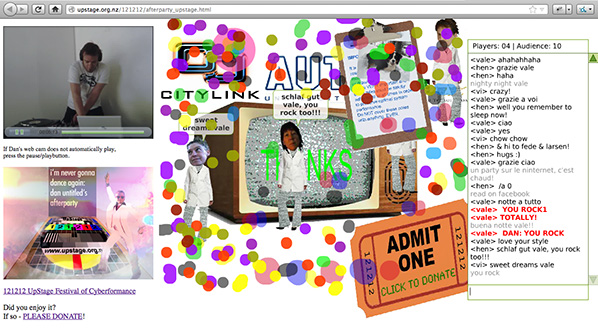
RP: I find it ironic that you named your performance group “Avatar Body Collision,” which seems to complicate the idea of net space as a virtual medium for disembodiment. How do you see “avatar bodies” colliding on the Internet?
HVJ: I don’t think of virtual space as being disembodied. We are still in our bodies, we are using our bodies to create the performance – primarily our hands and fingers (digits – we say “break a digit” before our shows instead of “break a leg”). The collision in the name is not about bodies colliding with bodies, but avatars colliding with bodies. Where does my body end and my avatar begin, and vice versa? And how do other bodies, e.g. the audience, respond to my avatar? The collision is one of flesh and technology, sweat and pixels.
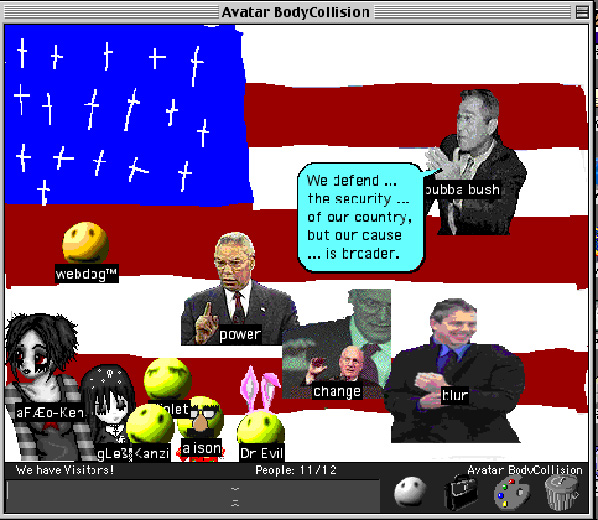
RP: Online, the audience or “cyberformience” plays a participatory role in the event, like the early Happenings from the 1960s. How does this non-hierarchical approach to theater impact the works you have created for the medium: how do you incorporate the audience into the work?
HVJ: It varies from show to show; some are designed for the audience to watch and respond, while others aim to actively involve the audience (cyberformience) to the point of co-authoring. One example at the first end of the continuum is “a gesture through the flames“, which was a webcam performance I created in 2008 for Annie Abrahams‘ “Breaking Solitude” series. I used a Victorian toy theatre and a soundscape to tell a story, and the online audience improvised a narrative in the chat. I didn’t interact with them during the performance (I was too busy to type) and it was fascinating to see how they read what I was doing. At the other end of the spectrum are works like “make-shift” or the series “We have a situation!” which can’t happen without the active participation of the audience. In “make-shift” (2010-12, with Paula Crutchlow), the audience were involved in writing texts, operating the webcam, answering quiz questions, building kites from recycled plastic, and ultimately performing on webcam. The event was structured so that they were “warmed-up” for their participation, and because we were located in someone’s home there was a very informal and comfortable atmosphere which made it possible for people to do these things.
RP: You are currently creating a new work entitled “we r now[here]” for the Art of the Networked Practice | Online Symposium. The title can be read as no(where) or now(here). Tell us about your concept of Internet space and time.
HVJ: Space and time in the online world are very fluid for me. I frequently work with people in different time zones, and travel physically between time zones myself as well, so I’m often calculating time differences and negotiating meeting times around all of this. In some ways time is irrelevant. In other ways, it’s highly significant – for example, precise timing is very difficult to achieve. Lag is unpredictable, sometimes it can disrupt a carefully planned sequence but at other times it can make something unexpectedly brilliant.
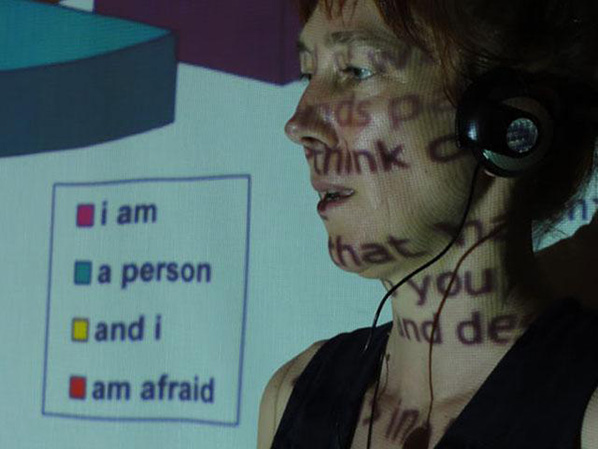
RP: A recent work, “make-shift,” unites domestic environments via the Internet in live, free-form conversation between online and onsite participants. How do you achieve a sense of intimacy and play in the online social space of the work despite geographical separation?
HVJ: I think of cyberspace as a space; apart from all the common spatial metaphors that are applied to it, when I’m working or communicating with people online in real-time it feels to me that we create a space through our shared presence, words, and whatever else we are using. It’s a space that extends into and absorbs a little bit of the physical environment of everyone present. “make-shift” did this very explicitly – we asked the audience (online and on site) to describe where they were, and this built a collaborative space or environment that everyone had a shared sense of.
In “make-shift” we created intimate and playful environments in two separate houses. the participants in the houses arrived half an hour before the show began, and during this time we warmed them up with a few activities and explained things about what was going to happen. Usually there was also food and drink, and often the people already knew each other so it was already quite friendly and informal. At the start of the show we began by introducing everyone. Each house called out a greeting to the other house and the online audience (which we’d practiced as part of the warm-up activities), and then we invited the online audience to tell us “what’s it like where you are?” This question was deliberately a bit open-ended, so people could describe their surroundings, the weather, their day, their mood and so on. The online audience are already seated at the keyboard and ready to interact; often they would make jokes, add other comments and respond to each other. We had regular online audience members who knew the format so inserted their own commentary or embellished others’. From this beginning, we continued throughout the piece to give the audience tasks that encouraged their sense of empowerment and ownership within the piece, such as operating the webcam, and we encouraged those in the house to interact in the chat with the online audience. Some people were a bit shy or worried about doing the wrong thing, but they usually got into it fairly quickly and became so involved in the piece that they lost any self-consciousness. In the final scene, the group in each house performed a song to the webcam and created a tableaux vivant of a painting we had referenced throughout the performance, and when we reached this point in the show they were always keen to do this.
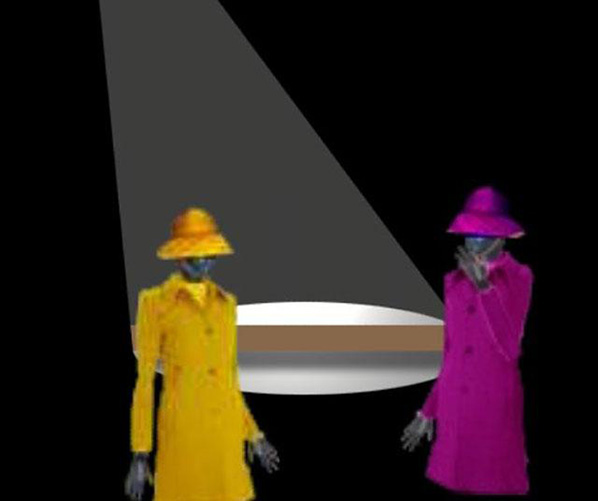
RP: With the Avatar Body Collision performance group, you have restaged Samuel Becket’s minimalist theater work “Come & Go.” Your approach to cyberformance has always been very free and open, and yet Becket is the opposite: highly structured with precise directions for actors. How do you reconcile these differences?
HVJ: It was a lot of fun to do “Come & Go“; from the outset we accepted that we had a strict set of instructions to follow, and made that our task – to render Beckett’s directions in cyberformance as faithfully as possible. So we didn’t reconcile those differences, rather we saw it as an opportunity to work differently for a change. We worked on small but precise avatar movements, which is harder than you might think, and used simple gestures that very effectively added emotion, such as a turn of the head or holding a hand up to the mouth. We played with the text2speech voices of our avatars: I was Flo, who at one point has the line, “Dreaming of … love”, and we discovered that the “…” created an emotional quaver in the computerised voice when it said “… love”. This was both funny and tender. So having a script and such precise directions meant that we spent time on details like this.
RP: You have produced your own online symposia, the Cyposium, the latest from 2012 culminating in CyPosium the Book, an edition of essays and transcriptions. How has your experimentation with the online symposium format altered your view of what a conference gathering can fulfill given global access via the Internet?
HVJ: The CyPosium was very successful and generated an exciting buzz. I think one reason for this was that everyone was online. When there is a stream from a proximal conference, it’s very easy for people at the physical venue to forget about those online. It takes very thoughtful planning to ensure that the online participants are fully included. So in the CyPosium, everyone was online and therefore equally included. Most people commented quite freely – at times it was quite dizzying to see the chat scrolling up at great speed, there was so much discussion. This made it quite difficult for the moderators to field questions – we had planned as best we could for this and it went pretty well, but there were so many people actively engaged in the discussion that at times we couldn’t keep up. Many people stayed online for most of the 12 hours, and the response was very enthusiastic the whole way through, which made it clear that there is a desire for this kind of event.
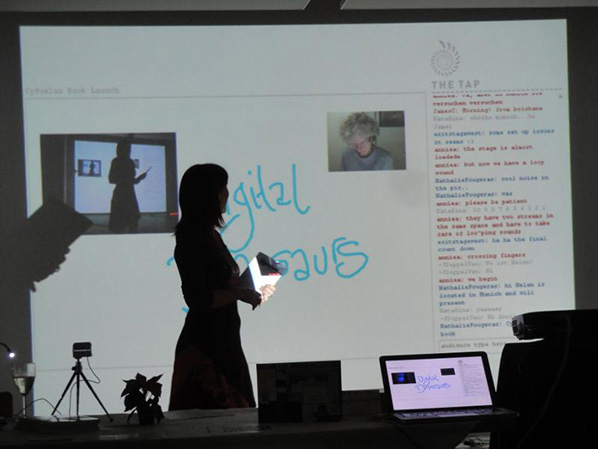
RP: In your years of performing and creating online performance, what do you think is missing in the liminal space of the online medium due to distance and non-corporeality? What do you yearn for? What do you still want to accomplish?
HVJ: At an absolutely practical level, I yearn for better funding, for funding opportunities that are not tied to geographical locations, as nearly everything still is. The distributed, non-corporeal and ephemeral nature of this work means that it’s always on the periphery – which in some respects is a wonderful place to be, but it’s usually the least-funded place.
There are many things that I imagine and would like to realise but can’t technically; some of these things may become possible if/when we manage the rebuild of UpStage that we are planning. But often what interests me most is experimenting with the resources I have and discovering what’s possible; what tricks or hacks I can do, what surprises there are when we push a technology in a way it wasn’t intended to be pushed or when we use a tool differently.
What I would still like to accomplish in my work is to further develop the intentions of shows such as “make-shift” and “we have a situation,” where a creative process shared by audience and artists can ultimately effect real change, at the individual level and socially/politically. I’m interested in how cyberformance can facilitate meaningful discussions and encourage people to think about alternatives and make actual changes in their lives. I’m interested in how connections between remote and apparently unrelated people and contexts can open up new possibilities.
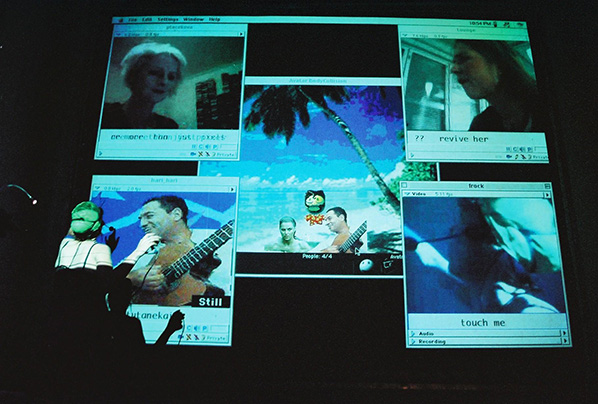
An International Online Symposium on Innovation in Networked Research, Artistic Production and Teaching in the Arts
Opening Reception: Tuesday, March 31, 11:00 AM – 1:00 PM BST (British Summer Time)
For online access login to Adobe Connect as a Guest: http://ntu.adobeconnect.com/symposium2015
11:00 AM – 11:30 AM (BST)
Welcoming Remarks from Singapore: Symposium co-chairs, Randall Packer & Vibeke Sorensen
Welcoming Remarks from London: Furtherfield co-founders & co-directors, Ruth Catlow & Marc Garrett
11:30 AM – 12:30 PM (BST)
@ Home With Furtherfield: Join Furtherfield co-directors Ruth Catlow & Marc Garrett for an intimate telematic gathering of Internet artist interviews & conversation with: Nick Briz, Joseph Chiocchi, Helen Varley Jamieson, Maxime Marion, Juergen Trautwein, Joana Moll.
12:30 PM – 1:00 PM (BST)
Live Webcam Cyberformance: we r now[here] is a cyberformance about nowhere and somewhere: the “nowhere” of the Internet becomes “now” and “here” through our virtual presence. Created by Helen Varley Jamieson and performed by NTU students.
For more information visit the Art of the Networked Practice | Online Symposium website.
Mainframe Experimentalism
Early Computing And The Foundations Of The Digital Arts
Edited by Hannah B Higgins and Douglas Kahn
University of California Press, 2012
ISBN 978-0-520-26838-8
The history of arts computing’s heroic age is a family affair in Hannah B Higgins and Douglas Kahn’s Mainframe Experimentalism. Starting with the founding legend of the FORTRAN programming workshops that one of the editors’ parents led in their New York apartment in the 60s, the book quickly broadens across continents and decades to cover the mainframe and minicomputer period of digital art. Several of the chapters are also written by children of the artists. Can they make the case that the work they grew up with is of wider interest and value?
The 1960s and 1970s were the era prior to the rise of home and micro computing, when small computers weighed as much as a fridge (before you added any peripherals to them) and large computers took up entire air conditioned offices. Mainframes cost millions of dollars, minicomputers tens of thousands at a time when the average weekly wage was closer to a hundred dollars. To access a computer you had to engage with the institutions that could afford to maintain them – large businesses and universities, and with their guardians – the programmers and system administrators who knew how to encode ideas as marks on punched cards for the computer to run.
Computers looked like unlikely tools or materials for art. The governmental, corporate and scientific associations of computers made them appear actively opposed to the individualistic and humanistic nature of mid-20th Century art. It took an imaginative leap to want to use, or to encourage others to use, computers in art making.
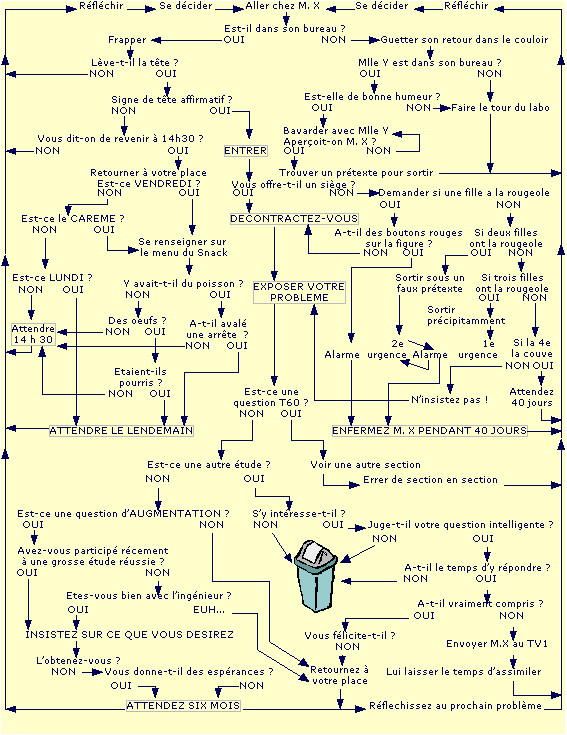
Flowchart for asking your boss for a raise, Georges Perec
Many people were unwilling or unable to make that leap. As Grant Taylor describes in The Soulless Usurper, “Almost any artistic endeavor(sic) associated with early computing elicited a negative, fearful, or indifferent response”(p.19). The idea, or the cognates, of computing were as powerful a force in culture as any access to actual computer hardware, a point that David Bellos makes with reference to the pataphysical bureaucratic dramas of Georges Perec’s Thinking Machines. Those wider cultural ideas, such as structuralism, could provide arts computing with the context that it sorely lacked in most people’s eyes as Edward A. Shanken argues in his discussion of the ideas behind Jack Burnham’s “Software” exhibition, an intellectual moment in urgent need of rediscovery and re-evaluation.
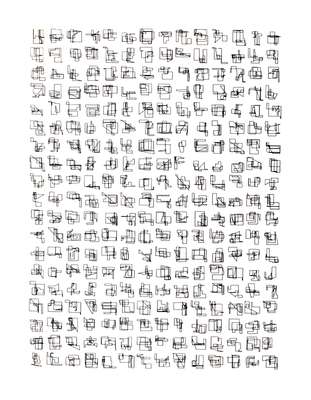
The extensive resources needed to access computing machinery led to clusters of activity around those institutions that could provide access to them. In Information Aesthetics and the Stuttgart School, Christoph Klütsch describes the emergence of a style and theory of art in that town (including work by Frieder Nake and Manfred Mohr) in the mid-1960s. In communist Yugoslavia the New Tendencies school at Zagreb achieved international reach with its publications and conferences as described by Margit Rosen.
Charlie Gere’s Minicomputer Experimentalism in the United Kingdom describes the institutional aftermath of the era that is the book’s focus. Like Gere I arrived at Middlesex University’s Centre For Electronic Arts in the 1990s with the knowledge that there was a long history of computer art making there. Also like Gere I encountered John Lansdowne in the hallways and regret not taking the opportunity to ask him more about his groundbreaking work.
Perhaps surprisingly, music was an early aesthetic and cultural success for arts computing. The mathematics of sound waveforms, or musical scores, were tractable to early computers that had been built to service military and engineering mathematical calculations. In James Tenney at Bell Labs, Douglas Kahn makes the case that “Text generation and digitally synthesized sound were the earliest computer processes adequate to the arts” (p.132) and argues convincingly for the genuine musical achievements of the composer’s work there. Branden W. Joseph places John Cage and Lejaren Hiller’s multimedia performance “HPSCHD”, made using the ILLIAC II mainframe, in the context of the aesthetics and the critical reactions of both, and considers how the experience may have influenced Cage’s later more authoritarian politics. Cristoph Cox, Robert A. Moog and Alvin Lucier all write about the latter’s “North American Time Capsule 1967”, a proto-glitch vocoder piece that, as someone who is not any kind of expert in that area, I didn’t feel warranted such extensive treatment.
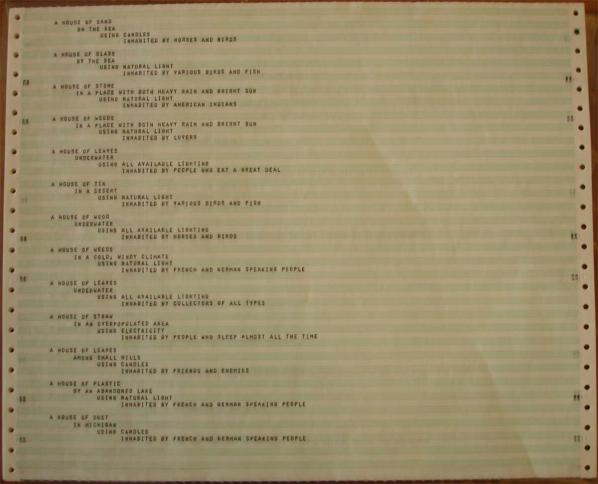
Hannah B Higgins provides An Introduction To Alison B Knowles’s House of Dust, describing it as “an early computerized poem”. It’s a good poem, later realized in physical architecture, and given extensive responses by students and other artists, that helps underwrite the claim for early arts computing’s cultural and aesthetic significance. Benjamin H.D. Buchlock describes the cultural and programmatic construction of the poem in The Book of the Future. And to jump ahead for a moment, a later extract from Dick Higgins’ 1968 pamphlet “Computers for the Arts” explains the programming techniques that programs like “House of Dust” used.
I mention this now because of the way that the extract of Higgins’ pamphlet contrasts with the version published in 1970 (available online as a PDF scan that I would urge anyone interested in the history of arts computing to find and study under academic fair use/dealing). Mainframe Experimentalism includes many wonderful examples of the output of programs, and many detailed descriptions of the construction of artworks. But the original of “Computers for the Arts” goes beyond this. It includes not just a description of the code techniques but a walk-through of the code and the actual FORTRAN IV program listings. Type these into a modern Fortran compiler and they will run (with a couple of extra compiler flags…). For all the strengths of Mainframe Experimentalism, it is this kind of incredibly rare primary source material that we also need access to, and it is a shame that where more was available it couldn’t be included.
Three Early Texts by Gustav Metzger on Computer Art collated by Simon Ford gives the reader a feel for the intellectual zeitgeist of arts computing at the turn of the 1970s, one that might surprise critics then and now with its political literacy and commitment. William Kazen brings Nam June Paik’s lesser known computer(rather than television)-based work to the foreground while tying it to the artist’s McLuhanish hopes for empowering global media.
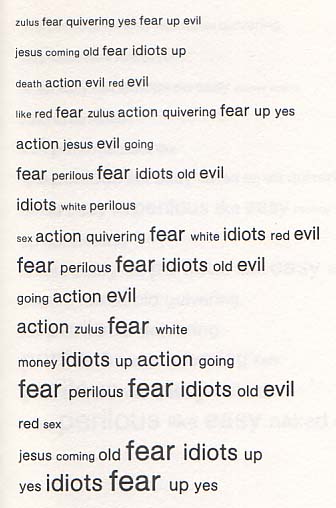
Knowles’ poem isn’t in the section on poetry (it’s classified as Intermedia), which begins with Christopher Funkhouser’s First-Generation Poetry Generators: Establishing Foundations in Form. Funkhouser gives an excellent overview of the technologies and approaches used to create generative text in the mid 1960s, providing a wonderful selection of examples while tracking pecedents back through Mallarme to Roman times.
In Letter to Ann Noël Emmet Williams explains the process for creating a letter expanding poem that had been recreated on an IBM mainframe. Like “House of Dust” it’s an example of computer automation increasing the power of an existing technique for generating texts. Hannah B Higgins’ The Computational Word Works of Eric Andersen and Dick Higgins draws a line out of Fluxus for the artists’ Intermedia and computing work. Eric Andersen’s artist’s statement describing the lists of words and numbers used to create “Opus 1966” shows both the ingenuity and intellectual rigour that artists brought to bear on early code poetry. The inclusion of Staisey Divorski’s translation of Nanni Balestrini’s specification for “Tape Mark I” provides an example of the depth of appreciation that prepraratory sources can provide for an artwork. Mordecai-Mark Mac Low describes how his father took ideas from Zen Buddhism and negotiated the technial limitations of late 1960s computing machinery to realise them in poetic form in The Role of the Machine in the Experiment of Egoless Poetry: Jackson Mac Low and the Programmable Film Reader.
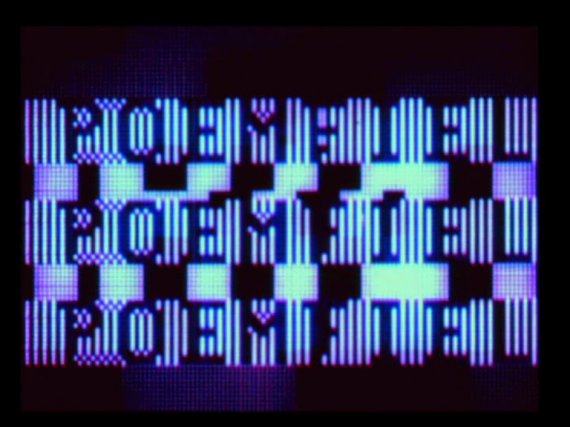
Finally, Mainframe Experimentalism turns to cinema. Gloria Sutton casts Stan VanDerBeek’s “Poemfields” in a more computational light than their usual place in media history as experimental films to be projected in the artist’s MovieDrome dome. Ending where a history of the ideas and technology of arts computing might otherwise begin, Zabet Patterson describes the triumphs and frustrations of using World War II surplus analogue computers to make films in From The Gun Controller To The Mandala: The Cybernetic Cinema of John and James Whitney. It’s a fitting finish that feels like it brings the book full circle.
I mentioned that several of the essays in Mainframe Experimentalism were written by family members of the artists. A number of the essays also overlap with their coverage of different artists, or describe encounters or influences between them. Arts computing was a small world, a genuine avant-garde. We are lucky not to have lost all memory of it, and we should be grateful to those students and family members who have kept those memories alive.
In “Computers For The Arts”, Dick Higgins describes two ways of generating output from a computer program – aleatory (randomized) or non-aleatory (iterative) ways. Christopher Funkhouser and Hannah B Higgins’s essays also touch on this difference, but forty years later. This is key to understanding computer art making not just in the mainframe era but today. Computers are good for describing mathematical spaces then exploring them step by step or (psuedo-)randomly, and whether it’s an animated GIF or a social media bot you can often see which of those processes is at work. It’s inspiring to see such fundamental and lasting principles identified and made explicit so early on.
Away from the era of the “Two Cultures” of science and the humanities, and of computing’s guilt by association with the database-driven Vietnam War, the art of Mainframe Experimentalism rewards consideration as a legitimate and valuable part of art history. Not all of it equally, and not all of it to the same degree – but that is true of all art, and cannot be used to disregard early arts computing as a whole. This aesthetically and intellectually under-appreciated moment in Twentieth Century art is crying out for a critical re-evaluation and an art historical recuperation. Mainframe Experimentalism provides ample examples of where we can start looking, and exactly why we should.
The text of this review is licenced under the Creative Commons BY-SA 4.0 Licence.
Part of Furtherfield Open Spots programme.
The Visual Artists of the Balearic Islands (AAVIB), Spain, launched the activist campaign and contra contest ‘#Young_Fraud’ in September 2014. The contest is meant as creative weapon for influencing the politicians on their responsibility within arts, creativity and culture.
The awarded artists and the promoters of the campaign will be at Furtherfield Gallery presenting the project and showcasing the artworks. To celebrate the occasion, you are invited to create and discover the most stylish mediterranean Fraud Tapas and dance to the rhythms of unprejudiced Sounds of the band: JANSKY – a blend of danceable electrotechno, beatbox flute and spoken word, which has been described by Shremy’s Law (UK) as “a breath of fresh air in the world of electronica”.
Schedule:
12.00 Sparkling bubble Fraudstyle drinks
1PM Project presentation
1.30PM Collective elaboration: Unprejudiced mediterranean Speculative Fraud_TAPAS
3.30PM Chillin’ Sounds, full of the most stylish beats from Balearic Electronica with the band: JANSKY
This project developed an artistic action which aimed to fill in the void left by the recent cuts in public funding.
It also highlighted and demanded compensation with regard to the ‘Young Art Visual Arts’ contest, which ceased in the 2012, after complaints concerning the poor professional conditions of the artists who participated.
‘Frau_ Jove’ in Catalan is translated as ‘young fraud’. There is a reference in the title to the surname of Maria J. Frau, head officer of the Cultural Department of the Government.
The campaign has achieved extraordinary support from international art organisations such as Furtherfield Gallery (London), Matadero (Madrid), and Hangar Laboratory of Creation (Barcelona). The media also played an active role in supporting and promoting the project as well as the UAAV (in English, Union of Associations of Spanish Visual Artists).
An international jury was formed and composed of Chus Martínez, curator of the Catalonia pavilion in Venècia Biennale 2015, former director of El Museo del Barrio of New York and current director of the Academy of Art and Design in Basel (Switzerland); the critic and Catalan curator and promoter of A-Desk, David G. Torres; the art historian Piedad Solans; and the artist Bartomeu Sastre.
Of the 32 portfolios presented, the jury selected Isabel Servera and Guillem Portell who will be exhibiting their work in the galleries of Hangar, Matadero and Furtherfield.
National Radio RNE3 relocated from Madrid to Mallorca to broadcast the decision of the jury in a special 2 hour programme. The #AntiFrau_Fest line up featured sounds from the best Balearic electronic music creators: JANSKY, PEDRO TROZ, CAP DE TURC, POAL & DEFLED.
Trans-gender theorist Jami Weinstein has compared the flocking behaviour of academics and artists around the concept of The Anthropocene, to the adoption by the Hipster of a given locale or fashion appendage. The creative flock, she suggests, can perform a gentrification of concept through uncritical adoption and ‘hyper-consumption’, just as it does of neighbourhoods or workwear. The Anthropocene is indeed the place to be seen, or the guise in which to dress the body of your work, this season. The term is proposed as a way of describing the explicit ‘age’ in which human kind, post-1945 (although possibly since the Industrial Revolution, or stretching right back to the advent of tool use), has come to define the geophysics of the entire earth.
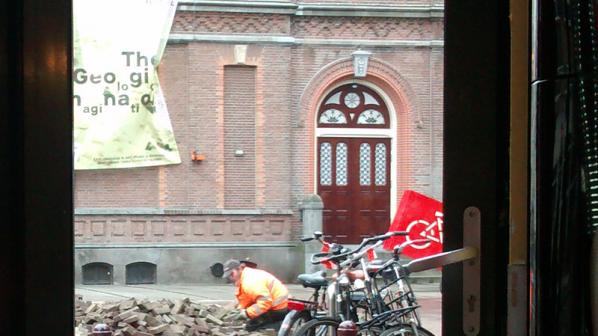
The Anthropocene, combining geology with sociology through a few slights of hand, therefore collapses the distinction of human and nature which is core to basic understandings of our being in the world. If this wasn’t enough, an immanent vote affirming the accuracy of the term The Anthropocene by the scientific community worldwide has also been touted as a gesture which will provide the rhetorical turning point by which the Western powers will acknowledge, and begin reparations for, the ecological sins of the past, potentially saving the human race from mass extinction. Fertile ground then, for readings, interpretations and responses – but as Weinstein suggests, there is a deeply complex responsibility implied when we approach and engage with something as ontologically vulnerable as a concept.
It is this responsibility Sonic Acts assumes when it takes The Anthropocene as its central theme. The four day music festival and conference takes a collection of essays titled The Geologic Imagination as a gathering point for a strong line-up of some of the most influential men working across philosophy, music and the arts today. I attended the first day of the festival, which included a talks and a round-table by Object Oriented Ontologists maverick Graham Harman and his icemanTim Morton, geologist Mark Williams, and art theorist Douglas Kahn, followed by a performance/installation by Florian Hecker featuring work by Reza Negarestani, and a night-time programme of music by M.E.S.H and TCF, Vessel, and finally, as if from outer space, the sole female agent of the programme, Karen Gwyer.
I use the term agent, to distinguish from ‘appearance’ or ‘voice’, because there were several female bodily appearances and women’s voices in evidence onstage during the conference and club. The problem was that they were routinely either denied the right to articulate their own words, for example when The Geologic Imagination editor Mirna Belina was reduced to acting as an interlocutor for Lukas Marxt during a poorly thought out artists presentation section; or worse, used as sound/image material to be cut into, destroyed, and literally degraded for surface affect by male artists. Example of this included the snippet Kurt Hentschläger showed of his work Modell5, during an inexplicable tour of his online portfolio – and the violent envelope-ing of Charlotte Rampling’s vocal performance in Hecker’s audaciously dense new materialist sound opera Script for Machine Synthesis. Certainly none of these phenomena may have stood out as malicious in themselves, but in the context of a festival whose line-up consists of 75 men and only 7 women, and whose female curators are entirely absent from the staged elements of the show, a motif in which women’s bodies and voices are a pretty fabric to be torn and disabused begins to gain the qualities of something else entirely. The ‘glitch’ too must take into account its gender dimension.
This unfortunate gender play reached its misogynistic anticlimax during the closing stages of the club event as the trashy, industrial techno of Vessel was backed by a huge split-screen visual (film created by Pedro Maia) of a woman crying in a bathroom, lying in a corridor naked, kissing another woman in a body bag, and finally being pulled limb from limb in an ambiguous mix of sex-scene and analogue-digital disintegration. What does the complicity and collectivism of a rave space do with images/sound combinations like this when they are conducted by men?
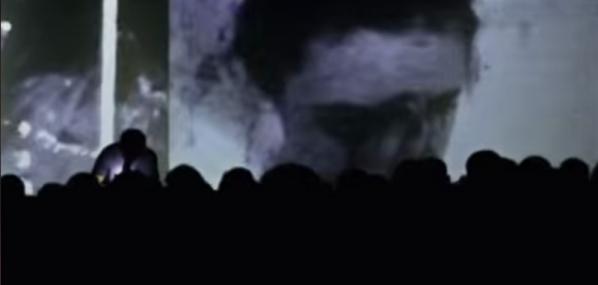
Early in his presentation, delivered with Tedtalk panache, Tim Morton used the fact that literary theory reads gender into texts even when they do not ostensibly mention gender, as an analogy for the way OOO recognizes that objects often ‘withdraw’ from us some core aspect of their being. As Morton affirmed, the Anthropocene is itself a “subcendent” object, being ‘much less than the sum of its parts’ – its parts being of a scale and complexity which must necessarily withdraw from us in order that the concept-as-object here can be revealed. This is explicitly not to infer that the concept-as-object can be emptied of its cultural and social identity and worn with Nikes like a naval overcoat, but rather that it requires a subtle and supple mode of thinking which is capable of excavating ‘that which withdraws’. The gender comment then, was prescient – directly illustrating that the curators, Lucas van der Velden and Annette Wolfsberger undermine the moral agenda of their project by failing to consider, or dismissing, the gender dimension. It might have been a calculated risk, that by not paying attention to gender during their deliberations they might elide that concept altogether from the consideration of the festival, but I think that when a risk backfires like this, the result should be called out for what it is – misguided and arrogant. At times, it felt like rather than proposing ways in which we might retreat from rampant, destructive territorialisation of the Earth, the festival projected a future in which the masculine regime of ownership and domination as ruinous could be helpfully extended and repeated onto womanhood as well – with all the faulty binarism and barbarism that implies.
The one audience question of the day, delivered from under a spotlight and with the barely subdued fury which gave him the air of Rasputin. His question, directed at Harman and Morton, I think picked up on some of the air of hypocracy of the event, but concerned the application of OOO specifically, and its relationship to Accelerationism. As my friend put it, “OOO qua Accelerationist gateway drug”. Needless to say, the question was expertly fielded and evaporated almost without trace.
Despite the regularly fascinating philosophical and cross-disciplinary gestures being made across the discourse/music strands, then, Sonic Acts was articulate through the voices it chose to exclude.
Not that the work itself, or the conversations happening across the theoretical and art strands was insubstantial. For example the way in which electronic artist TCF’s sound work performed the ontological flattening of objects as diverse as a helicopter, a computer circuit, and a Euro-house drop reflected brilliantly on the ideas proposed by Harman, Kahn and Morton, and gave a very tangible way of understanding the new materialist connotations of all. Another highlight included the Reza Negarestani double-bill, in which his notion of the incompatibility of given systems and the resulting philosophical imperative for ‘mixed-level reconfiguration’ through analyzing as both ‘that we can perceive’, and ‘that which we know’, for example, was first purposed as philosophical libereto, and then delivered as an almost equally dizzying Skype lecture.
During the deeply cerebral and attention-demanding ‘Script…’ performance, in which the audience were all seated on the floor, someone tall in mirrored sunglasses did a Jameroqui type dance while people filmed him on their mobile phones.
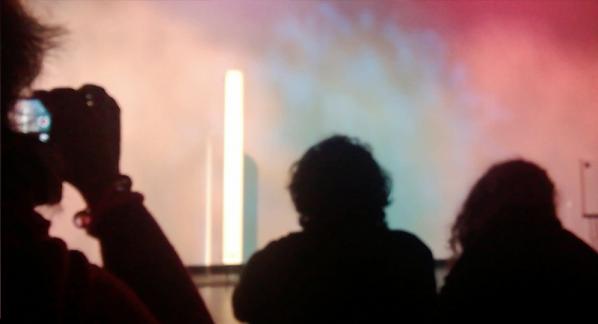
In Script for Machine Synthesis, (and previous works, such as Chimerisation) Florian Hecker has found in Negarestani’s philosophy a fantastic foil for his ‘dramatization of auditory synthesis’. Script used the motif (and the ‘occasion’) of a melting pink ice cube to enact a simultaneous synthesis and dematerialisation, bringing audio and scent (a specially commissioned perfume by Editions De Perfumes ‘materialised into a rubber trophy presented to each audience member in a foil envelope which made me think of space rations) into play as operators in the field of deconstructing the object-as-concept.
As an audience member completely new (but predisposed) to Negarestani’s work, following this hour-long performance with a lecture via Skype in which he laid out a the chiasmic twisting across neurological-phenomenological and mathematical-physical poles of experience and knowledge, led to a dizzying sense of having been teleported and improperly put back together.
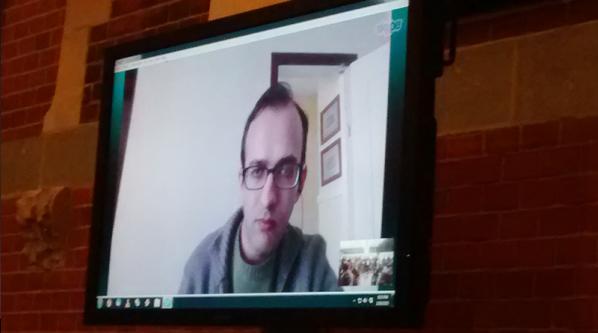
But, despite of these admirable folds in the art/thought continuum, it was impossible to shift the unnerving sense of hypocracy and lack of critical rigour at play in Sonic Acts programming. To return to the central unspoken chimera: The Anthropocene is gendered. In its simple form, it refers to a catastrophic situation resulting from the actions of a patriarchal Western society, and the effects of masculine dominance and aggression on a global scale. This was this subject in withdrawal which dominated my experience – meaning that a curatorial oversight not to include women, presumably in order to include more ‘famous’ names from these male-dominated spheres, was allowed to resonate and mutate into an experience of pervasive, almost hedonistic, misogyny I experienced during the Vessel performance.
The notoriously affluent European festival circuit benefits from a dense network of national and EU funding schemes, coupled with the neoliberal ease of intra-continental transport, cheap flights etc., and leverages this in an arms-race of fees for a mostly-male mostly-white cohort of mostly-electronic music artists. This context, plus that of the ‘lavishly illustrated’ book of essays which sets the scene for this year’s Sonic Acts, and the mode of staging in which the expert-community of the audience was silenced from contributing, in favour of a series of pronouncements from master-rhetoriticians, seems to me in direct opposition to the kind of ‘challenge to the status quo’ and subsquent reversal of the Earth’s fortunes which was frequently advocated for. The blurb for The Geologic Imagination does in retrospect seem to revel in the kind an uncritical adoption of concept Weinstein critiques, making of ecological disaster mere concept for further consumption:
“This new publication by Sonic Acts is inspired by geosciences and zooms in on planet Earth. Fundamental to The Geologic Imagination is the idea that we live in a new geological epoch, the Anthropocene. (!) Human activity has irreversibly changed the composition of the atmosphere, the oceans, and even the Earth’s crust. (!) Humanity has become a geological force. (Huzzah!)” [Exclamations mine.]
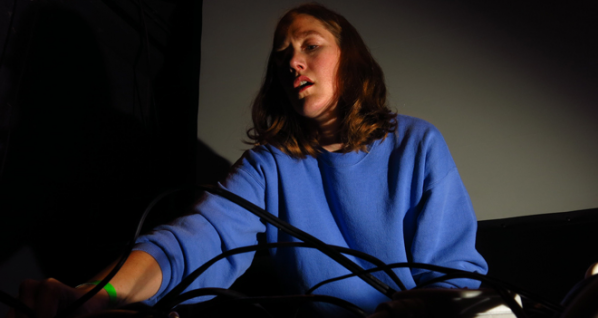
Finally, Karen Gwyer’s techno set – devoid from any descernable link with the festival themes, and so in a way also silenced somehow. But nonetheless, experienced like finally being able to breathe. The bass subdued among a mesh of pulsating synth and crystalline threads. Tim Morton’s frenetic big-box-little-box dance moves notable in the throng, somehow saying something indiscernible but very real, about the opportunities missed by this most-preeminent of European festivals. As Gwyer herself notes, in an interview not at all about the Anthropocene: “those forces have testicles.”
[imgs Jon Davies]
[Trigger warnings for just about everything goes here. Please Do Not Read the following if you’re sensitive, or concerned about trigger(ing)s.]
“An uproar of voices was coming from the farmhouse. They rushed back and looked through the window again. Yes, a violent quarrel was in progress. There were shoutings, bangings on the table, sharp suspicious glances, furious denials…Twelve voices were shouting in anger, and they were all alike. No question, now, what had happened to the faces of the pigs. The creatures outside looked from pig to man, and from man to pig, and from pig to man again; but already it was impossible to say which was which.”
– George Orwell, Animal Farm.
Today’s online spaces are communication minefields. When interacting in multiplayer games or social media niches, networks come drenched in reactivity bile. And although we might seem to bile-dilute, instead we intellectually saw at each other through a polite veneer. Here, civil discourse is label-trotted. Discourse bile may also erupt in balls-to-the-wall screaming matches. Such bouts involve trollbaiting, d0xxing, and Internet Rage Machine power-ups. Whatever the magnitude/form, online dialogues appear to be flooded with antagonistic commentary.
Truncated attention spans rage-burst. Such anger pockets are far from static: fuelled by such shameblood, the righteous degrade. We humiliate in order to inflate. We confront-tar and belittle-feather. The [s]urge for relevancy is sycophantically baked. We mobilize to unearth, to finger-point: we present affectivity as fact. Hate groups spread across factions, divide-blurring.
The search for sodalities is constant. Nuances are fudged. Contexts are ignored. Catharsis mutates through a checklist that reduces, confines, and truncates. We are force-fed trauma anecdotes as reality fulcrums. Baggage is exposed in painful lumps. We are not consideration-encouraged: we are expectation-drilled. We must agree. Must acquiesce. Must uncritically support. Anything else denunciation-equates.
Public shaming is the norm. We bully. We armchair-critique. Bipartisan voices lynchmob-morph, all-indignation-like. Roughshodders censor and context erase. Power drugs the inflamed and injects the underdog[s] with sudden shifting surges. Reference frames are smashed, then reiterated repeatedly till they become a thing of horror, of replication thrown from “side a” to hit “side b”. Such targets are then mirror-captured and magnified. Empathy is to be derided as weakness. Barbs are flung at all who seek to ponder “isms” or reclaim them. We must not listen in order to comprehend, to understand: we must shout.
We word weaponise [“…getting all soul-rapey on SJWs”/”…gut-cutting misogynistic neckbeards“/ “You are either with us or against us”]. Gator-screams and “die-cis-scum“-roars rule the day. We obliterate and issue-compress. We communication strangle. Equality is attainable through force. Aggression trumps assertion. Sarcasm blights compassion. Rudeness rewrites decency.
SUCH TERRIBLE WHITEWASHING SEALIONS

Power-grabs blind the sensitive. To destroy/troll/shame/swamp/embarrass/belittle/d0xx is to “win”. Sense of perspectives lose while extremisms gain. Dialogue is gamed: the loudest voices squash and rip, tear and silence. Threats echo the noose. Implications drive output. The end-goal is attention, ratification, dis[e]ruption: a pendulum power swing designed to flatten and redress. We obscure and vilify. We replicate exclusion ethics. We buck-and-doe-pass.
Online purging results in strange social crevices. Encouraged to instantaneously blurb our stream-of-tweeted-consciousness, we are off the chain. We spontaneity-bark and bleat [at] everything and all. Cohesion shatters. We no longer rely on institutions to dictate, to guide, to sanction. Moral Absolutists war-trawl Moral Relativists. The Arab Spring has turned us inside out. Unsure, we turn on each other. We emoji expose and deride. We [slut]shame and attack: all within banners born from psychologies spouting the benchmark worth of individualisation. Selfies become our egocentric standard.
We once attempted to codify, to restrain. But now, all gloves are off. We scrabble and lunge. We showcase-badge based on our version of “the categorical truth”. We bang and bleed against these corners, these intersections of emotion and intellect. Of private and public. Of control and openness. There is no room for reflection, for consideration, for clarity.
We refuse anything that calms. Online spaces are for battling. Playfulness and cohesion are sacrificed. Righteous mobs insult fling: they ratify rather than reappropriate. Alternates gleefully spout these insults as proof, stamp-ammo-ing all the while. There are, however, those who stay and observe. We await the wind-down. We desire an eventual dissolve: a fundamental shift. They can’t last, these discourse patterns. We wait for rage to course-run, for rage-fatigue. We await the next mediation bump.
The American artist Patrick Lichty is best-known for his works with digital media: as part of the activist group RT Mark and as designer of digital animation movies for their follow-up The Yes Men, he has been recognized as a net artist with a political bend. He has been working with digital media since the 1980s, and has created works with video, for the Web and for Second Life.
At his solo show “Artifacts” at DAM Galerie in Berlin however, the artist, who is teaching at the University of Wisconsin in Milwaukee and has recently published a book with theoretical essays, does not show media works, but tapestries.
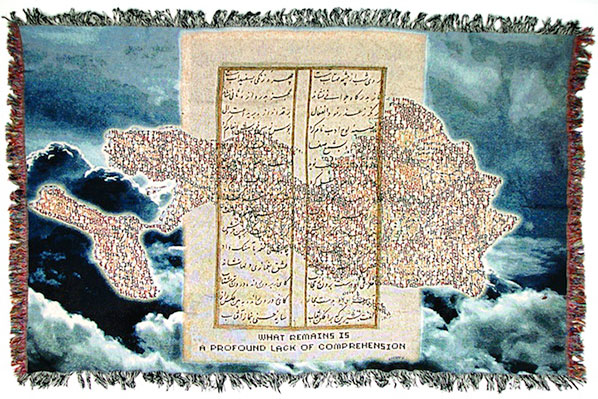
Tapestries? In the following interview Lichty talks about his return to traditional art techniques.
Tilman Baumgärtel (TB): Patrick, you are known for your work with media, and you have created 3D animations, Internet and Second Life works. But at your recent shows both in Berlin and New York you show works in much more traditional artistic media: drawings in New York, tapestries in Berlin. Why the return to these time-honoured modes of production?
Patrick Lichty (PL): I’ve been sitting in front of the screen for almost 30 years, and I’ve been blind several times in my life. This leads me to my belief that, “Mediation is reality.” I have artificial lenses, and I don’t know whether I see the world as it is. I feel like I have this cyborg vision, like I am slightly alien. I’ve had this feeling all my life.
So on the one hand, I have tried to create an alternative reality through mediation, or maybe to see the world for what it is through mediation. That is what happens with the Yes Men for instance: I am helping Mike and Andy to create alternative realities for our fictitious corporate campaigns. And on the other hand I am interested in what Marcus Novak from University of California Santa Barbara calls “Evergence” where virtual things that never existed except in the virtual manifest in the physical. It is almost like William Gibson’s novel “All Tomorrow’s Parties”, where the “printed” virtual J-pop idol Rei Toei idol jumps out of the nano-replicator, and says “Hello”, even though she never existed. I am interested in the tangible digital that manifests from the potential virtual…
TB: The tangible digital?
PL: Well, the idea of taking code, and turning it into 3D-objects, or taking things from Second Life and creating artifacts, and I use the US spelling as a double reference to “artifacting” or pixelization of an edge. The whole show here in Berlin is meant to introduce people to this gigantic body of work that I created in the realm of the digital as a cultural explorer, and that the contemporary art world doesn’t know much about, a bit at a time. What we have in the show are artifacts based on some of my more art world-friendly works. Some of my other pieces are definitely not art-world-friendly. I have done tons of prints and tons of video, that can be presented in a show, but a lot of my web work utterly and completely resists any kind of exhibition.

In the show in New York I have ten Roman-Verostko-like plotter prints of random internet cats, which is sort of my answer to post-internet art. By the way, you know what sold? The kitten swatting at the drone flying over it.
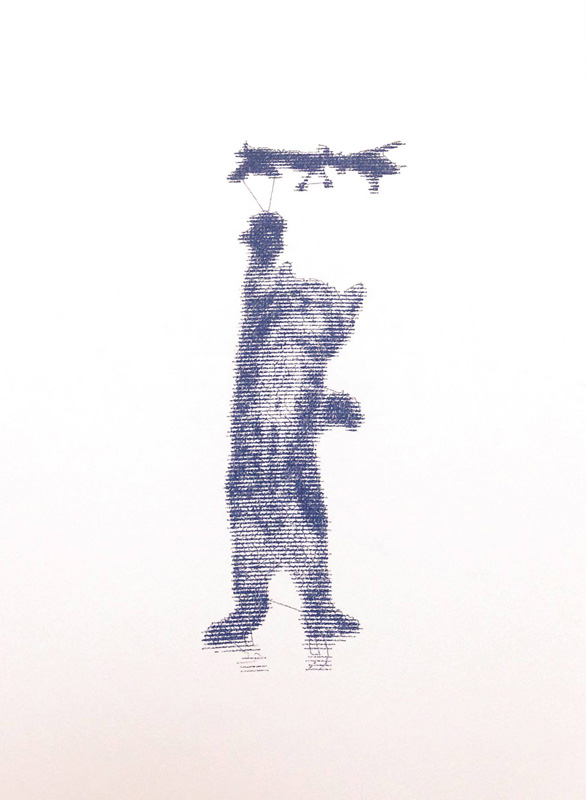
TB: How did you pick the motifs for the tapestry that is on display here in Berlin?
PL: This images come from certain key points in my practice in the last ten years. I send these files to a mill in South Carolina, and they fabricate the tapestry based on my image. These images are the ones that resonate with me very strongly. There is one that is called “Orange Alert”, which has the Space Invaders from the computer game attacking the White House, that I translated into this huge tapestry. It is based on a painting that his since been destroyed, and I think it is actually more interesting that way. We used to have this color code system in the US. “Orange” meant “You better be really scared”, and “Red” meant “You can kiss your ass good-bye.” Five years after 7/11, all the airports in the US were on Orange Alert, and nobody cared.
TB: Weaving was among the first crafts that were mechanized, and the mechanical looms were among the first machines that were controlled with early forms of punched card that in the early days of computing were the first form of memory storage. Is that the reason why you translated these images into tapestry?
PL: On the one hand I am referring to the old, grand art of tapestry weaving, and, maybe, playing a little bit to the gallery. It is a way to express the digital in a very certain kind of materiality that I find interesting and that is historically relevant to our heritage. They are simply a beautiful way to express digital content. And they are easy to display.

TB: The next thing we know is that you will be sitting on the loom again, rather than having these tapestries made for you…
PL: Well, I did that as a child. My mother was an artist and I worked on a loom with her. So there are specific incidents in my life that logically led me to create this work. I am not doing it, because it is hip, or cheap…
TB: …or could be shown in a gallery…
PL: No. There have been specific moments in my life that lead me to this, it was not merely a gallery move, although it made things easier.
The other thing that I am doing is that I am starting to place Augmented Reality on them, but that is not in this show. With the other Augmented works, like my Kenai Tapestry, you can take a device, bring up an app, and you look at it through the device, which recognizes the piece and then the virtual content comes out. The only piece like this in the DAM Berlin show that is like this is one piece that has a QR code on it that just says http:// and it sends you to a 404-error page. It is a Jodi-like piece. I don’t have to keep a server. It is something that actually does engage with technological devices, but I do not have to do this horrible upkeep.
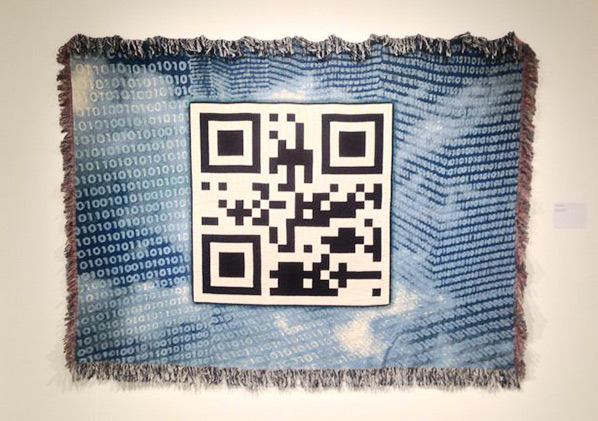
I did a piece called “Grasping @ Bits” in 2000 for which I got a honourable mention for the Golden Nica at Ars Electronica. It was this terribly complex hypertext-essay with hyper browsers and multiple reading paths, that had to do with activism and net art. I did this 15 years ago, and it is almost broken. Unless QR codes become totally defunct, I hope the 404 piece will work for a long time. We still have barcodes after how many years?
TB: In the 1990s, people were thinking that we would somehow upload ourselves into “cyberspace”, as in the “Matrix” movies. What seems to happen now is exactly the opposite: The virtual seems to re-materialise by manifesting itself in physical space, via 3D printers, smartphones etc.
PL: Instead of “The Matrix” it is more like in “All Tomorrow’s Parties” or “The Diamond Age”, in which we have machines that turn everything into what Bruce Sterling refers to as “gomi” or clutter/trash in Japanese. We have this whole explosion of digital content becoming physical again, but to quote Sterling again, most of them are meaningless technical exercises, or “Crapjects”.
This whole issue of re-materialization and corporeality from media to physical objects is of growing importance to me. We are made of material/flesh (points to his arm) rather than this (points to a computer). Moravec hasn’t come true yet; we are not uploading ourselves anytime soon…
I had a phase around 2005, where nobody heard from me much for a year or two because I wanted to reconcile myself with material. I didn’t do much media art, it was mostly material practice. That was when I started to work with iron casting and weaving. I have been interested in the Jacquard loom and 3D printing since 2004, but I am only showing much of that now. I did a 3D representation of a gif in 2005, where the black and white value determine the height of the different pixels. White is high, black is low. I had that cast in iron. It is from a series called “8 Bit Or Less”, that reflected on my blindness. I took samples from the different series of my work and experimented with translating them into a physical form. The idea is that mediation becomes physical reality, and the format of this show is a survey of various works. I thought that was the most logical way yo introduce people to a substantial body of work quickly but in an accessible way.
TB: Let’s talk about your involvement with groups like RTMark, the Yes Men or Second Front. You said that you were interested in creating alternative realities. Was that the reason why you ghelped create these groups?
PL: I have always been a leftist, who – ironically – tries to survive on his work. That´s why I was attracted to the anti-corporate bent of RTMark and the Yes Men.
A little bit back-story is in order here: Imagine an electrical engineer raised by artists and then taught how to do Critical Theory by Ph.D.s in Sociology and Theatre History, and what you get is me.
I actually worked an electronic engineer for a while, and did not go to art school until I needed a degree to be an academic, as a lot of early New Media artists did. My mother was an artist, she trained me in the arts. I got my first electronics kit in 1970, when I was eight years old. And then I got my first computer and started drawing on it in 1978 – that was an Atari 800 (I still have it). And I got on the internet in 1983, 11 years before the web. So who is the “digital native” here?
I was doing computer art in the 1980s, but only started showing my work in 1990. By that time I had fallen in love with a theatre historian and through her I had fallen in love with theory. My best friend even to this day, Jonathon Epstein, is a sociologist, who got me interested in visual sociology. We started a collective called Haymarket RIOT that made Social Theory proto-meme gifs in 1990-94 which Baudrillard loved, by the way. Later, we did these post-modern social theory-based industrial rock videos that were all 3D-animated. And I send these to Jacques Servin and Igor Vamos, when they were about to found RTMark. They did a cross-country tour across the US as Igor moved to Troy, NY, and they came to meet me in Ohio. They told me what they wanted to do, and I said: “Wow, you’re weird!” So we started RTMark, and the rest is history.
RTMark then turned into the Yes Men. I am not so central any more, but I still do all the animations for the movies and interventions. I think they became so noted that it is hard for them to do direct actions any more. Their actions became sort of theatre rather than activism. I think that’s why there’s much more emphasis on things like The Yes Lab and The Action Switchboard, so they can empower other people. The “Action Switch Board”, by the way, reminds me a lot of a much more refined version of RT Mark’s “Mutual Fund”, but much more robust.
TB: RT Mark, The Yes Men, Second Front – it seems like you prefer to operate in groups rather than developing your own personal Oeuvre.
PL: Not really, but certainly that is what is more visible to the public. Because I live in this world of mediation, it’s almost as if these groups have been my social groups. And I have always felt that in regards to getting traction in the cultural milieu, there has been strength in numbers. In groups, there are more people to jump on the soap box.
However, since the time when we founded Second Front, I’ve been very vocal in keeping the group into an almost ego-less form, patially from my experience with collectives, partially by the Zen/FLUXUS influence Bibbe Hansen brought to the group. I wanted a way to keep our group as logistically “flat” as possible. Which is ironic, because now Bibbe Hansen is one of our members, who has this huge legacy. Right now we are doing performances of Virtual Fluxus. We are also exploring Al Hansen´s (and other historical FLUXUS artists) work in Second Life.
TB: Are you “re-enacting” them, which is a trend in the art world right now?
PL: I would say “re-mediate”. What we are actually doing is performing un-produced texts by Al, pieces that could have never been done in real life. So we are not re-staging, we are creating works that have been unrealized. That is pretty exciting. One piece we have been doing is “Car Bibbe II”, a successor to his performance “Car Symphony” from 1968 that was never realized because of liability issues. He wanted to explode some Cadillacs.
TB: Why are you using Second Life? There has been a lot of criticism because this system leaves little liberty to the users…
PL: It is actually very fluid. It has a huge amount of possibility. Yet, we are currently investigating “Open Sim”, the open source alternative to Second Live. Any of the money that we are earning with the videos I have editioned at DAM will go to buy a permanent server and a static IP. I don’t want to go to another server farm. I want a modem in my living room with our world on my computer. It will be cheaper, and then we do not have to deal with Linden Labs’ oppressive policies any more.
TB: The attractive thing about Second Life was that at one point there was a ready audience, because it was so popular. But I do not think that this is the case any more…
PL: The important thing is that we used to do it as a function of community, and now we are using it as a representational tool. So the main results now are prints and videos. We want people to hear the tree fall, and this the way we get people to hear the tree fall in the woods: We take videos of it. The community has changed so much, it isn’t as important to us as artists any more.
TB: Second Life seems like Atlantis these days – a sunken, forgotten continent…
PL: It is kind of a necropolis for old technocrats. It is actually a very cyber-punk-thing. It is “Snowcrash”, 15 years later. But I am very interested in using Jurassic technologies and doing Media Archaeology. I also work a lot with pixelization, because at this point we don´t have to have it any more; it’s a choice. I did these pixilated nudes, that are barely recognizable as figures any more. You know, every artist needs to have a phase, where he is doing nudes, you know? (laughs) So I wanted to make them materially manifest a couple of years ago by laser cutting them into wood, expressing their materiality as surely as flesh does.
For the past ten years I have been doing media archaeological research into reviving Slow Scan Television as an art form. It is a video art form from the early days of Telecommunications Art. It is very low res, it only has four grey scales and a resolution of 120×120 pixels. It is a pretty specific and anachronistic art form. I am working with Hank Bull and Western Front right now to decode the audio track of the Slow Scan “Wiencouver” interventions of the 1980’s. I think I am one of the few members of my generation that knows how to run this equipment and how to repair these things. Many of my colleagues, who talk about dirty media and low tech, are still relying on the web… Well, they can have the Web. I am going back to networked art before the web. I am going back to the telephone network, but I use Skype now!
Lately, I have noticed in myself a tendency to sign up for events which reveal little of what to expect beforehand. This leads to a heady mix of anticipation and mild terror. Dark Days, the brainchild of Ellie Harrison fitted that description, although I felt that at 16hrs long, it was a mere blip on my riskometer, compared to week-long excursions I’ve previously taken into the unknown. In short, I would be spending the night in Glasgow’s Gallery of Modern Art (GoMA), in a pop-up community of 99 strangers, contemplating how we might manage to live together (put up with each other) in a future where buildings might need to be used in ways which serve the needs of the population better…Count me in!

The camp manual gave thorough and due attention to health & safety issues like pyjamas and woollen blankets, but scant reassurance on how the experiment would avoid a rapid descent into anarchy. In the absence of concrete information, my mind ran amok. I therefore decided, that on arrival we would be immersed in an imagined scenario where all manner of crises has befallen our village, that it would be up to us to work out how we would rebuild society. This would be a tense, high adrenaline experience involving sleep deprivation, maybe starvation, and intractable social issues, to be debated until we all came to a common vision. We might never make it out of there.
As it turned out, Dark Days was none of those things; it was a whole lot more. On arrival in Glasgow, I succumbed to mild panic and bought myself a sleeping pad, twinpack of nougat caramel chocolate, and a bottle of fizzy pop (in direct contravention of the bring a bottle of water mandate), to supplement the food I already had in my rucksack. Provisions bolstered, I relaxed & enjoyed my pilgrimage to GoMA; I felt carefree, adventurous and rebellious; none of the strangers walking beside me had a clue what I was about to do. I felt dangerous and daring.

I joined the short queue outside GoMA, exchanging nervous banter with fellow participants (“Is this where the over-excited and slightly nervous should queue for the coming apocalypse?”). We eyed each other up, I began to relax. We all looked pretty ‘normal and balanced’ individuals. Who could predict what would surface once the pressure was on, though? A child walking past was overheard saying “you’re the worst Mum ever”. He was joking of course, or was he? Was society breaking down already? When the doors opened, we edged inside, one and two at a time. We were subjected to challenging initiative tests – first to register with the clipboard on the right if your surname is A-L. I was standing on the left, I dithered. My surname begins with a ‘G’. My faculties were already leaving me. Through the archway to the welcome desk, I shuffled forward and joined the queue on the right. More nervous exchanges. The queue on the left was faster, we silently wondered whether it would be impolite to skip over to the other line. No one moved. A couple of minutes later, I spotted a notice ‘A-L’ taped to the left side of the desk. A dastardly ploy! Somewhere, a hidden camera would be watching me, a witness to my ineptitude. This was before the evening had even begun. My nerves jangled. Beyond the mysterious white cube that had blocked our view of the great hall (was that where the mind games would take place?), we placed our belongings around the edges and sat in the large circle of chairs which awaited. More nervous chatter, it was clear that no one had the faintest notion what the night would hold. I was reassured. Speakers, microphones and video cameras (with red light already flashing) were dotted around the space, we did our best to ignore them. There will be screenings in March in Glasgow, and the film will be made available online #ohdear. Someone noticed that there were not enough chairs for all members of the community to have a seat. 20ish people stood, or sat on the floor. Was this a lack of resources on GoMA’s part, or was it intentional? Time would tell.
An entertaining and enlightening journey followed, into the challenges of consensus decision making, based around the formation of ‘affinity groups’. The groups were determined by allowing anyone who felt brave enough to make suggestions of how we might spend our time together, members of the community chose which group they wanted to join. The options were many and varied; building a Tower of Awesome; a general knowledge quiz; game playing; climate change discussion group; music & dance; a group with no plan; a manifesto writing group; a skills sharing group and a community focused ‘hub’ group. This was the fascinating moment for me, as my intended plan for the evening was abandoned. Along with my keen interest in community building, I was at GoMA to write poetry, to create a distillation of the night’s happenings for future posterity. Logic would dictate that I should go where the most words would be; but I was filled with an irresistible urge to play games. I had already co-dreamed an impressive list of sleeping bag related games with the person sitting to my left (slug, husky races, who can wear the most sleeping bags, sack races to name a few).
We gathered in our groups to discuss what we would do, what we would need, what format the evening should take and (as it turns out, crucially) what time we would like the lights to go out. A spokesperson was selected to represent each group on a ‘spokescouncil’, where the representatives would reach a consensus on the issues of how the evening would go, any conflicts over resources and at what time the lights should go out. The facilitators did a magnificently heroic job of keeping the discussions focused; ‘brief’ overviews spiralled out of control, the facilitator gently herded the kittens. “I’ll say again: Each spokesperson is to give a brief outline of what their group will do tonight” quickly became “Each person has 30 seconds to tell us”. Those not on the spokescouncil chortled and tried to stifle the mounting hysteria. The only spokesperson not tempted to flout the guidance was from the ‘no plan’ group, because well, they had ‘no plan’. It became clear that with the proposed ‘Tower of Awesome’ and sub-idea of sleeping bag fort, that chairs were the key resource to be negotiated. Turning out the lights also became a decision to be much wrangled over; there were lots of needs, ranging from ‘pretty much now’ to ‘what the hell, let’s stay up all night’.
Negotiations were funny, tense, agonising and did I mention funny? At one point, I was weeping with laughter; we were tantalisingly close to reaching consensus when out of leftfield came a demand for an opening ceremony. Fine we all said, have your opening ceremony, let’s just get this done. The sage advice of the facilitators was beginning to hit home – only use consensus decision making for important decisions and ask yourself ‘do I want to spend all night making decisions, or do I want to have some fun?’. By now it was heading towards 11pm, and there were games waiting to be played. We were close. We were restless. The facilitator then fulfilled the most crucial obligation of consensus decision making, and asked the spokescouncil whether there were any objections. We held our breath, pleading inwardly for no one to speak up. Come on spokescouncil, you could do it! Hands went up. Sigh. 15mins of jaw-clenching tension followed, as the universal ‘need to be heard’ surfaced in a few last desperate arm waves; “Well, this isn’t exactly an objection, but I’d just like to say…”. “Any final objections?” our facilitator said, possibly through gritted teeth. Silence. We breathed a collective sigh of relief. “I think we have a consensus”. We cheered. Let the games begin.
The opening ceremony was a resounding success, as we all ‘became the chairs’ in a self-supporting and poignant human chair circle. Next, we lined up in small groups, ran the length of the gallery, and then turned and felt the breeze on our faces. It was magical. We smiled broad smiles, laughed, and revelled in a joyful camaraderie for the rest of the night. How could anyone think of going to sleep when there was crowdsurfing to be done, wink murder to be played (epic) and thigh drumming to be learned? It was a fascinating experience. I observed an interesting phenomenon; each time an activity gained a certain number of people, others noticed and ran to join. The wink murder circle doubled in size while the detective was behind a column and the silent disco grew within minutes, without a word being spoken. We generally didn’t stay segregated in our own groups, we welcomed others in unreservedly, and joined other groups when the mood took us. We were a model society, just for one night. We self-organised, and ensured that there were enough chairs to meet the needs of towers, forts, hubs and deep discussions. It was beautiful and inspiring. It was epic and poetic. We had survived. No, we had flourished.
Extract from my #DarkDays poem:
Dissent can be difficult,
blocks disrupt.
Build a safe environment
for breaking power,
freefall into your position,
annex yourself from your ideas;
interrupt silence,
with or without permission,
be the instigator of your rebellion.
Move the chairs
Wind-down at 2am came all too soon, and we made ourselves cosy for the night. My mind was skipping and crowdsurfing, and reliving dramatic wink murder deaths; how on earth was I going to sleep?? I didn’t. Well, maybe an hour or so. I lay under my blanket (not woollen) and listened to the rise and fall of contented breathing, with the occasional soft, acoustically augmented, echo-y snoring (cautionary note; snorers should choose their sleeping spot carefully). I contemplated how different the experience might have been in the ‘real world’, where people wouldn’t be so accommodating, wouldn’t be on their best behaviour. I suspect there might have been less laughter and fewer games, certainly no Tower of Awesome or sleeping bag fort. Time will tell.

There is a distinct buzz that goes with embracing the opportunity to stay in a public building overnight, I encourage everyone reading this to add such an experience to their bucket list. You might have to go to some lengths, might have to personally orchestrate an event, in order to create your opportunity. Whatever it takes, it will be worth it. I promise. Think ‘Night in the Museum’, meets giant slumber party, with midnight feast thrown in, but with no adults to tell you what you can and can’t do. We were the adults, we made our own rules. Even when a camper was scaling internal walls in the importance of building the most spectacular sleeping bag fort ever seen, no one came to tell us to stop. We all learned something valuable from that endeavour; the fort was unbearably hot inside, so could only be tolerated for short periods of time. Next time – ventilation. One participant put our limited imaginations to shame, by bringing a hammock to sleep in. We all wanted to be that guy. We ate chocolate and muffins for breakfast.
All of your dreams for a different world, made real in one spectacular night in a museum, art gallery, library, school or conference room (the possibilities are endless). Life will never be the same again, you will be changed, and you will want to do it again and again.
Note from reviewer: Names have been omitted in order to protect the subversive, the wall-scaling, the almost-pyjama-wearing, the non-sleeping campers.
Featured image: 144 Hours in Kiev: Instagram montage, all images courtesy of Lev Manovich
Lev Manovich’s upcoming keynote, along with the entire Art of the Networked Practice online symposium, March 31 – April 2, 2015, will be free, open and accessible via web-conference from anywhere in the world. Visit the Website to register. The symposium is in collaboration with Furtherfield.
While big data has infiltrated our everyday lives, Lev Manovich and his collaborators have explored the data of everyday life as a window on social transformation. We discuss his latest work: The Exceptional and the Everyday: 144 Hours in Kiev, a portrait of political upheaval in the Ukraine constructed from thousands of Instagram photos taken over a six day period during the revolution in February of 2014. The project evolves from Manovich’s recent manifestations, Phototrails (2013) and SelfieCity (2014), metamorphosing social media into data landscapes.
Randall Packer: How do you view social media as illuminating a broader understanding of crisis in times of political upheaval?
Lev Manovich: When the media covers exceptional events such as social upheavals, revolutions, and protests, typically they just show you a few professionally shot photographs that focus on this moment of protest at particular points in the city. So we were wondering if examining Instagram photos that were shared in the central part of Kiev would give us a different picture. Not necessarily an objective picture because Instagram has its own biases and it’s definitely not a transparent window into reality, but would give us, let’s say, a more democratic picture. So we’ve downloaded over 20,000 photos shared by 6,000 people, and using visualization we created a number of different views of reality with patterns contained in the data. And we were particularly interested to see how the images of the everyday exist side by side with images of extraordinary events: how images of demonstrations, confrontation with government forces, fire, smoke, and barricades exist next to selfies, parties, or empty streets.
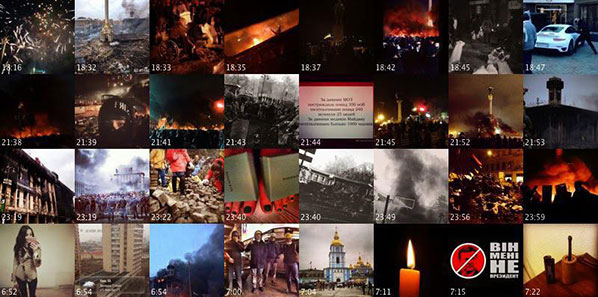
RP: Is it possible to think of what you are doing as taking an activist position in terms of revealing truths about a political situation?
LM: We have to be careful because obviously what you are seeing in 144 Hours in Kiev is a relatively small part of the population. Because the people who do use Instagram create tags mostly in English, they are, maybe, pro-Western people. But it allows us to get a sense of, not necessarily of a truth, not necessarily of what’s real, but let’s say a different kind of picture, a different place of reality then what the journalists would get. Because journalists may go, talk to a few people, and then come up with a report. But here you have “quotes,” so to speak, of thousands of people.
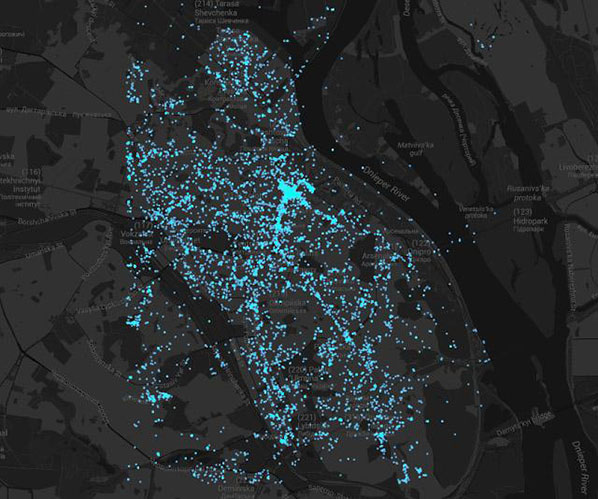
RP: Do you also see the collections of visualizations from user-generated images as an aesthetic realization?
LM: Perhaps one thing we can highlight is the idea of expressive visualization. As an artist I am also interested in the question of how can I present the world through the data. So let’s say a hundred years ago I would be taking photographs of a city. Now I can represent the city through 2 million Instagram photos. Thinking about landscape paintings in Impressionism, Fauvism, or even Cubism, how could I represent nature today through the contributions of millions of people? So I think of myself as an artist who is painting with data.
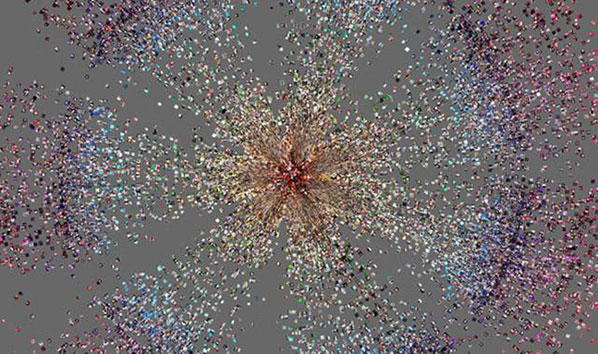
RP: But I’ve noticed that there is a focus in your writing on scientific methodology, you don’t talk very much about the renderings from an artistic perspective.
LM: It’s very clear that we’re taking ideas and techniques that have been used by modern artists. The difference is that we are pulling out data and writing open source tools. We’re taking in this case social media, works that were not created by us, and then putting them through different kinds of combinations. If you think about modernist collage of the city from the 1910s or 1920s, using pieces of newspaper and other existing media, what we’re doing exists in the same tradition.
RP: In many ways, the works can be fully appreciated as collage or composites, which I imagine goes against what you are trying to say through data analysis.
LM: No, it doesn’t go against what we are doing. It’s a matter of speaking to different parts of society. So you don’t just talk to designers or artists or like-minded people, you also talk to scientists. But ultimately what drives me is that I can I create something expressive, something unique, that isn’t just simply a data visualization, but creates an image that finds visual forms, that finds the right metaphors, which allows me to talk about modern society as consistent with its millions of data points. To me I think it’s a successful metaphor for how to speak about society today, when you think about all the traces you leave on social networks. I am trying to find the static visual forms to represent our new sense of society from seemingly random acts of individual people.

RP: Talk about the idea of “collective stories,” which are revealed in the composite of hundreds of thousands Instagram photos, each of which is a story in and of itself.
LM: We bring all these narratives together and try to make a kind of composite “film.” The connection to documentary, such as filmmakers like Dziga Vertov, for me is very clear. When Dziga Vertov, for example, was making his films in Kiev, he would have several cameramen in different parts of the Soviet Union shooting everyday, and they would send it to him and he would put it all together. So my “films” are made up of downloaded visuals, in which you can then make multiple “films” out of.
RP: Is it possible that the individual stories, the individual voice of expression, might get lost in this broad swath of data mining and cultural analytics?
LM: People are documenting what they think is interesting and important in their lives. But because there are very particular behaviors, what you get is a kind of pattern. I would say that patterns are not the same thing as a story. I don’t think of it as traditional narrative art, but rather a pattern of certain repeating behaviors.
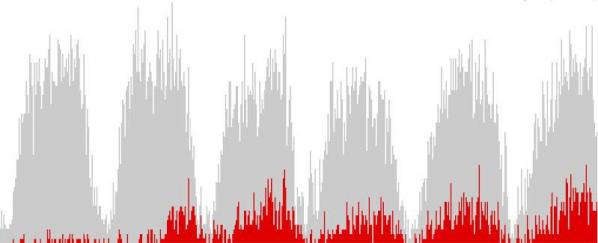
RP: How do you position the work you are doing in the context of the current crisis of invasive surveillance and the loss of privacy resulting from big data analysis?
LM: When we started thinking about these ideas in 2005, these issues were not on the table. In the last two or three years they have become central and to be honest they keep me up at night. I consider whether or not it’s OK because there are histories of governments using photographs of protests of honest people. I think the first time it happened seriously was in Prague in 1968 when it was raided by the Soviet Union. You had bystanders taking pictures, and when the pictures were found they were used to arrest people. So we thought a lot about it. When you start to individualize stories, when you start following particular people, then it gets really dangerous.
RP: In this sense its a very political project. What you have done is revealed that in the 21st century of social media it’s difficult to hide anything. What have you learned about contemporary life as seen through the lens of social media?
LM: This is a deep question. I’m basically trying to say that as opposed to a journalist who thinks about the “data” as a kind of truth, that it’s a way to find out what happened, what I’m thinking about is its own reality. It’s not a question of truth, it’s a question of making interesting connections.
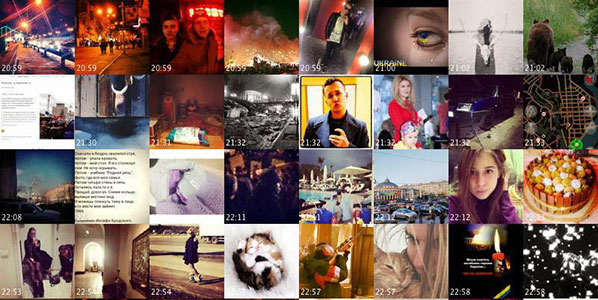
RP: That’s the difference between an artist and a journalist or even a scientist. You’re absorbing and you’re finding the connections but you’re not trying to say: this is it.
LM: I think the main answer is this: we can produce different visualizations out of the same data. Everyone views a different idea. It’s like when Monet paints another cathedral, there is not one painting that is correct. He makes a dozen paintings where every painting represents a different color, different atmospheric conditions, to show that in fact there are only the subjective views. So the goal is perhaps not to give people a new interpretation, but rather to challenge what they may be thinking is the correct one.
The Everyday and the Exceptional: 144 Hours in Kiev is a project of Lev Manovich in collaboration with Dr. Mehrdad Yazdani, Alise Tifentale, and Jay Chow.
First things first, Antonio Robert is a great guy. He is literally the happiest and most lively artist I’ve ever worked with, his online postings contribute in a full and proper way to both digital art and open source code communities, and he finds space in his wetware for the feedership of cats. He has top-notch glitch credentials, and is hooked into some important ideas about where that field is going – being the most active, if not only ‘glitch artist’ currently showing work in the UK. His work is rooted in glitch aesthetics and ideas, but constantly pushing at its edges. He’s performed and presented at Tate Modern, Databit.me in Arles, France, glitChicago, and he has his first solo show coming up at BOM (Birmingham Open Media) later this year.
Beside his happiness and energy, the first thing you notice about Antonio is that he has this geeky thing going on, like some kind of 90s Spielbergesque computer wizz – I’m sure I heard him call his computer ‘baby’ once as he goded it into action – but when he came to perform as part of our Syndrome programme in Liverpool, he literally ripped his tee-shirt off in the middle of the room, just as he was about to start.
He is the embodiment, in many ways, of the kind of volatility and fun in lots of great glitch art. I hooked up with Antonio online, where we spoke about glitch, and how it relates to his new iconoclastic work on copyright.
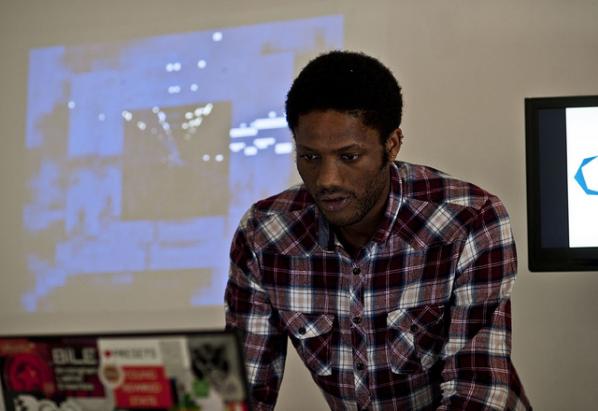
NJ: So… first question… You’re kinda out on your own in the UK it seems, as ‘the’ representative of the Glitch Art movement. I can see that that has been really great for you, for example with trips to Chicago etc… but does it also feel a little lonely?!
Antonio: Yeah, definitely. Ever since I helped bring the GLI.TC/H event to the UK/Birmingham in 2011 I’ve been getting questions about giltch art. I’m happy to impart my knowledge and experience to anyone that’s curious and my usual response is “you can do it too!”. That is, if you want to do glitch art there are so many tutorials about it. And, if you want there to be more events focused on glitch art all you need is an idea and some motivation.
NJ: There’s certainly an appetite for work which can reveal the systems underlying digital production – which is what good glitch art does. Do you think it is the term itself which is beginning to feel dated – as a result of an appropriation of its aesthetics? So fewer and fewer artists use this term now because its central modes are being used in a non-critical basis.
Antonio: I think it has become a bit dated through appropriation. That isn’t to say that glitch art has to be a specific thing and made using community-approved techniques, but now I see art that is just noisy or digital-looking that is described as glitch art.
NJ: I want to draw attention to some works of yours – or others – which seek out new (or different) systems which which to destructively engage. Because I think your work is still very much exploring and finding new territories opening up with this trope, while remaining within the ‘glitch’ genre. The work you made for the EVP website, “spɛl ænd spik:” modulated the construction of speech with phonemes. Where does the error enter into this, and do you consider it a departure from your work previous?
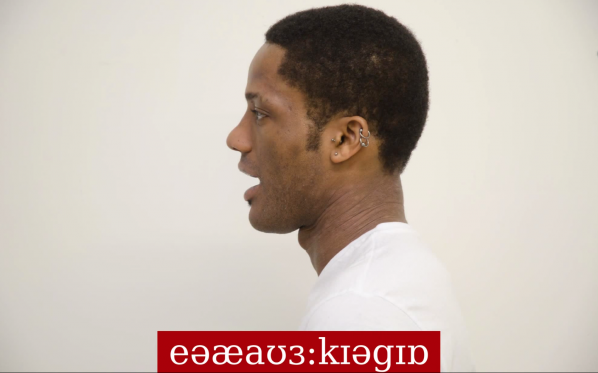
Antonio: It’s definitely a departure in terms of aesthetics.
NJ: It is not multicoloured!
Antonio: Hahah yeah. Even my clothes are plain. I wanted the focus to shift from the aesthetics of glitch. Glitch art incorporates many themes including randomness, error, helplessness, the unexpected, machine driven operations. And for the EVP piece I wanted to focus on randomness. I think the error lies in the perceptions of the viewer. When it was exhibited publicly at the Next Wave Exhibition at the RBSA many people thought that it was my voice and, at times, they could hear English words, so, the thing “glitching”, or experiencing an error in this case is their perceptions.
NJ: The tension between the random sounds and the possibility of speech is certainly unsettling.
Antonio: Then there’s the fact that those random sounds are coming from a human image… Digital and “New Media” art is still a new thing for many audiences and institutions, so confusion or bafflement is to be expected. I just hope that this then turns into curiosity. I hope that audiences then begin to ask questions about what it is they’re seeing and how it fits into their ideas about art, creativity and everything else.
NJ: There is something which Bifo Berardi says in “The Uprising: On Poetry and Finance”, where he is noting how ‘political decision has been replaced by techno-linguistic automatisms’, and it seems like ‘glitch’ art has a role to play here which is analogous to the one he assigns poetry in this book. Do you think that the kind of work you do with error is innately political or have revolutionary potential in this way?
Antonio: There is the overtly political work that I have made in the past. For example, Copyright Atrophy, which uses scripts and programs to challenge notions of ownership and copyright, was made specifically to be challenging, as was the work What Revolution. Another theme that interests me is copyright and free culture. And it’s always been there in my work, just not the core message. Now, for example, there is also the work about copyright which is currently being developed (as Archive Remix) as part of my residency at the University of Birmingham. It fits a long tradition of artists remixing artworks and appropriating culture. I’m hoping to bring about a change in attitudes at the university through my work with them.

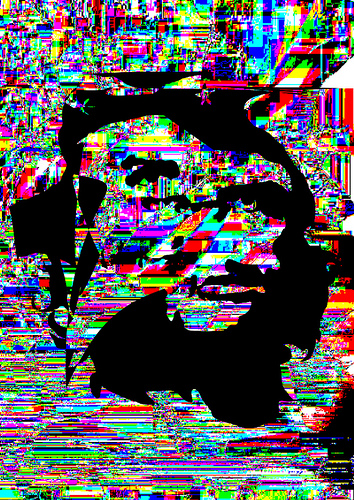
NJ: Just looking at the work you’re doing at University of Birmingham, it seems to deal with the same theme as Copyright Atrophy, which is a kind of horizon of ownership – which relates also to the horizon of meaning… between meaning and meaninglessness, between owned and apprpriated. So there is a point in the logo-gifs of Copyright Atrophy, and the Archive Remix animations, where they are operating simultaneously as a symbol, or original – and as a new, catachrestic symbol for something yet to be defined. I’m taking the term catachresis here from the way Lee Edelman uses it in his literary and cultural criticism such as No Future, to describe how ‘misuse’ of given words leads to an opening up for heretofore undiscovered territory – also similar to what Rosa Menkman describes as Glitchspeak.
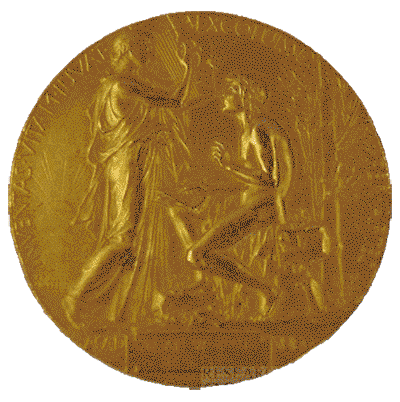
Antonio: Indeed. Although in Copyright Atrophy I am “destroying” the logos, in some way I’m evolving them too. I want to show that a piece of artwork is never truly finished as it may be reinterpreted and remixed by people, and also that we should let this natural evolution happen. Another example to illustrate this evolution is Comic Sans Must DIe.
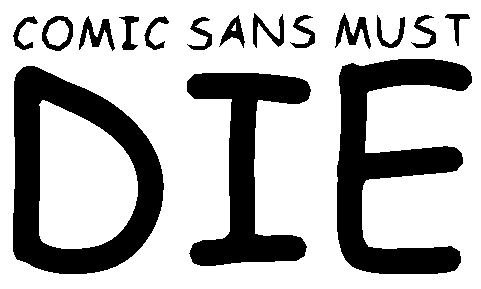
Yes, I’m destroying each glyph of Comic Sans, but some frames of that might make a good new typeface in itself. The short animations I’m making for Archive Remix are, at the moment, acting as case studies that I will take to the university to show good things can happen when you have more liberal licensing on images. As you may have seen, I also do a version of the animations with the copyrighted material censored. I want to show the perils of censoring. So underneath each “new” gif is one with the copyrighted material blacked out. Imagine if DJ Shadow’s album Entroducing only had works that had been cleared for usage!
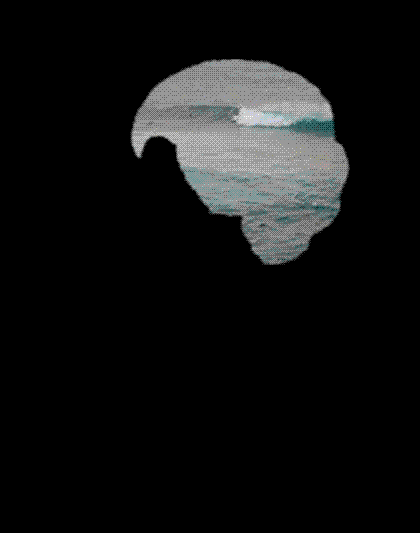
NJ: They are sad images, for sure. There is a melancholy at work here, which makes me think of the ‘death’ of the work, being the moment it has to stop evolving.
Antonio: Indeed.
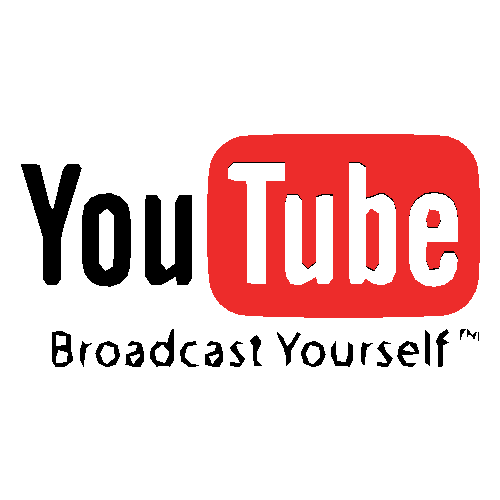
NJ: I feel that way sometimes when I perform a poem, or even read it out to someone on the phone, that somehow its limitations have been reached as potential. Do you think it’s this attitude of a work always being open to interpretation which creates an exit from the inevitably melancholy ending of a completed artwork? I guess that’s one reason why an open platform for the code you produce is attractive.
Antonio: I can see the performance or exhibiting of an artwork as limiting because what has to be presented is something finished. However, sometimes I see this as a chance to exhibit one iteration of the work. It’s always open to myself or others to remake or build on from. There have been people that have built on the code and programs that I make and I’m thankful for this. The best example of this was the method I created for generating jpgs from random data, which was in itself inspired by HEADer Remix by Ted Davis. David Schaffer greatly extended this into his own tool and Holger Ballweg ported the code into SuperCollider. If any code I write inspires others who am I to stop them from using or building on it?
NJ: A year or so ago, I proposed that art forgery should be legalised. I feel, along with many others, that the ‘art market’ has very little to do with the community of artists most worthy of admiration and respect. But perhaps it is ownership itself that is the problem. What is there in ownership ‘authorship’ which is valuable to retain? Attribution, I suppose – but what value in attribution?
Antonio: Yes, attribution is the important thing. All people should rightfully own the thing that they make. But problems arise because they then want to own everything that comes after it. So yes, remixes, reinterpretations are important and should be allowed, just as long as the original author is attributed for their work. It’s all a confusing and scary time for artists and the art world. Everyone’s wondering how they can make money and sustain their practice whilst still reaching as many people as possible. I hope that through my work I can show that these new approaches (open source, free culture, liberal licensing etc) can yield positive results and won’t necessarily result in the loss of earnings or opportunities.
NJ: It’s kind of ironic though, isn’t it, that digital artists like yourself who actively question and disrupt the basis of the apparently ‘infinite flows’ of digital content, finance… are part of a scene whose infrastructure itself is crumbling, and who generally suffer a very real stress and insecurity as a result. This is exacerbated as well by the kind of funding environment which might be offsetting this instability somewhat, but where digital artists are co-opted ecosystem of ‘digital economy’ — rather than a ‘cultural economy’ — itself formed around ideas of efficiency, and hence ‘labour savings’? Do you think this might actually be harmful?
Antonio: Yes, I think it’s dangerous focusing just on digital economy and making everything digital. Sure, it’s exciting that technology brings us all of these opportunities, but it leaves behind everyone that doesn’t work in that way.
NJ: Finally, on this subject, I thought you might like to highlight some contemporary work which influences you, which comes from outside the ‘digital art’ scene (if this is even possible!) and thus contributes to the ecosystem of digital innovation, in more traditional forms.
Antonio: One of my influences was Arturo Herrea’s 2007 exhibition at the Ikon Gallery. I loved the way there was order in the chaos. Outside of that it’s really difficult to find examples of influential work that isn’t in some way digital. A lot of the live performance, sculpture and video work that inspires me is often not only made using digital technology – 3D printing, projection etc – but is about digital and internet culture.

You can follow Antonio on
http://www.hellocatfood.com/http://hellocatfood.tumblr.com/
and https://twitter.com/hellocatfood
and Nathan is at https://twitter.com/nathmercy